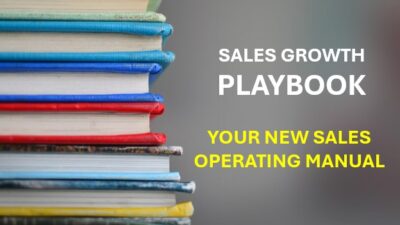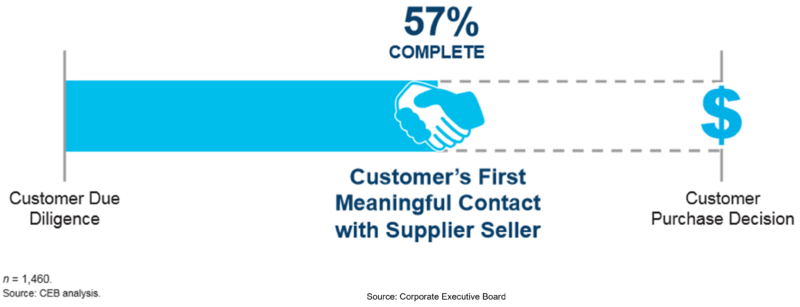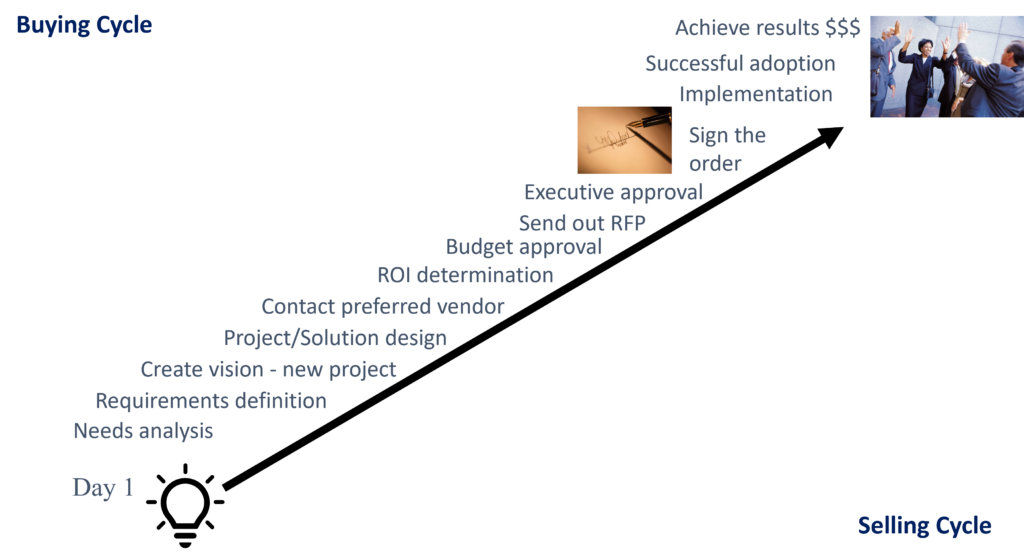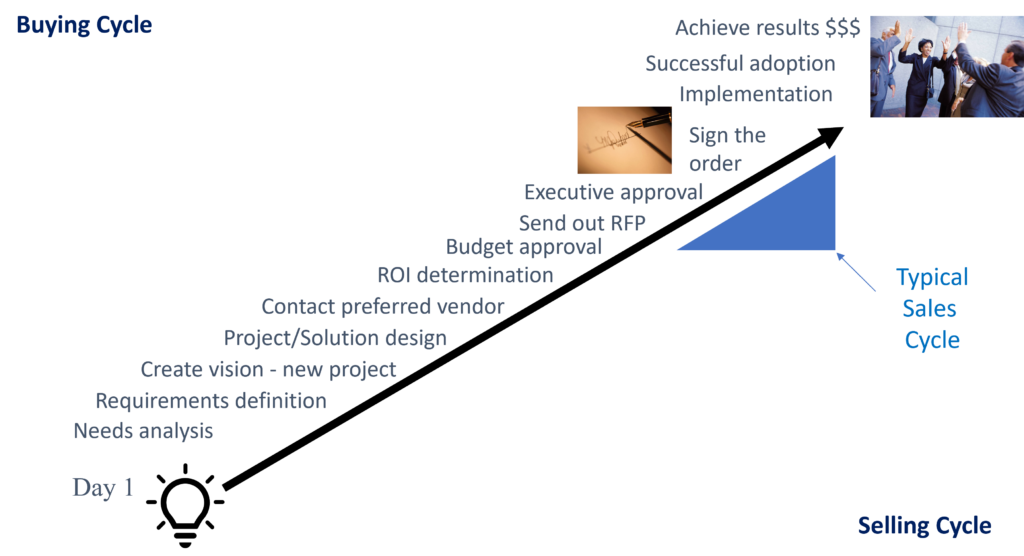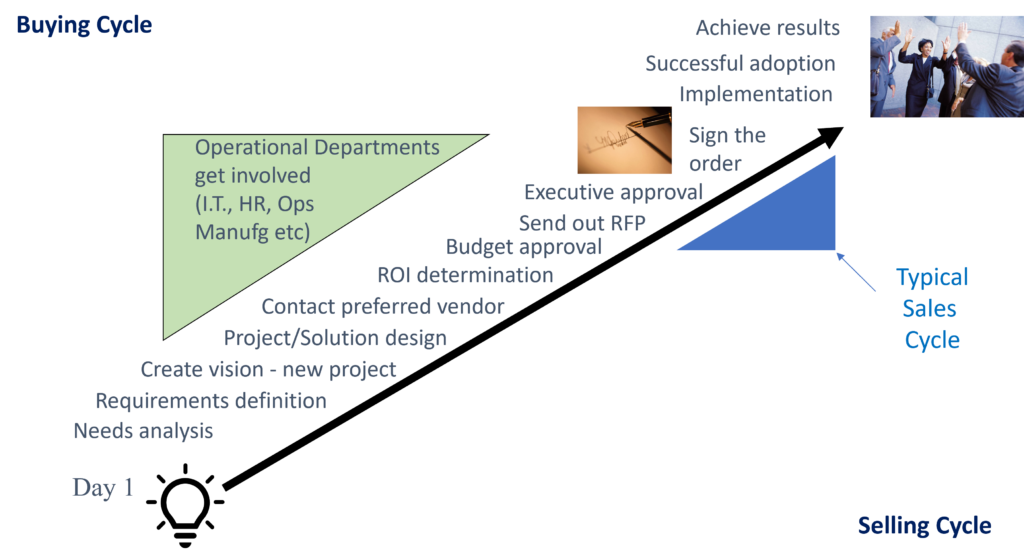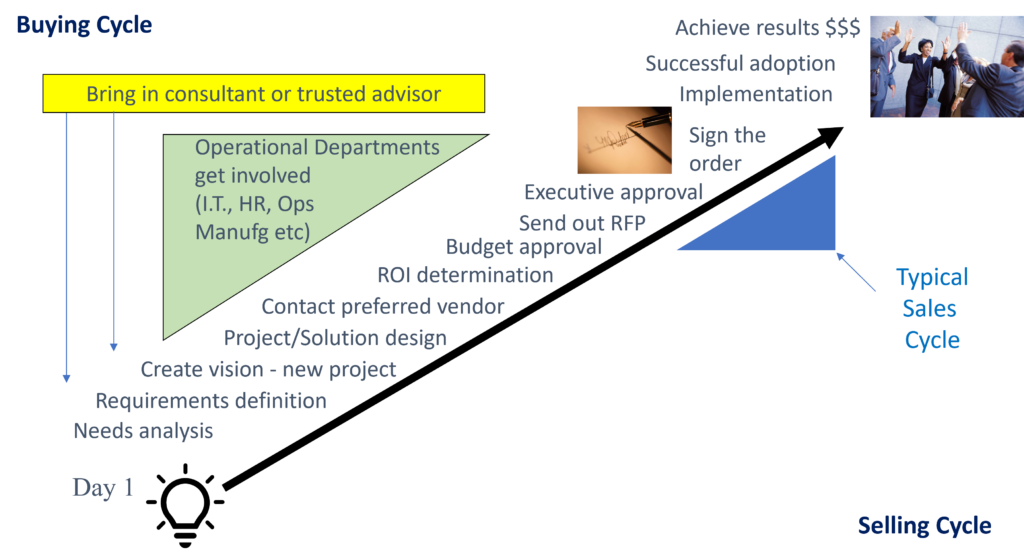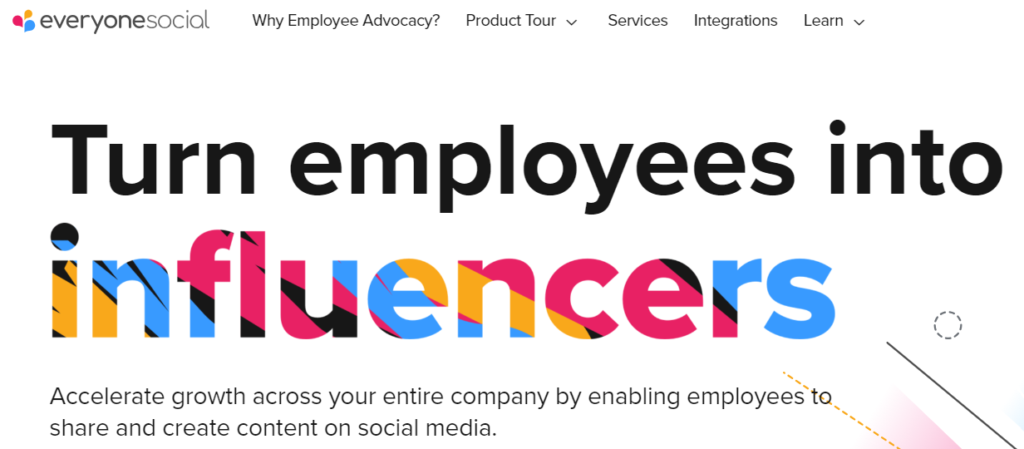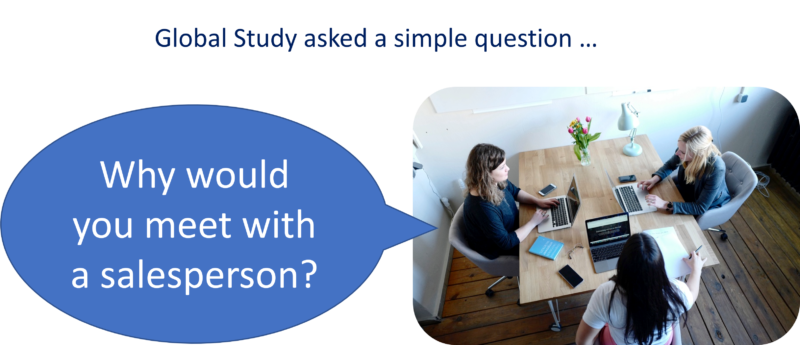Sales Growth – Workshop 1 (Growth Playbook)

The Appleton Greene Corporate Training Program (CTP) for Sales Growth is provided by Mr. Longstaffe Certified Learning Provider (CLP). Program Specifications: Monthly cost USD$2,500.00; Monthly Workshops 6 hours; Monthly Support 4 hours; Program Duration 12 months; Program orders subject to ongoing availability.
If you would like to view the Client Information Hub (CIH) for this program, please Click Here
Learning Provider Profile

Mr Longstaffe has over 30 years of global experience in Sales, Consulting, and Training. His extensive background is instrumental in enabling him to design and deliver well proven and effective sales training solutions which improve the performance of professional salespeople. His training programs provide an extremely relevant learning experience equipping participants with meaningful and applicable skills that result in their adoption, action and successful results.
Mr Longstaffe is the CEO of a company he founded in 1998. It is a sales consulting firm and training solutions provider. Mr Longstaffe specializes in developing highly effective, practical tools and processes to improve professional selling skills in B2B sales teams. In the Sales Growth Program he has built an entire portfolio of training modules, drawing on his expertise in Consultative Selling, Account Management, Channel Management, Competitive Selling, Negotiations and Tactical Selling Skills.
Mr Longstaffe has worked for large corporations and high-growth start-ups. He has led sales teams, built channel organizations and created highly effective training curricula. Mr Longstaffe also worked with Sir Winston Churchill’s grand-daughter to develop a unique training program based on the leadership principles of Sir Winston Churchill.
Mr Longstaffe has worked with clients across the globe from a wide range of industries including Information Technology, Telecoms, Aerospace, Financial Services and Healthcare. He has extensive experience in international sales, having worked in San Francisco, London and Australia.
Prior to establishing his training business, Mr Longstaffe worked at ODI as Managing Director of their UK operation. ODI was a leading consulting firm in organizational development, corporate alignment, strategy deployment, leadership, quality and customer care programs. There he led the turnaround of the UK operation, re-branding the company and launching their new software-based Alignment Diagnostic tool.
Prior to joining ODI, Mr Longstaffe was a Director of Esprit Consulting Ltd, a sales training company, based in London. He was critical in the expansion of international business and, as Director of Business Development, forged a Strategic Partnership with KPMG. He succeeded in winning significant seven figure training projects with many global IT companies, and he opened new offices in San Francisco. On his return to the UK, he managed the global operations of Esprit with responsibility for the network of Channel Partners both in the UK and Overseas.
Mr Longstaffe began his career in Sales and Management with Jardine Matheson & Co in Hong Kong. Following his graduate training program, he took his first sales role as a new business sales executive in the air cargo subsidiary, Jardine Cargo International. He won the prestigious ‘Freight Forwarder of the Year’ award in his first year in the industry and immediately became the top performing sales executive in the company, a position he maintained until being promoted to Branch Manager. He built the most profitable branch office in the UK and was appointed Regional Sales Manager on the West Coast USA.
Mr Longstaffe has an MA (Hons) and BA (Hons) from Emmanuel College, Cambridge University, UK.
MOST Analysis
Mission Statement
Our mission for the Sales Growth Program is to help you develop the necessary Consultative Selling process and skills to enable you to differentiate yourselves from your competition and to win more business. Your mission is to apply the new process and skills to achieve a lasting change in process and behavior which will enable you and your team to sustain the performance improvement long-term.
Along the way, you will learn new techniques and be introduced to new process tools which are all designed to help you achieve this goal. In this first workshop we will focus on the fundamentals of Consultative Selling, and you will start to develop your own Sales Growth Playbook. You will be adding to this playbook throughout the program so that by the end of the program you have a detailed roadmap to follow and a handbook to help you grow.
In simple terms, our mission here is to help you find new ways to grow more revenue, more profitably.
Objectives
To accomplish our mission for this first workshop, you will need to achieve the following objectives for each of the 12 modules. The specific objective for each modules are as follows, By the end of each of the modules, participants will be able to:
01. Introduction to Consultative Selling – Define what Consultative Selling will mean for you and what changes you will make to your sales process and strategy. ?Time Allocated: 1 Month
02. Getting Involved Early – Determine when you usually get involved in the customer’s buying cycle and develop ideas for getting involved earlier. ?Time Allocated: 1 Month
03. Creating Competitive Differentiation – identify new ideas?Time Allocated: 1 Month
04. Providing Insight – identify ways to provide insight to your customers through new ideas, problem solving and being more consultative.Time Allocated: 1 Month
05. The Sales Growth Playbook – create the framework for your own Playbook based on your goals.Time Allocated: 1 Month
06. Company Overview – determine what is most important in terms of your company overview and what do we need to include: key messages, and your ‘WHY?’Time Allocated: 1 Month
07. Sales Strategy and Process – produce a flow diagram to document your sales process from lead to close, with an outline defining each step. Time Allocated: 1 Month
08. Go-To- Market Strategy – define your strategy and Rules of Engagement for key components like demo’s and proof of concepts.Time Allocated: 1 Month
09. Strategic Sales Plays – define the actions required to implement each of the 3 key strategic sales plays: New, Renew, Expand. Time Allocated: 1 Month
10. Tactical Sales Plays – design a sample structure for a replicable sales play as the basis for adding more later.Time Allocated: 1 Month
11. Key Sales Metrics – agree what are the most important sales metrics, and decide how will you track and measure them.Time Allocated: 1 Month
12. Incentives and Compensation – determine whether the commission structure is effective, decide what else is needed.Time Allocated: 1 Month
Strategies
Throughout the Sales Growth Program we will be employing a consistent development methodology to provide you with the Strategies you need to accomplish the mission and goals for each workshop. This will include your active participation in the workshop combined with the required reading and preparation and a series of integrated exercises. These exercises will include:
• Individual Exercises – to challenge you to find innovate new ways to apply some of the new techniques and ideas to your own real world situation
• Team Exercises – to help you work in small groups to solve problems together and select the best solutions and ways forward to implement the new tools and techniques
• Brainstorming exercises – using whiteboards and flipcharts to share information and ideas in a collaborative team activity
• Written tasks – to help you define and record detailed processes and document a plan for the implementation
• Role-plays – to enable you to practice new ideas and skills in a safe learning environment before you try them for real with customers
• Sharing experiences – to enable everyone to learn from each other and maximize the power of team cooperation
Tasks
In this first workshop you will focus on completing the following tasks at the end of each module and within the 1 month period before the second workshop:
01. Introduction: Define what Consultative Selling means and define specific goals/actions you need to take to enhance your current sales approach. 1 Month.
02. Getting Involved Early: Determine when you usually get involved in the customer’s buying cycle and define ideas for getting involved earlier. 1 Month.
03. Creating Competitive Differentiation: using the 4 sources of differentiation discussed, define a list of actions to improve your competitive differentiation in the eyes of the customer. 1 Month.
04. 1. Providing Insight: Develop ideas for providing insight in sales meetings with current customers and prospects using the 3 types of insight discussed in this module. 1 Month.
05. Sales Growth Playbook: Develop the structure and ‘Table of Contents’ for your own Sales Growth playbook, defining the chapters and identify any external input needed. 1 Month.
06. Company Overview: Define the opening chapter of the playbook with a clearly define company story and value proposition. 1 Month.
07. Sales Strategy and Process: Produce a flow diagram to document your sales process from lead to close, with an outline defining each step. 1 Month.
08. Go-To-Market Strategy: Define your strategy and Rules of Engagement for key components of your strategy such as demo’s and proof of concepts. 1 Month.
09. Strategic Sales Plays: Define the actions required to implement each of the 3 key strategic sales plays: New, Renew, Expand. 1 Month.
10. Tactical Sales Plays: using the sample structure for a replicable sales play, complete at least one replicable tactical sales play. 1 Month.
11. Key Sales Metrics: Define your key metrics, develop a plan for data collection and highlight immediate actions required to make this an effective team metric. 1 Month.
12. Incentives and Compensation: create a 3/6/12 month plan to define what actions you will take in the next year to achieve your personal sales goals. 1 Month.
Introduction

Workshop 1 is designed to set the scene for the entire program. It will provide participants with a strong foundation on which to build their SALES GROWTH skills and processes. The workshop starts by helping participants to understand the critical importance of developing real Consultative Selling techniques which form the bedrock of the whole program.

One of the essential tenets of the program is that participants can become more successful by being more effective and more efficient in their sales process. This is possible as a result of, for example, shortening the sales cycle by aligning the sales cycle with the customer buying cycle and making sure that more is achieved in every sales meeting and customer interaction. This process starts by developing more of a focus on the customer and by looking for ways in which the participants can deliver insight and ideas which will differentiate the participants from other salespeople through the way they sell, not just through what they sell.
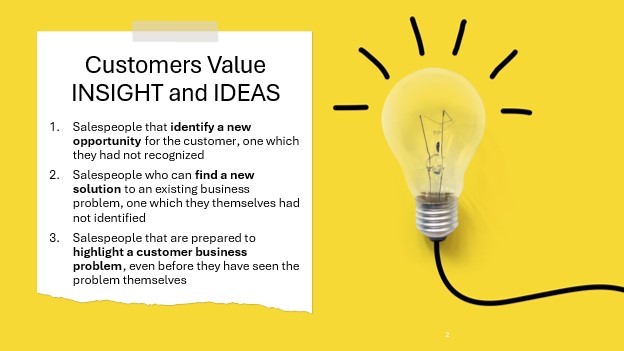
This first workshop seeks to explain why this approach is necessary and it sheds light on what can be accomplished if sales teams are able to make this transition. The rest of this workshop focuses on the development of a Sales Growth Playbook which participants will use to create their own operating manual for Sales Growth.
Each element of the Sales Growth Playbook is explained in detail. Each module provides new material and challenges existing thinking. It explains what is required and provides examples of how participants can apply these new tools and techniques to their personal sales environment. As participants move through his first workshop they are building a framework for their own Sales Growth Playbook, this then forms the basis of the Work Study which follows the workshop, so that participants will gradually develop a comprehensive Playbook of their own.
The Sales Growth Playbook starts at the high-level and then develops into Strategic Sales Plays and Tactical Sales Plays. Each of their new approaches is explained and participants will construct their own sales-plays which can be applied to improve their own sales success.
Towards the end of the first workshop, we turn our attention to Sales Metrics and Incentives. Participants are encouraged to consider new metrics which will enable them to track their progress in Consultative Selling throughout the program. The workshop concludes with a discussion on incentives and compensation to help determine whether the company has in place the right metrics, incentives and compensation structure to reward the type of behavior change which the teams are aiming to achieve.
Armed with an in-depth understanding of what a consultative approach really means, and equipped with a new Playbook to guide them, participants are ready to embrace change and motivated to build the new consultative selling techniques which are covered in detail in the subsequent workshops in the program.
Executive Summary
Chapter 1: Introduction to Consultative Selling
As the introduction to the Sales Growth program this Chapter will provide the foundation for the development of your Consultative Selling Skills and Process which will enable you to differentiate yourselves from your competition. For many salespeople, educated in a more basic, customer needs-based approach, this represents a major challenge. A traditional, ‘needs-based’ sales process assumes that the customer already knows what they need. The role of the salesperson is then simply to provide a solution to those needs. However, in that environment, salespeople can add very little value to the customer’s buying process. In fact, current research suggests that most customers have already undertaken 54% of their buying journey before they even contact a salesperson. At that point they believe they already know what they need and increasingly they are looking for a friction-less buying process, often one which can be conducted online, and does not include a salesperson at all.
A more consultative sales approach requires salespeople to get involved earlier in the buying cycle. This means developing trust with many people in the customer team, challenging them a little, helping them by providing the insight and ideas they need in order to win against their competitors. In this first Chapter we explore in more detail the characteristics of this consultative approach and what differentiates this from a traditional, product-led sales approach.

Chapter 2: Getting Involved Early
As we learned in the first Chapter, getting involved earlier in the customer buying process is a key success factor for salespeople to be effective in a consultative sales approach. The importance of this was validated in recent research by Gartner that showed that 76% of customers choose the buy from the company that first brought them the idea. Knowing this is an essential building block for your consultative selling methodology. It means you need to get involved much earlier in the buying cycle than most salespeople think. Doing this is not easy. It requires some fundamental changes in sales technique and sales process. A key part of this new strategy is to identify the parts of the customer organization where the buying cycle is actually initiated. Where is the idea born? This is usually outside the traditional target audience of the product-led salesperson. How will you identify where to start? How will you develop the credibility to be able to approach these new buyers? This Chapter focuses on what you need to do to start developing these new skills.

Chapter 3: Creating Competitive Differentiation
Much of this Sales Growth program, and the very essence of consultative selling, relates to the fact that salespeople need to start differentiating themselves from other salespeople, not through the products they sell, but through the WAY they sell. In other words, the salespeople themselves are the key differentiator.

This chapter explores the sources of competitive differentiation and looks at the way in which salespeople can influence them. It deals with the fact that some of these factors are outside the sales teams’ control, but there are things that individual professionals can do to make a difference.
In a highly competitive marketplace where customers have many valid potential suppliers to choose from, this personal, professional, differentiation can make all the difference.

Chapter 4: Providing Insight
Developing credibility with new buyers requires a different approach. The very essence of a consultative approach is that the salesperson focuses on the customer rather than on their own product. Of course, they must have the basic product knowledge, but that is a foundational requirement, not a differentiator in the eyes of the customer. Research identifies that there were 3 reasons why managers and executives in a customer organization would agree to meet with a salesperson – and wanting to learn about their products and services was not one of them! The key is that customers are looking for insight and ideas. In other words, if they want to learn about your products and services, they can simply look at your website. When they meet with a salesperson, they want to learn something new. Something they do not know already and something that they are not likely to learn from your competition.
So, the first reason they would meet with a salesperson is if they felt the salesperson could provide some new insight or ideas regarding new business opportunities for their business. This means that salespeople need to apply a forward-looking insight to consider the customer’s customer. i.e. to look beyond the immediate customer and think of ways in which that customer can improve what they do for their customers.

The second reason why a customer will meet with a salesperson is if they believe the salesperson can help them to find new solutions to an existing business problem. This requires that the salesperson has sufficient knowledge and understanding of the customer’s business, and the industry in which they operate, to be able to offer insight and ideas which go beyond what the customer might themselves have already considered. Again, if they have already thought of the solution, the salesperson is not adding any value, the customer has already identified their pain and the likely solution. They want to hear from salespeople who can provide insight by suggesting new ideas and offering different types of solution.
Consultative salespeople can do this because they have industry knowledge and insight, they develop experience and expertise in a particular industry, and they see many different companies in that industry providing them with a unique perspective which the customer themselves might lack.
The third, and more challenging reason why a customer will meet with a salesperson is if they feel that the salesperson has the potential to become a true trusted advisor. This is someone who can offer insight and ideas about their business by helping the customer to avoid potential future problems and roadblocks. Consultative salespeople can do this because they are experts in their field. The value they provide goes far beyond their products and services and lies in providing their customers which an ability to beat their competitors by being better prepared for change and being better equipped to capitalize on new opportunities.
Another factor that goes hand-in-hand with this approach is that customers only want to meet with salespeople who they believe can get things done within their own organization. This means that they need to see the salesperson as an effective virtual team leader, marshalling the resources of their company, as and when needed, to help the customer accomplish their goals.

Chapter 5: The Sales Growth Playbook
Having developed a foundational understanding of consultative selling, this Chapter will help you develop your new ‘Sales Growth Playbook’. This will include what needs to be done to include all the key stakeholders who will need to support the changes in the process and new process implementation for the sales teams. You are basically building a roadmap for change. You will add to this Sales growth Playbook throughout the course.
A Sales Growth Playbook becomes the handbook which sales teams use every day for help, advice and counsel on what they need to do to become more consultative. You will decide what specific chapters you think should be included in your Playbook and use the framework to create a Sales Growth Playbook which exactly suits your company and your industry. The following workshops will address specific sections that should be in every playbook. If your company already has a playbook this is an opportunity to re-open it, dust it off, and see if it is still valid, and to identify what updates might be needed to ensure that your Sales Growth Playbook aligns with the strategy to become a truly consultative sales organization.
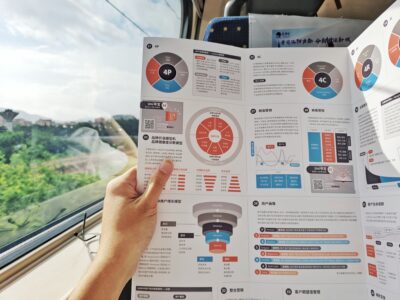
Chapter 6: Company Overview
The Sales Growth Playbook should start with a comprehensive overview of your company. Imagine trying to explain what your company does to people in a number of scenarios: How would you explain it to a sibling or a friend? How would you explain it to a stranger that you meet at a cocktail party or on a plane? How would you explain it a new contact at an existing customer, or to a senior executive in a new prospect?
This chapter seeks to get to the essence of your new consultative positioning statement. In a later workshop we will do a deeper dive into specific value propositions, but the chapter seeks to help you get grounded in the new messaging. We also explore whether you can articulate the company “WHY?” Using Simon Sinek’s simple structure, we will help you articulate the ‘WHY?’.

Chapter 7: Sales Strategy and Process
Effective sales teams follow a consistent strategy and have clearly defined processes for every part of their sales campaigns. This chapter looks at the basics of what is required and will produce the building blocks for how these processes will be developed and fine-tuned in later workshops. You will map out your current sales strategy and create flow-charts to describe the process. You will look for ways to improve these and determine whether or not you need different ‘plays’ for different types of sale. How does the process for a customer renewal differ from a sale to a new prospect? What is the sale-play for a cold-calling prospect differ from an opportunity for Expansion? These sales plays will define how the sales teams interacts with other parts of the customer-facing teams and will include inputs required from other departments such as Marketing, Customer Success and Service/Support.

Chapter 8: Go-To-Market Strategy
To what extent is your marketing strategy aligned with your new sales strategy? Is your organization still focused on selling products which will engender a commodity-based buying behavior? What needs to change? This chapter will focus on making sure that the sales teams have all the tools and support they need in order to make their move to a more consultative sales approach successful.
You will analyze your current solution-set and identify those products and services that align with the goal of providing real insight and ideas to the customer. We will review sales messaging and identify any changes in messaging which might be needed by other parts of the organization in order to better represent the consultative nature of the sales team. We will identify your best sellers in terms of products and why. We will also look to the future to include the strategy needed to lay the groundwork for new products which are coming in the future and ensure we are introducing these as insightful solutions to real customer needs, rather than simply ‘flashy’ new objects which create excitement but have a short shelf-life in terms of real competitive differentiation.

Chapter 9: Strategic Sales Plays
As you know, your Sales Growth Playbook is going to become your handbook for how to grow your sales revenue. Within the handbook, this section will focus on the Strategic Sales Plays which will help you to direct your efforts. The next section deals with more tactical plays. You can think of the two being slightly different but still closely related.

Strategic Sales plays are the major plans than will address the key fields of play in which you are going to operate. These are typically referred to as LAND, EXPAND and RENEW. The concept is that initially you have a strategy to break-in to a new account. This is your LAND strategy. When successful you will have won some business with this customer, but perhaps there is more to win later. The next Strategic Play is therefore to EXPAND your initial business to develop a higher revenue stream. This might be achieved by selling to other divisions or to new geographic areas. Having Landed and Expanded, your next strategic play is to RENEW the business that you have already won and therefore you have a Strategic Play which is focused on renewal and recommitment from the customer.
For some business this Renewal may be in the form of a 1-3 year contract renewal. For others it may be that the customer will only ‘renew’ so to speak, when they re-purchase a similar or upgraded product or solution in the future. For some businesses, the strategic play for renew is focused on securing a service contract at the end of a warranty period.

Chapter 10: Tactical Sales Plays
Tactical sales plays are more specific than Strategic plays. You will typically only have a handful of Strategic Plays, but you are likely to build dozens of these more tactical plays. If you think about this from a sporting perspective, you might have an Offence and Defence (Strategic) Play but within each of these you will have many different tactical plays based on where you are in the field and what the competition is doing.
Furthermore, your strategic plays, being more high-level, can be similar for different types of customer and the same across multiple geographies. Whereas your tactical plays are more likely to vary for each market and each product-line. You will build your sales plays to be specific to the producsta dn solutions that you are selling. You will add to them over time and these will be more likely to adapt and porph with time.

Chapter 11: Key Sales Metrics
How will you know whether you have been successful in implementing the new ideas from this Sales Growth Program? What will be your success measures? What are the KPI’s or CSF’s? The process starts by thinking about key metrics and measures that can help you ‘move the needle’ in terms of higher sales revenue. We will focus on defining key sales goals: beyond simply sales revenue. It takes time to make significant changes in behavior and even longer for those changes to bear fruit in terms of increased revenue.  Of course, increased revenue and higher profitability are the ultimate goals but using these measures to track our growth toward the future is like driving by looking in the rear-view mirror. They tell us what has happened in the past, but they are lagging indicators. We want to identify some ‘leading indicators’ that can give us a better indication that we are on the right track.
Of course, increased revenue and higher profitability are the ultimate goals but using these measures to track our growth toward the future is like driving by looking in the rear-view mirror. They tell us what has happened in the past, but they are lagging indicators. We want to identify some ‘leading indicators’ that can give us a better indication that we are on the right track.
You will develop some new measures for yourselves. These might include things like shorter sales cycles, closing higher value deals, winning more repeat business, expanding sales territories, launching new products, selling high and wide within large accounts, developing an effective ‘land and expand’ strategy or breaking into new accounts. The output from this project study is a Sales Growth Playbook which will guide you on your sales development journey.

Chapter 12: Incentives and Compensation
There is an old adage that says “What you measure, is what you get”. This is never more true than when you consider the way in which salespeople are measured and compensated. In sales, this translates to “salespeople sell what they are paid to sell”. Therefore, getting the sales compensation element right is critical to any effective change management process aimed at successfully helping a sales organization to make the transition from being a product-focused sales team to being more consultative. For example, there is no point in asking, or telling, sales teams to sell larger deals and to be more consultative, and then continue to pay them to make small, transactional sales at a commodity level. This chapter seeks to analyze what is really motivating the salespeople and how you can adapt the compensation plan to support the changes in sales behavior that you are trying to make. In this final Chapter in the initial workshop, we will focus on fine-tuning your sales compensation and sales incentives to encourage the sales behavior that you want to see.
Curriculum
Sales Growth – Workshop 1– Growth Playbook
- Introduction to Consultative Selling
- Getting Involved Early
- Creating Competitive Differentiation
- Providing Insight
- The Sales Growth Playbook
- Company Overview
- Sales Strategy and Process
- Go-To-Market Strategy
- Strategic Sales Plays
- Tactical Sales Plays
- Key Sales Metrics
- Incentives and Compensation
Distance Learning
Introduction
Welcome to Appleton Greene and thank you for enrolling on the Sales Growth corporate training program. You will be learning through our unique facilitation via distance-learning method, which will enable you to practically implement everything that you learn academically. The methods and materials used in your program have been designed and developed to ensure that you derive the maximum benefits and enjoyment possible. We hope that you find the program challenging and fun to do. However, if you have never been a distance-learner before, you may be experiencing some trepidation at the task before you. So we will get you started by giving you some basic information and guidance on how you can make the best use of the modules, how you should manage the materials and what you should be doing as you work through them. This guide is designed to point you in the right direction and help you to become an effective distance-learner. Take a few hours or so to study this guide and your guide to tutorial support for students, while making notes, before you start to study in earnest.
Study environment
You will need to locate a quiet and private place to study, preferably a room where you can easily be isolated from external disturbances or distractions. Make sure the room is well-lit and incorporates a relaxed, pleasant feel. If you can spoil yourself within your study environment, you will have much more of a chance to ensure that you are always in the right frame of mind when you do devote time to study. For example, a nice fire, the ability to play soft soothing background music, soft but effective lighting, perhaps a nice view if possible and a good size desk with a comfortable chair. Make sure that your family know when you are studying and understand your study rules. Your study environment is very important. The ideal situation, if at all possible, is to have a separate study, which can be devoted to you. If this is not possible then you will need to pay a lot more attention to developing and managing your study schedule, because it will affect other people as well as yourself. The better your study environment, the more productive you will be.
Study tools & rules
Try and make sure that your study tools are sufficient and in good working order. You will need to have access to a computer, scanner and printer, with access to the internet. You will need a very comfortable chair, which supports your lower back, and you will need a good filing system. It can be very frustrating if you are spending valuable study time trying to fix study tools that are unreliable, or unsuitable for the task. Make sure that your study tools are up to date. You will also need to consider some study rules. Some of these rules will apply to you and will be intended to help you to be more disciplined about when and how you study. This distance-learning guide will help you and after you have read it you can put some thought into what your study rules should be. You will also need to negotiate some study rules for your family, friends or anyone who lives with you. They too will need to be disciplined in order to ensure that they can support you while you study. It is important to ensure that your family and friends are an integral part of your study team. Having their support and encouragement can prove to be a crucial contribution to your successful completion of the program. Involve them in as much as you can.
Successful distance-learning
Distance-learners are freed from the necessity of attending regular classes or workshops, since they can study in their own way, at their own pace and for their own purposes. But unlike traditional internal training courses, it is the student’s responsibility, with a distance-learning program, to ensure that they manage their own study contribution. This requires strong self-discipline and self-motivation skills and there must be a clear will to succeed. Those students who are used to managing themselves, are good at managing others and who enjoy working in isolation, are more likely to be good distance-learners. It is also important to be aware of the main reasons why you are studying and of the main objectives that you are hoping to achieve as a result. You will need to remind yourself of these objectives at times when you need to motivate yourself. Never lose sight of your long-term goals and your short-term objectives. There is nobody available here to pamper you, or to look after you, or to spoon-feed you with information, so you will need to find ways to encourage and appreciate yourself while you are studying. Make sure that you chart your study progress, so that you can be sure of your achievements and re-evaluate your goals and objectives regularly.
Self-assessment
Appleton Greene training programs are in all cases post-graduate programs. Consequently, you should already have obtained a business-related degree and be an experienced learner. You should therefore already be aware of your study strengths and weaknesses. For example, which time of the day are you at your most productive? Are you a lark or an owl? What study methods do you respond to the most? Are you a consistent learner? How do you discipline yourself? How do you ensure that you enjoy yourself while studying? It is important to understand yourself as a learner and so some self-assessment early on will be necessary if you are to apply yourself correctly. Perform a SWOT analysis on yourself as a student. List your internal strengths and weaknesses as a student and your external opportunities and threats. This will help you later on when you are creating a study plan. You can then incorporate features within your study plan that can ensure that you are playing to your strengths, while compensating for your weaknesses. You can also ensure that you make the most of your opportunities, while avoiding the potential threats to your success.
Accepting responsibility as a student
Training programs invariably require a significant investment, both in terms of what they cost and in the time that you need to contribute to study and the responsibility for successful completion of training programs rests entirely with the student. This is never more apparent than when a student is learning via distance-learning. Accepting responsibility as a student is an important step towards ensuring that you can successfully complete your training program. It is easy to instantly blame other people or factors when things go wrong. But the fact of the matter is that if a failure is your failure, then you have the power to do something about it, it is entirely in your own hands. If it is always someone else’s failure, then you are powerless to do anything about it. All students study in entirely different ways, this is because we are all individuals and what is right for one student, is not necessarily right for another. In order to succeed, you will have to accept personal responsibility for finding a way to plan, implement and manage a personal study plan that works for you. If you do not succeed, you only have yourself to blame.
Planning
By far the most critical contribution to stress, is the feeling of not being in control. In the absence of planning we tend to be reactive and can stumble from pillar to post in the hope that things will turn out fine in the end. Invariably they don’t! In order to be in control, we need to have firm ideas about how and when we want to do things. We also need to consider as many possible eventualities as we can, so that we are prepared for them when they happen. Prescriptive Change, is far easier to manage and control, than Emergent Change. The same is true with distance-learning. It is much easier and much more enjoyable, if you feel that you are in control and that things are going to plan. Even when things do go wrong, you are prepared for them and can act accordingly without any unnecessary stress. It is important therefore that you do take time to plan your studies properly.
Management
Once you have developed a clear study plan, it is of equal importance to ensure that you manage the implementation of it. Most of us usually enjoy planning, but it is usually during implementation when things go wrong. Targets are not met and we do not understand why. Sometimes we do not even know if targets are being met. It is not enough for us to conclude that the study plan just failed. If it is failing, you will need to understand what you can do about it. Similarly if your study plan is succeeding, it is still important to understand why, so that you can improve upon your success. You therefore need to have guidelines for self-assessment so that you can be consistent with performance improvement throughout the program. If you manage things correctly, then your performance should constantly improve throughout the program.
Study objectives & tasks
The first place to start is developing your program objectives. These should feature your reasons for undertaking the training program in order of priority. Keep them succinct and to the point in order to avoid confusion. Do not just write the first things that come into your head because they are likely to be too similar to each other. Make a list of possible departmental headings, such as: Customer Service; E-business; Finance; Globalization; Human Resources; Technology; Legal; Management; Marketing and Production. Then brainstorm for ideas by listing as many things that you want to achieve under each heading and later re-arrange these things in order of priority. Finally, select the top item from each department heading and choose these as your program objectives. Try and restrict yourself to five because it will enable you to focus clearly. It is likely that the other things that you listed will be achieved if each of the top objectives are achieved. If this does not prove to be the case, then simply work through the process again.
Study forecast
As a guide, the Appleton Greene Sales Growth corporate training program should take 12-18 months to complete, depending upon your availability and current commitments. The reason why there is such a variance in time estimates is because every student is an individual, with differing productivity levels and different commitments. These differentiations are then exaggerated by the fact that this is a distance-learning program, which incorporates the practical integration of academic theory as an as a part of the training program. Consequently all of the project studies are real, which means that important decisions and compromises need to be made. You will want to get things right and will need to be patient with your expectations in order to ensure that they are. We would always recommend that you are prudent with your own task and time forecasts, but you still need to develop them and have a clear indication of what are realistic expectations in your case. With reference to your time planning: consider the time that you can realistically dedicate towards study with the program every week; calculate how long it should take you to complete the program, using the guidelines featured here; then break the program down into logical modules and allocate a suitable proportion of time to each of them, these will be your milestones; you can create a time plan by using a spreadsheet on your computer, or a personal organizer such as MS Outlook, you could also use a financial forecasting software; break your time forecasts down into manageable chunks of time, the more specific you can be, the more productive and accurate your time management will be; finally, use formulas where possible to do your time calculations for you, because this will help later on when your forecasts need to change in line with actual performance. With reference to your task planning: refer to your list of tasks that need to be undertaken in order to achieve your program objectives; with reference to your time plan, calculate when each task should be implemented; remember that you are not estimating when your objectives will be achieved, but when you will need to focus upon implementing the corresponding tasks; you also need to ensure that each task is implemented in conjunction with the associated training modules which are relevant; then break each single task down into a list of specific to do’s, say approximately ten to do’s for each task and enter these into your study plan; once again you could use MS Outlook to incorporate both your time and task planning and this could constitute your study plan; you could also use a project management software like MS Project. You should now have a clear and realistic forecast detailing when you can expect to be able to do something about undertaking the tasks to achieve your program objectives.
Performance management
It is one thing to develop your study forecast, it is quite another to monitor your progress. Ultimately it is less important whether you achieve your original study forecast and more important that you update it so that it constantly remains realistic in line with your performance. As you begin to work through the program, you will begin to have more of an idea about your own personal performance and productivity levels as a distance-learner. Once you have completed your first study module, you should re-evaluate your study forecast for both time and tasks, so that they reflect your actual performance level achieved. In order to achieve this you must first time yourself while training by using an alarm clock. Set the alarm for hourly intervals and make a note of how far you have come within that time. You can then make a note of your actual performance on your study plan and then compare your performance against your forecast. Then consider the reasons that have contributed towards your performance level, whether they are positive or negative and make a considered adjustment to your future forecasts as a result. Given time, you should start achieving your forecasts regularly.
With reference to time management: time yourself while you are studying and make a note of the actual time taken in your study plan; consider your successes with time-efficiency and the reasons for the success in each case and take this into consideration when reviewing future time planning; consider your failures with time-efficiency and the reasons for the failures in each case and take this into consideration when reviewing future time planning; re-evaluate your study forecast in relation to time planning for the remainder of your training program to ensure that you continue to be realistic about your time expectations. You need to be consistent with your time management, otherwise you will never complete your studies. This will either be because you are not contributing enough time to your studies, or you will become less efficient with the time that you do allocate to your studies. Remember, if you are not in control of your studies, they can just become yet another cause of stress for you.
With reference to your task management: time yourself while you are studying and make a note of the actual tasks that you have undertaken in your study plan; consider your successes with task-efficiency and the reasons for the success in each case; take this into consideration when reviewing future task planning; consider your failures with task-efficiency and the reasons for the failures in each case and take this into consideration when reviewing future task planning; re-evaluate your study forecast in relation to task planning for the remainder of your training program to ensure that you continue to be realistic about your task expectations. You need to be consistent with your task management, otherwise you will never know whether you are achieving your program objectives or not.
Keeping in touch
You will have access to qualified and experienced professors and tutors who are responsible for providing tutorial support for your particular training program. So don’t be shy about letting them know how you are getting on. We keep electronic records of all tutorial support emails so that professors and tutors can review previous correspondence before considering an individual response. It also means that there is a record of all communications between you and your professors and tutors and this helps to avoid any unnecessary duplication, misunderstanding, or misinterpretation. If you have a problem relating to the program, share it with them via email. It is likely that they have come across the same problem before and are usually able to make helpful suggestions and steer you in the right direction. To learn more about when and how to use tutorial support, please refer to the Tutorial Support section of this student information guide. This will help you to ensure that you are making the most of tutorial support that is available to you and will ultimately contribute towards your success and enjoyment with your training program.
Work colleagues and family
You should certainly discuss your program study progress with your colleagues, friends and your family. Appleton Greene training programs are very practical. They require you to seek information from other people, to plan, develop and implement processes with other people and to achieve feedback from other people in relation to viability and productivity. You will therefore have plenty of opportunities to test your ideas and enlist the views of others. People tend to be sympathetic towards distance-learners, so don’t bottle it all up in yourself. Get out there and share it! It is also likely that your family and colleagues are going to benefit from your labors with the program, so they are likely to be much more interested in being involved than you might think. Be bold about delegating work to those who might benefit themselves. This is a great way to achieve understanding and commitment from people who you may later rely upon for process implementation. Share your experiences with your friends and family.
Making it relevant
The key to successful learning is to make it relevant to your own individual circumstances. At all times you should be trying to make bridges between the content of the program and your own situation. Whether you achieve this through quiet reflection or through interactive discussion with your colleagues, client partners or your family, remember that it is the most important and rewarding aspect of translating your studies into real self-improvement. You should be clear about how you want the program to benefit you. This involves setting clear study objectives in relation to the content of the course in terms of understanding, concepts, completing research or reviewing activities and relating the content of the modules to your own situation. Your objectives may understandably change as you work through the program, in which case you should enter the revised objectives on your study plan so that you have a permanent reminder of what you are trying to achieve, when and why.
Distance-learning check-list
Prepare your study environment, your study tools and rules.
Undertake detailed self-assessment in terms of your ability as a learner.
Create a format for your study plan.
Consider your study objectives and tasks.
Create a study forecast.
Assess your study performance.
Re-evaluate your study forecast.
Be consistent when managing your study plan.
Use your Appleton Greene Certified Learning Provider (CLP) for tutorial support.
Make sure you keep in touch with those around you.
Tutorial Support
Programs
Appleton Greene uses standard and bespoke corporate training programs as vessels to transfer business process improvement knowledge into the heart of our clients’ organizations. Each individual program focuses upon the implementation of a specific business process, which enables clients to easily quantify their return on investment. There are hundreds of established Appleton Greene corporate training products now available to clients within customer services, e-business, finance, globalization, human resources, information technology, legal, management, marketing and production. It does not matter whether a client’s employees are located within one office, or an unlimited number of international offices, we can still bring them together to learn and implement specific business processes collectively. Our approach to global localization enables us to provide clients with a truly international service with that all important personal touch. Appleton Greene corporate training programs can be provided virtually or locally and they are all unique in that they individually focus upon a specific business function. They are implemented over a sustainable period of time and professional support is consistently provided by qualified learning providers and specialist consultants.
Support available
You will have a designated Certified Learning Provider (CLP) and an Accredited Consultant and we encourage you to communicate with them as much as possible. In all cases tutorial support is provided online because we can then keep a record of all communications to ensure that tutorial support remains consistent. You would also be forwarding your work to the tutorial support unit for evaluation and assessment. You will receive individual feedback on all of the work that you undertake on a one-to-one basis, together with specific recommendations for anything that may need to be changed in order to achieve a pass with merit or a pass with distinction and you then have as many opportunities as you may need to re-submit project studies until they meet with the required standard. Consequently the only reason that you should really fail (CLP) is if you do not do the work. It makes no difference to us whether a student takes 12 months or 18 months to complete the program, what matters is that in all cases the same quality standard will have been achieved.
Support Process
Please forward all of your future emails to the designated (CLP) Tutorial Support Unit email address that has been provided and please do not duplicate or copy your emails to other AGC email accounts as this will just cause unnecessary administration. Please note that emails are always answered as quickly as possible but you will need to allow a period of up to 20 business days for responses to general tutorial support emails during busy periods, because emails are answered strictly within the order in which they are received. You will also need to allow a period of up to 30 business days for the evaluation and assessment of project studies. This does not include weekends or public holidays. Please therefore kindly allow for this within your time planning. All communications are managed online via email because it enables tutorial service support managers to review other communications which have been received before responding and it ensures that there is a copy of all communications retained on file for future reference. All communications will be stored within your personal (CLP) study file here at Appleton Greene throughout your designated study period. If you need any assistance or clarification at any time, please do not hesitate to contact us by forwarding an email and remember that we are here to help. If you have any questions, please list and number your questions succinctly and you can then be sure of receiving specific answers to each and every query.
Time Management
It takes approximately 1 Year to complete the Sales Growth corporate training program, incorporating 12 x 6-hour monthly workshops. Each student will also need to contribute approximately 4 hours per week over 1 Year of their personal time. Students can study from home or work at their own pace and are responsible for managing their own study plan. There are no formal examinations and students are evaluated and assessed based upon their project study submissions, together with the quality of their internal analysis and supporting documents. They can contribute more time towards study when they have the time to do so and can contribute less time when they are busy. All students tend to be in full time employment while studying and the Sales Growth program is purposely designed to accommodate this, so there is plenty of flexibility in terms of time management. It makes no difference to us at Appleton Greene, whether individuals take 12-18 months to complete this program. What matters is that in all cases the same standard of quality will have been achieved with the standard and bespoke programs that have been developed.
Distance Learning Guide
The distance learning guide should be your first port of call when starting your training program. It will help you when you are planning how and when to study, how to create the right environment and how to establish the right frame of mind. If you can lay the foundations properly during the planning stage, then it will contribute to your enjoyment and productivity while training later. The guide helps to change your lifestyle in order to accommodate time for study and to cultivate good study habits. It helps you to chart your progress so that you can measure your performance and achieve your goals. It explains the tools that you will need for study and how to make them work. It also explains how to translate academic theory into practical reality. Spend some time now working through your distance learning guide and make sure that you have firm foundations in place so that you can make the most of your distance learning program. There is no requirement for you to attend training workshops or classes at Appleton Greene offices. The entire program is undertaken online, program course manuals and project studies are administered via the Appleton Greene web site and via email, so you are able to study at your own pace and in the comfort of your own home or office as long as you have a computer and access to the internet.
How To Study
The how to study guide provides students with a clear understanding of the Appleton Greene facilitation via distance learning training methods and enables students to obtain a clear overview of the training program content. It enables students to understand the step-by-step training methods used by Appleton Greene and how course manuals are integrated with project studies. It explains the research and development that is required and the need to provide evidence and references to support your statements. It also enables students to understand precisely what will be required of them in order to achieve a pass with merit and a pass with distinction for individual project studies and provides useful guidance on how to be innovative and creative when developing your Unique Program Proposition (UPP).
Tutorial Support
Tutorial support for the Appleton Greene Sales Growth corporate training program is provided online either through the Appleton Greene Client Support Portal (CSP), or via email. All tutorial support requests are facilitated by a designated Program Administration Manager (PAM). They are responsible for deciding which professor or tutor is the most appropriate option relating to the support required and then the tutorial support request is forwarded onto them. Once the professor or tutor has completed the tutorial support request and answered any questions that have been asked, this communication is then returned to the student via email by the designated Program Administration Manager (PAM). This enables all tutorial support, between students, professors and tutors, to be facilitated by the designated Program Administration Manager (PAM) efficiently and securely through the email account. You will therefore need to allow a period of up to 20 business days for responses to general support queries and up to 30 business days for the evaluation and assessment of project studies, because all tutorial support requests are answered strictly within the order in which they are received. This does not include weekends or public holidays. Consequently you need to put some thought into the management of your tutorial support procedure in order to ensure that your study plan is feasible and to obtain the maximum possible benefit from tutorial support during your period of study. Please retain copies of your tutorial support emails for future reference. Please ensure that ALL of your tutorial support emails are set out using the format as suggested within your guide to tutorial support. Your tutorial support emails need to be referenced clearly to the specific part of the course manual or project study which you are working on at any given time. You also need to list and number any questions that you would like to ask, up to a maximum of five questions within each tutorial support email. Remember the more specific you can be with your questions the more specific your answers will be too and this will help you to avoid any unnecessary misunderstanding, misinterpretation, or duplication. The guide to tutorial support is intended to help you to understand how and when to use support in order to ensure that you get the most out of your training program. Appleton Greene training programs are designed to enable you to do things for yourself. They provide you with a structure or a framework and we use tutorial support to facilitate students while they practically implement what they learn. In other words, we are enabling students to do things for themselves. The benefits of distance learning via facilitation are considerable and are much more sustainable in the long-term than traditional short-term knowledge sharing programs. Consequently you should learn how and when to use tutorial support so that you can maximize the benefits from your learning experience with Appleton Greene. This guide describes the purpose of each training function and how to use them and how to use tutorial support in relation to each aspect of the training program. It also provides useful tips and guidance with regard to best practice.
Tutorial Support Tips
Students are often unsure about how and when to use tutorial support with Appleton Greene. This Tip List will help you to understand more about how to achieve the most from using tutorial support. Refer to it regularly to ensure that you are continuing to use the service properly. Tutorial support is critical to the success of your training experience, but it is important to understand when and how to use it in order to maximize the benefit that you receive. It is no coincidence that those students who succeed are those that learn how to be positive, proactive and productive when using tutorial support.
Be positive and friendly with your tutorial support emails
Remember that if you forward an email to the tutorial support unit, you are dealing with real people. “Do unto others as you would expect others to do unto you”. If you are positive, complimentary and generally friendly in your emails, you will generate a similar response in return. This will be more enjoyable, productive and rewarding for you in the long-term.
Think about the impression that you want to create
Every time that you communicate, you create an impression, which can be either positive or negative, so put some thought into the impression that you want to create. Remember that copies of all tutorial support emails are stored electronically and tutors will always refer to prior correspondence before responding to any current emails. Over a period of time, a general opinion will be arrived at in relation to your character, attitude and ability. Try to manage your own frustrations, mood swings and temperament professionally, without involving the tutorial support team. Demonstrating frustration or a lack of patience is a weakness and will be interpreted as such. The good thing about communicating in writing, is that you will have the time to consider your content carefully, you can review it and proof-read it before sending your email to Appleton Greene and this should help you to communicate more professionally, consistently and to avoid any unnecessary knee-jerk reactions to individual situations as and when they may arise. Please also remember that the CLP Tutorial Support Unit will not just be responsible for evaluating and assessing the quality of your work, they will also be responsible for providing recommendations to other learning providers and to client contacts within the Appleton Greene global client network, so do be in control of your own emotions and try to create a good impression.
Remember that quality is preferred to quantity
Please remember that when you send an email to the tutorial support team, you are not using Twitter or Text Messaging. Try not to forward an email every time that you have a thought. This will not prove to be productive either for you or for the tutorial support team. Take time to prepare your communications properly, as if you were writing a professional letter to a business colleague and make a list of queries that you are likely to have and then incorporate them within one email, say once every month, so that the tutorial support team can understand more about context, application and your methodology for study. Get yourself into a consistent routine with your tutorial support requests and use the tutorial support template provided with ALL of your emails. The (CLP) Tutorial Support Unit will not spoon-feed you with information. They need to be able to evaluate and assess your tutorial support requests carefully and professionally.
Be specific about your questions in order to receive specific answers
Try not to write essays by thinking as you are writing tutorial support emails. The tutorial support unit can be unclear about what in fact you are asking, or what you are looking to achieve. Be specific about asking questions that you want answers to. Number your questions. You will then receive specific answers to each and every question. This is the main purpose of tutorial support via email.
Keep a record of your tutorial support emails
It is important that you keep a record of all tutorial support emails that are forwarded to you. You can then refer to them when necessary and it avoids any unnecessary duplication, misunderstanding, or misinterpretation.
Individual training workshops or telephone support
Please be advised that Appleton Greene does not provide separate or individual tutorial support meetings, workshops, or provide telephone support for individual students. Appleton Greene is an equal opportunities learning and service provider and we are therefore understandably bound to treat all students equally. We cannot therefore broker special financial or study arrangements with individual students regardless of the circumstances. All tutorial support is provided online and this enables Appleton Greene to keep a record of all communications between students, professors and tutors on file for future reference, in accordance with our quality management procedure and your terms and conditions of enrolment. All tutorial support is provided online via email because it enables us to have time to consider support content carefully, it ensures that you receive a considered and detailed response to your queries. You can number questions that you would like to ask, which relate to things that you do not understand or where clarification may be required. You can then be sure of receiving specific answers to each individual query. You will also then have a record of these communications and of all tutorial support, which has been provided to you. This makes tutorial support administration more productive by avoiding any unnecessary duplication, misunderstanding, or misinterpretation.
Tutorial Support Email Format
You should use this tutorial support format if you need to request clarification or assistance while studying with your training program. Please note that ALL of your tutorial support request emails should use the same format. You should therefore set up a standard email template, which you can then use as and when you need to. Emails that are forwarded to Appleton Greene, which do not use the following format, may be rejected and returned to you by the (CLP) Program Administration Manager. A detailed response will then be forwarded to you via email usually within 20 business days of receipt for general support queries and 30 business days for the evaluation and assessment of project studies. This does not include weekends or public holidays. Your tutorial support request, together with the corresponding TSU reply, will then be saved and stored within your electronic TSU file at Appleton Greene for future reference.
Subject line of your email
Please insert: Appleton Greene (CLP) Tutorial Support Request: (Your Full Name) (Date), within the subject line of your email.
Main body of your email
Please insert:
1. Appleton Greene Certified Learning Provider (CLP) Tutorial Support Request
2. Your Full Name
3. Date of TS request
4. Preferred email address
5. Backup email address
6. Course manual page name or number (reference)
7. Project study page name or number (reference)
Subject of enquiry
Please insert a maximum of 50 words (please be succinct)
Briefly outline the subject matter of your inquiry, or what your questions relate to.
Question 1
Maximum of 50 words (please be succinct)
Maximum of 50 words (please be succinct)
Question 3
Maximum of 50 words (please be succinct)
Question 4
Maximum of 50 words (please be succinct)
Question 5
Maximum of 50 words (please be succinct)
Please note that a maximum of 5 questions is permitted with each individual tutorial support request email.
Procedure
* List the questions that you want to ask first, then re-arrange them in order of priority. Make sure that you reference them, where necessary, to the course manuals or project studies.
* Make sure that you are specific about your questions and number them. Try to plan the content within your emails to make sure that it is relevant.
* Make sure that your tutorial support emails are set out correctly, using the Tutorial Support Email Format provided here.
* Save a copy of your email and incorporate the date sent after the subject title. Keep your tutorial support emails within the same file and in date order for easy reference.
* Allow up to 20 business days for a response to general tutorial support emails and up to 30 business days for the evaluation and assessment of project studies, because detailed individual responses will be made in all cases and tutorial support emails are answered strictly within the order in which they are received.
* Emails can and do get lost. So if you have not received a reply within the appropriate time, forward another copy or a reminder to the tutorial support unit to be sure that it has been received but do not forward reminders unless the appropriate time has elapsed.
* When you receive a reply, save it immediately featuring the date of receipt after the subject heading for easy reference. In most cases the tutorial support unit replies to your questions individually, so you will have a record of the questions that you asked as well as the answers offered. With project studies however, separate emails are usually forwarded by the tutorial support unit, so do keep a record of your own original emails as well.
* Remember to be positive and friendly in your emails. You are dealing with real people who will respond to the same things that you respond to.
* Try not to repeat questions that have already been asked in previous emails. If this happens the tutorial support unit will probably just refer you to the appropriate answers that have already been provided within previous emails.
* If you lose your tutorial support email records you can write to Appleton Greene to receive a copy of your tutorial support file, but a separate administration charge may be levied for this service.
How To Study
Your Certified Learning Provider (CLP) and Accredited Consultant can help you to plan a task list for getting started so that you can be clear about your direction and your priorities in relation to your training program. It is also a good way to introduce yourself to the tutorial support team.
Planning your study environment
Your study conditions are of great importance and will have a direct effect on how much you enjoy your training program. Consider how much space you will have, whether it is comfortable and private and whether you are likely to be disturbed. The study tools and facilities at your disposal are also important to the success of your distance-learning experience. Your tutorial support unit can help with useful tips and guidance, regardless of your starting position. It is important to get this right before you start working on your training program.
Planning your program objectives
It is important that you have a clear list of study objectives, in order of priority, before you start working on your training program. Your tutorial support unit can offer assistance here to ensure that your study objectives have been afforded due consideration and priority.
Planning how and when to study
Distance-learners are freed from the necessity of attending regular classes, since they can study in their own way, at their own pace and for their own purposes. This approach is designed to let you study efficiently away from the traditional classroom environment. It is important however, that you plan how and when to study, so that you are making the most of your natural attributes, strengths and opportunities. Your tutorial support unit can offer assistance and useful tips to ensure that you are playing to your strengths.
Planning your study tasks
You should have a clear understanding of the study tasks that you should be undertaking and the priority associated with each task. These tasks should also be integrated with your program objectives. The distance learning guide and the guide to tutorial support for students should help you here, but if you need any clarification or assistance, please contact your tutorial support unit.
Planning your time
You will need to allocate specific times during your calendar when you intend to study if you are to have a realistic chance of completing your program on time. You are responsible for planning and managing your own study time, so it is important that you are successful with this. Your tutorial support unit can help you with this if your time plan is not working.
Keeping in touch
Consistency is the key here. If you communicate too frequently in short bursts, or too infrequently with no pattern, then your management ability with your studies will be questioned, both by you and by your tutorial support unit. It is obvious when a student is in control and when one is not and this will depend how able you are at sticking with your study plan. Inconsistency invariably leads to in-completion.
Charting your progress
Your tutorial support team can help you to chart your own study progress. Refer to your distance learning guide for further details.
Making it work
To succeed, all that you will need to do is apply yourself to undertaking your training program and interpreting it correctly. Success or failure lies in your hands and your hands alone, so be sure that you have a strategy for making it work. Your Certified Learning Provider (CLP) and Accredited Consultant can guide you through the process of program planning, development and implementation.
Reading methods
Interpretation is often unique to the individual but it can be improved and even quantified by implementing consistent interpretation methods. Interpretation can be affected by outside interference such as family members, TV, or the Internet, or simply by other thoughts which are demanding priority in our minds. One thing that can improve our productivity is using recognized reading methods. This helps us to focus and to be more structured when reading information for reasons of importance, rather than relaxation.
Speed reading
When reading through course manuals for the first time, subconsciously set your reading speed to be just fast enough that you cannot dwell on individual words or tables. With practice, you should be able to read an A4 sheet of paper in one minute. You will not achieve much in the way of a detailed understanding, but your brain will retain a useful overview. This overview will be important later on and will enable you to keep individual issues in perspective with a more generic picture because speed reading appeals to the memory part of the brain. Do not worry about what you do or do not remember at this stage.
Content reading
Once you have speed read everything, you can then start work in earnest. You now need to read a particular section of your course manual thoroughly, by making detailed notes while you read. This process is called Content Reading and it will help to consolidate your understanding and interpretation of the information that has been provided.
Making structured notes on the course manuals
When you are content reading, you should be making detailed notes, which are both structured and informative. Make these notes in a MS Word document on your computer, because you can then amend and update these as and when you deem it to be necessary. List your notes under three headings: 1. Interpretation – 2. Questions – 3. Tasks. The purpose of the 1st section is to clarify your interpretation by writing it down. The purpose of the 2nd section is to list any questions that the issue raises for you. The purpose of the 3rd section is to list any tasks that you should undertake as a result. Anyone who has graduated with a business-related degree should already be familiar with this process.
Organizing structured notes separately
You should then transfer your notes to a separate study notebook, preferably one that enables easy referencing, such as a MS Word Document, a MS Excel Spreadsheet, a MS Access Database, or a personal organizer on your cell phone. Transferring your notes allows you to have the opportunity of cross-checking and verifying them, which assists considerably with understanding and interpretation. You will also find that the better you are at doing this, the more chance you will have of ensuring that you achieve your study objectives.
Question your understanding
Do challenge your understanding. Explain things to yourself in your own words by writing things down.
Clarifying your understanding
If you are at all unsure, forward an email to your tutorial support unit and they will help to clarify your understanding.
Question your interpretation
Do challenge your interpretation. Qualify your interpretation by writing it down.
Clarifying your interpretation
If you are at all unsure, forward an email to your tutorial support unit and they will help to clarify your interpretation.
Qualification Requirements
The student will need to successfully complete the project study and all of the exercises relating to the Sales Growth corporate training program, achieving a pass with merit or distinction in each case, in order to qualify as an Accredited Sales Growth Specialist (APTS). All monthly workshops need to be tried and tested within your company. These project studies can be completed in your own time and at your own pace and in the comfort of your own home or office. There are no formal examinations, assessment is based upon the successful completion of the project studies. They are called project studies because, unlike case studies, these projects are not theoretical, they incorporate real program processes that need to be properly researched and developed. The project studies assist us in measuring your understanding and interpretation of the training program and enable us to assess qualification merits. All of the project studies are based entirely upon the content within the training program and they enable you to integrate what you have learnt into your corporate training practice.
Sales Growth – Grading Contribution
Project Study – Grading Contribution
Customer Service – 10%
E-business – 05%
Finance – 10%
Globalization – 10%
Human Resources – 10%
Information Technology – 10%
Legal – 05%
Management – 10%
Marketing – 10%
Production – 10%
Education – 05%
Logistics – 05%
TOTAL GRADING – 100%
Qualification grades
A mark of 90% = Pass with Distinction.
A mark of 75% = Pass with Merit.
A mark of less than 75% = Fail.
If you fail to achieve a mark of 75% with a project study, you will receive detailed feedback from the Certified Learning Provider (CLP) and/or Accredited Consultant, together with a list of tasks which you will need to complete, in order to ensure that your project study meets with the minimum quality standard that is required by Appleton Greene. You can then re-submit your project study for further evaluation and assessment. Indeed you can re-submit as many drafts of your project studies as you need to, until such a time as they eventually meet with the required standard by Appleton Greene, so you need not worry about this, it is all part of the learning process.
When marking project studies, Appleton Greene is looking for sufficient evidence of the following:
Pass with merit
A satisfactory level of program understanding
A satisfactory level of program interpretation
A satisfactory level of project study content presentation
A satisfactory level of Unique Program Proposition (UPP) quality
A satisfactory level of the practical integration of academic theory
Pass with distinction
An exceptional level of program understanding
An exceptional level of program interpretation
An exceptional level of project study content presentation
An exceptional level of Unique Program Proposition (UPP) quality
An exceptional level of the practical integration of academic theory
Preliminary Analysis
Preliminary Analysis
Participants are not required to undertake any formal research prior to beginning this program. However, it will be useful if they are fully up-to-speed with what is currently available on their company intranet. Much of the first workshop will deal with the creation of a Sales Growth Playbook which will become their handbook to guide them on the “sales growth” development journey.

Sales Collateral
It will be useful if participants know where to find all relevant and current sales/marketing collateral. Become familiar with where to find this information and study company history so they can be confident in telling the company story. Participants may seek help from their marketing and sales support colleagues for some of this information.

Sales Organization
It will be useful if participants confirm that they have a clear understanding of the Sales Organization and are knowledgeable about all the different roles and responsibilities of the people in the team. Participants may seek help from their HR and Talent Management colleagues for some of this information.

Sales Performance
Participants should review their own sales performance in the year leading up to this workshop. Use the opportunity to analyze whatever sales data they have. Try to form some opinions on what has helped them improve and what may have caused a challenge. As you undertake this analysis, think about what type of specific information might be useful to you in analyzing your own and your team’s performance. You might identify some potential metrics which will be useful to discuss during the workshop itself. Participants may seek help from their Sales Operations colleagues for some of this information.

Playbooks
Participants may wish to think ahead about where they would store new information and whether they might create an online playbook, or whether they would prefer a physical handbook. If participants want to be better prepared, they can also do some self-study on the basics of using a sales playbook. Here are a couple of links to documents which they may find useful, both before and after the workshop:
Forbes – Sales Playbook
How to build a Sales Playbook
Course Manuals 1-12
Course Manual 1: Introduction to Consultative Selling
Welcome to this “Sales Growth” program which is designed to help you increase your sales revenue, improve sales margins and grow profitability. All of this will be achieved through your adoption of a new sales methodology, sales process and sales skills built on a solid foundation of Consultative Selling.
This module serves as the introduction to a whole program, comprising a series of workshops, each designed to help you develop effective Consultative Selling Skills. Let’s start by defining the different stages in the development of professional selling skills involved in selling complex solutions in a B2B environment. We should stress at the outset that this curriculum is designed for sales professionals and cross functional team members who are selling in a business-to-business environment. Many of the processes and skills contained in the program will apply to a B2C (Business-to-Consumer) sale but some of the sections will only apply to people selling to business or government/public sector customers.
There are 4 basic levels of professional selling. Each one of these works. Salespeople selling at each level can have a successful and profitable career. But as you move up from Level 1 to Level 4, your value to the customer increases and that is typically rewarded with higher sales compensation for the sales team and increased profitability for the company.
Most salespeople tend to start-out by using a product-led sales approach. Often referred to as ‘transactional selling’ this approach is still entirely appropriate in a situation where the goods or services that you are selling have become commoditized, that is, there are many other providers selling the same, or similar products; or in situations where the customer knows exactly what they want or need, and they are simply looking for a fast and efficient sales/purchase process.
As salespeople progress in their sales career, they start to develop a higher level of skill by using solution selling techniques. This ‘solution-selling’ approach became very popular some years ago and many companies adopted a more solution-oriented approach to their sales process. The real challenge is in progressing beyond that stage. That’s what this curriculum is all about. That’s what this program will help you with. We are going to be focusing on helping you to develop Level 3 selling skills based on consultative selling, this will lead to you mastering Consultative Selling Skills and will provide you with a strong foundation to help you progress further to become a Level 4 salesperson, using real Partnership Selling process and technique to put you in the top echelon of salespeople worldwide.
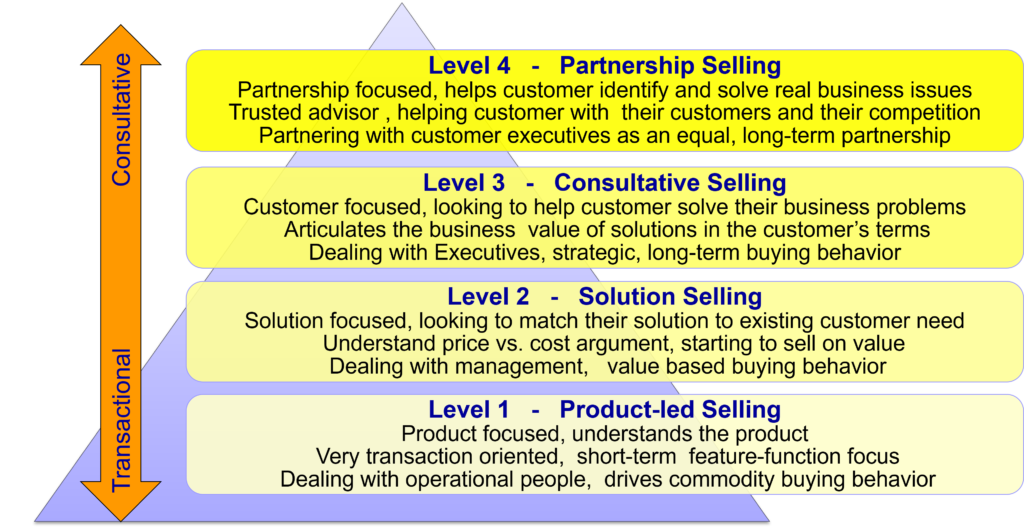
Let’s look at each of these levels in more detail …
In level 1, “Product-Led Selling”, the salesperson is very much focused on their own product. They spend their time learning what they can about the product so that they are able to describe the product, its features, functions and benefits to a customer.

Case Study 1.1 MacMillan Publishing
P.F. Collier is a subsidiary of the large Macmillan organization, a large, global publishing house which, back in the day, produced hardcopy Encyclopedia. These were sold door-to-door and to schools or education authorities. The role of the salesperson was to describe the product in detail, demonstrating the strength of the binding by holding up a heavy volume of the encyclopedia by one page, and shaking it. Then by talking about the ‘yearbook’ which would keep the whole set up-to-date, and even putting jam on a page and wiping it off to show how the unique coating that they had applied to each page would resist damage and keep the customer’s investment clean for generations to come. The ‘sales pitch’ culminated in the salesperson dramatically unfolding a life-sized poster showing the complete set of Encyclopedia in an elegant bookcase to illustrate how the product would look in the customer’s location.

The goal was to explain as many of the features and functions of the product as possible. To show how this product was better than an alternative product even if they might look very similar. The salesperson was then to explain the benefit of these features to the customer (longevity, durability, ongoing updates etc.) in the hope that the prospective customer would realize that they had a need for this product and buy a set. This was classic Level 1 selling. Nothing wrong with it, it worked. But it was all focused on the product, not the customer. You will recognize this approach in any situation where a salesperson is demonstrating a product first, and then asking questions afterwards.
This Level 1 type of selling can still be very successful in a transactional sales environment today. In these situations, the focus tends to be more short-term, it usually means that we are working with people at an operational level within the customer and it also means that you are likely to experience commodity buying behaviour. In other words, many customers, who have subconsciously been ‘educated’ by Level 1 transactional salespeople, have grown to expect this approach from every sales interaction. They in turn see their role as simply trying to buy the cheapest option, unless they can see value in paying more.
Customers in this environment have usually done their homework, they have already researched the internet. They know what they want, and they know there are many potential providers.
In this scenario your differentiation is based on the product, and it means you are in a highly competitive environment where product feature, function, and price, tend to determine which salesperson will be successful.
As we progress to level 2, “Solution Selling”, we start to introduce a slightly higher level of sales skill; and we start to introduce the concept of selling based on value rather than just price or product feature-function. Now salespeople are focused on selling a ‘solution’ which matches a customer’s need. The very term itself “solution selling” implies that the customer has a problem for which they need a solution. For this reason, this level of selling is also referred to as customer “need-led selling”.
Again, this type of sales process is very effective. It is still used today by many sales teams. It works because customers in a particular industry or marketplace often do have similar challenges, and therefore similar ‘needs’. Many companies have essentially built a business on identifying that need and building a solution to satisfy that need. The only problem is that not every customer is actually the same. Sales teams who use the solution selling approach in a rudimentary manner are essentially saying “I have a solution, so therefore you must have a problem”. Companies tended to build ‘solutions’ around their ‘products’ and presented them as a solution to the customer’s problems. This represented a step forward for salespeople because they had at least to demonstrate an understanding of the customers’ business and an articulation of the problem, before they could present their solution to that problem. As such, they are more likely to be dealing with a management level person within the customer, and consequentially are likely to be experiencing value-based buying behaviors.

Case Study 1.2 Intuit (Quickbooks)
Like many software companies, Intuit identified a common problem, or need, faced by many companies, especially small-medium sized businesses, namely that they needed a more automated approach to how they produced their financial accounts. Intuit therefore developed a solution to address this problem, ‘Quickbooks’, a solution which they are very successful in selling.

Remember that every company was already producing their financial accounts in some other way, they had to, in order to create their annual financial returns. But Intuit had identified a common need, and then went about developing, not just a product, but a solution which addressed many customer concerns beyond the basic requirements. Quickbooks software not only enabled customers to produce their financial accounts more efficiently, but it also included tutorials to help people learn the new software, it included updates to adjust for new tax or financial accounting requirements, and it included a range of commonly used Reports to help customers quickly summarize their information. The solution was not sold to individual bookkeepers but rather to managers of the finance department or to small business owners. These were not operational staff but more senior people who needed to be persuaded that Intuit had understood their specific business requirements and had built Quickbooks as a solution that fit the need.
As we have said, both Level 1 and Level 2 selling still work today – in the right scenario. However, our goal in this program is to help you to grow beyond this level. To break the glass ceiling that exists to prevent many salespeople from becoming Level 3 salespeople. We will develop your Consultative Selling Skills so that you can differentiate yourself from the level 1 and level 2 salespeople through your customer focus and your focus on selling real business value. There’s a reason why that diagram above has the blue pyramid in the background. That represents the volume of salespeople worldwide. In fact, if we could draw that more appropriately, the pyramid would be even wider at the bottom and would become significantly narrower after Level 2.
This is because Level 3 salespeople are different, very different. Their focus is much more on their customers than on their own product. They start by looking for ways to help the customer solve their business problems, not by looking for ways to sell their own product or solution. They articulate the business value of the solutions that they are selling in terms that are more relevant to the customer, not just in generic terms. This usually means that they are dealing with a more senior level of person within the customer; likely to include the executive level, and that they will be experiencing a more strategic, long-term buying behavior.
Being Consultative means developing a different mindset. It requires a fundamental change in thinking, whereby your first thought is to focus on the customer, not on your product or solution. It means salespeople have to suspend the product pitch and resist the temptation to introduce a product or solution too early in the selling process. All too often, salespeople ‘leave money on the table’, so to speak, because they jump-in too early to deliver a product pitch before they have understood enough about the customer. They are listening only for the buying signals that indicate a customer need for which they have a solution, and then they immediately seize the opportunity to sell. Consultative salespeople resist that temptation. They suspend that product pitch until they have explored more. They are inquisitive, interested in the customer, curious, and eager to learn more. When they feel they have understood what the customer really needs, then they present ideas, not products. This builds trust and it encourages the customer to be more open about what they feel is really important.
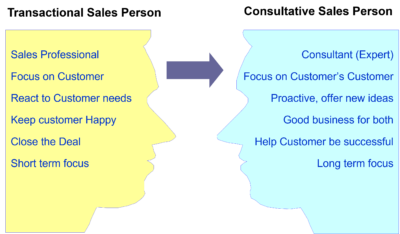
The vast majority of salespeople operate at level 1 or level 2. Very few salespeople achieve Level 3, Consultative Selling, status. This program is intended to help you differentiate yourself from your personal competition – so that you can be more successful – for yourself, and for the company you work for.
Ultimately, we would hope that you might be able to develop your skills to the highest level – Partnership Selling. At this level you almost become part of the customer team; you are certainly considered by them to be a trusted advisor – helping them to identify new business opportunities, new ways to help their customers; and to identify ways in which they can outperform their competition.
At this level you are going to be partnering with customer executives as an equal, in a long-term partnership. You are going to be invited-in early to internal discussions. You will have the opportunity to suggest new ideas and to influence the customer’s strategy and decision-making. Clearly very few salespeople reach this level 4 status – but it is something that we should aspire to do once we have mastered our consultative selling skills.
Although it might look as though this is an ongoing progression of skills, in reality it is most likely that, in order to be effective in your sales role, you will need to develop the ability to be flexible and to know when to apply a more transactional approach, and when to be more consultative. Being more consultative will enable you to differentiate yourself from your competition, not just from your company’s competition in general but from your personal competition in particular.
Let’s just think about this concept of “Your Personal Competition”. We tend to think of our competitors as being the companies that we compete with within our market. But in reality, you are competing against other individual salespeople. More importantly than that, you are actually competing with every other salesperson who is meeting with your customer, regardless of what they are selling. What we mean here is that the people in the customer team will be assessing your skills, and the potential value that you might be able to bring to them and to their business. They compare you with all the other salespeople they meet. And they instantly form an opinion based on the way you behave. This is your personal competition. To differentiate yourself, you need to be using a higher level of sales skill. You need to be seen as being consultative, more focused on helping the customer than simply selling your product or service.
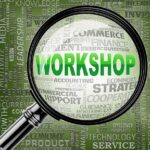
Exercise 1.1
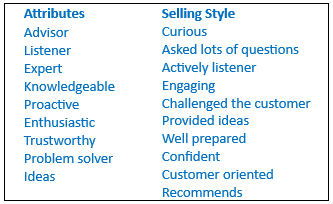
Course Manual 2: Getting Involved Early
The Importance of Getting Involved Early
As we have learned so far, the majority of salespeople are responding to an identified customer need. By definition this means that the customer has already figured out what their problems are, and what they need to solve the problem. Research by the Corporate Executive Board (now part of Gartner) indicated that most customers have conducted 57% of their buying journey before they even talk to a salesperson. So how can a salesperson differentiate themselves in such an environment?
Effective consultative salespeople learn how to get involved earlier in that buying process. They learn how to be aligned with the customers buying cycle, and ultimately how to get involved at the outset. The problem stems from the fact that most salespeople tend to focus on their selling cycle, rather than on the customer buying cycle. After all, most of their past training has probably been focused on their sales cycle and all of their sales tools and reporting is directed towards that process. In other words, they focus on all the things they need to do in order to sell their product or service to the customer. Clearly this is another unfortunate consequence of that product or solution-led sales approach.
Consultative salespeople are more aware of, and more focused on, the customer buying cycle. The secret is to get involved early, in order to be aligned with the customer throughout their buying process.
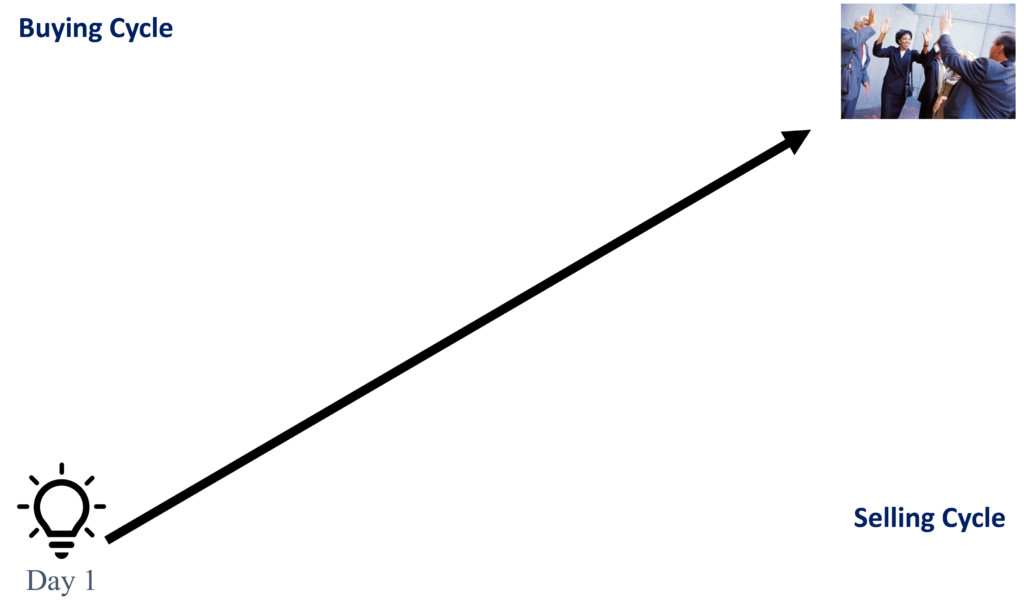
Day one of a consultative buying cycle is when the customer has a thought or idea about how they might be able to solve current business problem, or an idea about a new business opportunity. What they have in mind at that time are the results that they hope to be able to achieve; usually those results will be expressed in terms of saving money or making money (reducing costs, improving efficiency, increasing revenue, improving productivity etc.) But, before the customer can achieve those results, there are many, many things that they need to do. Much of this involves actions which the customer can, and will, undertake on their own. It’s important to realize that, for the customer this is not purely about buying a product r service from an external provider. Their process is all about how to change what they are doing today to see a real business improvement. Some part of this is likely to involve buying products and services from an external partner … hence the buying process begins:
They will probably start by conducting a needs analysis. Based on that, they can create a vision for the project, which will help them to get internal buy-in to their idea. This is a critical stage for the individual who came-up with the idea because there are increasingly more and more stakeholders involved in any corporate buying decision. Once the overall vision is clear, they can start to define the requirements for the project, and slowly to determine what the solution might look like. Customers use this outline design to determine who might be able to help them with the solution, and at this point they might get in touch with a preferred provider from whom they aim to gather information about the likely cost of the external elements to the solution.
Based on this analysis they can then determine the likely return on investment so that they can build a business case, which they need in order to gain executive support. This stage will require getting budget approval to proceed further. At this point many companies implement an RFI (Request for Information) or RFP (Request for Proposal) or RFQ (Request for Quotation) process . This is part of their corporate process and due diligence to gather 2 or 3 competitive bids from potential suppliers.
Armed with these responses, their analysis of the information, and their feeling about the most worthy supplier, they will then need to get executive approval to actually spend the money. Just because there was a budget created, it does not mean they have approval to go ahead. (This is a problem that many salespeople forget, and we will address this in a later module in the Sales Growth program). But let’s assume they succeed in getting the necessary internal approvals. Finally, they can now sign the order with the supplier, and get started on the project which initiated all this in the first place. Salespeople might feel that their process is exhausting, the customer buyer process is usually a lot worse!
The problem is that, for most transactional salespeople, the typical sales cycle starts around the time that they realize that there is budget available, and it ends at the time that they receive a signed order. They become totally focused on their own, narrow, fairly short-term, sales process, and they have little regard for what the customer has been through. Of course, the real problem of these salespeople is that the customer can see this too. They observe the same characteristics of a transactional, product-focused sales approach which they have experienced so many times before and they respond with their commodity-based, price and discount focused response.
If they are successful, such a sales team might be celebrating the order they have just received while the customer is now entirely focused on implementing the solution, gaining successful adoption, in order that they can actually achieve those results that they had in mind at the beginning of the whole process! That’s when THEY will celebrate!

Case Study 1 IBM
IBM had built a huge and successful global business by providing computer hardware – large computing systems to large companies worldwide. But they had a problem. Namely that the profitability of those systems was declining, and more low-cost competitors entered the market. Under the leadership of their new CEO, Lou Gerstner, IBM decided it needed to adopt a different approach (see his book ‘Teaching Elephants to Dance’). Gerstner initiated a major change in strategy. IBM would pivot to sell Services not just products. They would be selling their expertise and valuing their solutions based on customer-value, not commodity cost of computing machines.
‘Pivot’ is a relative term in this context because behemoths like IBM don’t pivot that easily. They are like supertankers trying to change course. It takes time, and skills and perseverance. Part of their strategy was to re-educate their sales teams by undertaking our consultative selling training. It was going well and one of their teams were working on their largest sales opportunity of the year: a bid to replace all of the computer systems for Eurocontrol (the air traffic control system for Europe).

It was a huge deal, and the team were delighted when they heard that they had won their bid and secured a $5 million order for systems and services. They were naturally delighted, and they celebrated late into the night! However, they were a little less enthusiastic the next morning when they opened the Financial Times. They read a front-page article saying that Accenture had been awarded a $35 million order for Services in relation to the Eurocontrol bid.
The point is that the IBM team were still focused on selling their solutions. They were not the customer’s trusted advisor and services partner. The team had no idea that the real value of the bid could have been in excess of $40 million.
The epilogue to this story is that of course IBM did learn. They grew their new services business to be a huge standalone business, IBM Global Services, and they acquired some of their competing services companies to emerge as the largest IT Services company in the world.
There’s something else that we can all learn from this IBM story. Where do you think the IBM sales team was focused? They were excellent at building great relationships with senior people in the customer’s IT department. But what we need to learn, whether we are typically selling to people in IT, or Finance, or HR, or Manufacturing, or Clinical, the same applies: namely that that the customer buying cycle often starts long before the IT or other operational departments might get involved. It starts when someone has a thought, an idea, about how to make things better. The operational departments make things happen, but the idea, and the buying process, often starts elsewhere.
So let’s think about what actually happens on day one: On Day 1 of the customer buying cycle the individual in the customer, who thought of the original idea, reaches out to somebody. They reach out to somebody they trust, to help provide help and insight. Why? Why would someone reach out for help and why would they potentially reach out to people outside their own organization?
There are many reasons for this. For example, they might want to keep the idea to themselves, so that someone else doesn’t take their idea, they want to take credit for having thought of this new way to save money or increase revenue. They might be concerned that it’s a crazy idea and one which they want to validate with someone else first. They might feel that there are people externally who may have had similar experiences or may have tried the idea elsewhere, or seen it work elsewhere.
The point is that the external ‘someone’ that they reach out to can be a salesperson. It’s a salesperson that they trust and like. It’s someone they feel comfortable with, and who has earned their respect. It might be an external consultant. It will be someone who they consider to be a Trusted Advisor. That someone could be you!
If you are successful in earning the trust of key people in the customer team, you can be involved at the very beginning of the customer buying cycle. This has huge benefits to you in the sales process. It means that you are there at the outset and you have no competition. There is no competition because they are not even talking to anyone else.
Another important benefit is that you are able to help them shape the solution. You can help with the design of the solution. You can even help them to scope the project. This is an important advantage because it enables you to insert key requirements which align with what your company is able to provide, including aspects of your solution which you know are key differentiators, which potential competitors do not have, or cannot match.
There is no guarantee that the customer will not seek alternative bids. Indeed, they probably have to do this. They might be obliged by their Procurement processes that they must get a competitive tender and have a formal RFP process. But the point is that even if that is the case, you can help them to write the RFP/RFQ. And you can write it in such a way as to improve your chances of success and make it less likely that they will select a competitor.
After all, think about this from the customer’s perspective. They want their idea, their pet project, to be successful. They want to work with a partner that they trust. You have now been with them since the beginning. You understand exactly what they are trying to achieve, and why. They don’t want to work with anyone else. Even if there are lower cost providers out there, they want to be working with a team they can trust. A team who will work alongside them to achieve the end results. A true partner.
So, the real key to Consultative Selling is that the Consultative Sales Cycle starts on Day 1 of the Customer Buying Cycle.
The goal therefore is to get involved as early as you possibly can. The consultative sales cycle starts on day 1, when the customer first has the idea. It should not end until the customer achieves the results that they had in mind. This is the key to consultative selling because it means that IF you are still there when the customer has achieved the results they had in mind at the outset, the customer is much more likely to listen to your next idea.
You can then be the spark that ignites their next idea. Ultimately, having achieved the trusted advisor status, the salesperson can be the person that actually ignites the light bulb by giving the customer the insight and ideas to start a new project. The reason that this is so powerful is that the consultative salesperson is thereby earning trust, until finally they emerge as a Level 4 salesperson, wherein they are invited to discuss new ideas and are regarded by the customer as being an extension of their own team.
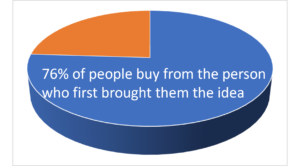
As further evidence of the importance of this, another recent study confirmed that 74% of companies choose to buy from the salesperson who FIRST brought them the idea. Speed, and getting involved early pays off. You’re 3 times more likely to win the deal if you provide the initial insight and idea.
I’ve heard some salespeople say that they don’t have the time to be consultative. They feel that a consultative sales process takes too long and point out that they have quarterly targets to hit. My question to these people is this: where would you like to be, in the 26% who get lucky because they arrive late in the process, or in the 74% who win because they are there first? You would win 3x more deals. That sort of productivity gain would enable you to exceed any quarterly target. But you have to start the process now. Don’t delay.
Remember, the people who are there at the beginning have no competition. The people who arrive late always have competition. If you feel you always have competition in your deals, ask yourself why?
Perhaps you’re arriving too late in the process?
Perhaps you’re not regarded as a trusted advisor?
Perhaps you need to be more consultative in your approach?

Exercise 1.2

Course Manual 3: Creating Competitive Differentiation
Creating Competitive Differentiation through the way you sell
We have learned that in essence, consultative selling is all about being focused on the customer, delivering value, and providing ideas. Providing these ideas to a customer is therefore the very essence of the ‘personal value’ that you can provide as a salesperson. Customers might be able to buy similar products and services from other companies, but the one thing they cannot buy is your own personal insight and ideas. That’s your source of PERSONAL VALUE and it is a key differentiator.
If we think about the sources of competitive differentiation, they fall into 4 categories. The key takeaway here for salespeople is that their ability to influence these factors varies considerably across the range. Most of your personal impact comes from #4, your Sales and Relationship Superiority. This is related to the level of ‘Connection’ that you have with the people in the customer buying team.
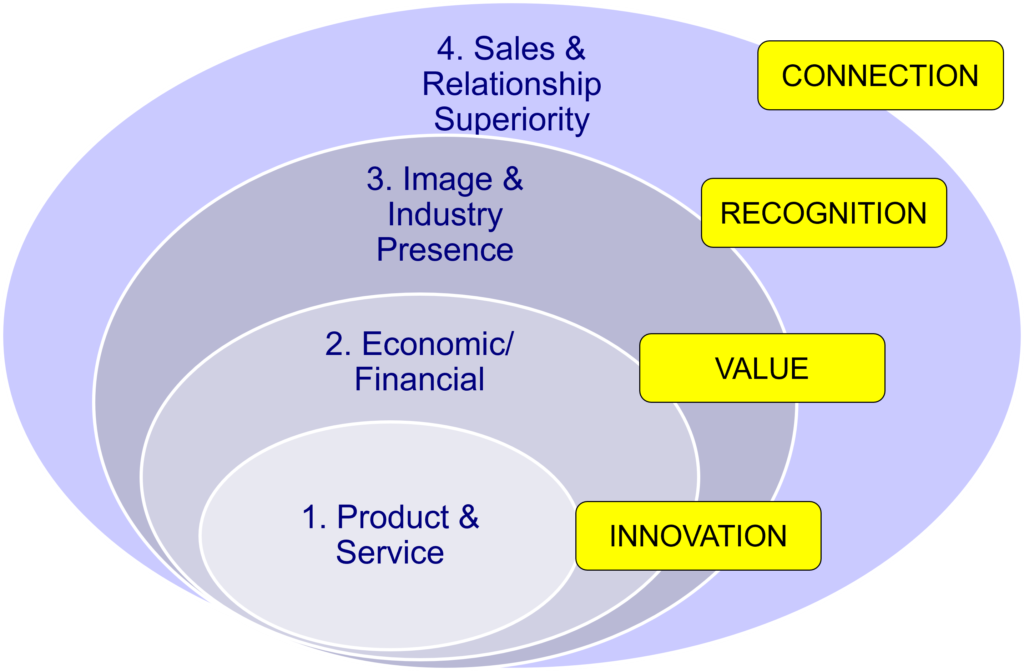
Differentiation starts with having a product or service to offer the customer. But many companies can provide the same things, all products become commoditized over time, so the real source of differentiation here is INNOVATION. Being more innovative can provide a company with the ability to differentiate their products and services from their competitors.
Salespeople may feel that they can do little to influence this area of differentiation but in reality, they can do a lot. Although they may not be able to directly impact product design and service delivery, indirectly they can. They can be the ‘voice of the customer’ to channel feedback and ideas back from existing customers to create new products or services for the future.
The biggest impact they can offer lies in their being able to make this company innovation more obvious to the customer. The salesperson’s role is to make their product value visible to the customer. This means channeling the message so that the customer sees the relevant value of specific features and functions of the product or service. Without this they are just hoping that each person on the customer’s buying team is able to make the connection between a particular, perhaps small innovation, and the value it can bring to the customer’s team. This is something that we will re-visit many times during the Sales Growth program.

Case Study: Apple – Innovative Differentiation

Apple has certainly had a volatile history, but one constant has been their unrelenting focus on innovation. Sometimes this might have left them on the bleeding edge of technology and innovation (bringing products to market for a customer base that was not quite ready for them), but for the last 20+ years they have been the leaders in their space. Apple has created a cash mountain in excess of $62 Billion, that’s up almost 30% from the year before, and larger than most countries in the world.
In large part, a significant aspect of Apple’s success has been its ability to differentiate its products and services from other competitors through constant innovation. Witness the launch of the iPod in 2001. This led to a sea change in how music was consumed and created a whole new sector in digital music. The iPhone arrived in 2007 which spawned the ‘smart-phone’ market.
The iPhone helped to launch the iPad, bridging the gap between smartphone and pc. Apple again created a product category where one did not exist. Even in the pc/laptop space, which was already highly competitive, Apple’s series of laptops have a unique style, quality, look and feel that other competitors have not been able to replicate.
Apple is not the cheapest product available. They don’t offer discounts. They base their competitive differentiation on their products and services and as a result they have queues of people lining-up outside their stores to buy the latest releases, even before these people know what the new device looks like. That’s differentiation driven by product innovation.
The cost of an iPhone has risen from $499 when it was first launched to a whopping $1299 for the newly released iPhone 15. Salespeople who think purchases are all about price and discount should take heed.
The second source of differentiation is certainly based on Financial or Economic factors. Clearly the most obvious element here is price, but this is not all about the discounts that different companies might offer. Companies can create different pricing strategies to create differentiation in the market. For example, one approach is to deliberately create a high initial price and then offer attractive discounts to make the customer believe they are getting a good deal. The opposite is to advertise an attractive low price in order to attract customer interest. All of these strategies work very effectively in different market situations.
In B2B sales another common approach in relation to pricing relates to creating differentiation through different financing terms. Big-ticket items can be purchased over time through attractive financing options or leased rather than sold to enable the customer to use operational, rather than capital funds.
Salespeople can exert some influence over the Economic/Financial Differentiation by being creative in the way they sell. For example, they may be able to offer the customer the opportunity to make a commitment this quarter for delivery next quarter or to take payments over a period of time. They can negotiate payment terms and they can build convincing ROI business cases to make it easier for the customer to buy. Ultimately this comes down to the salesperson’s ability to sell VALUE, not just price.
The third phase of differentiation comes from Company Image, Reputation, and Industry Presence. I often hear salespeople say that this is the area over which they have the least impact. They point to Marketing’s role to promote the brand, to advertise the company, to engage in social media and so on. Certainly, much of this is true. It is challenging for an individual salesperson to influence the widespread customer perception of a brand or the level of customer awareness of the company. But at the individual customer level, there is still a great deal that the sales team can do to influence a customer’s perception of brand and image. This extends to their being able to become thought leaders and influencers in their target industry sector.
Social selling, for example, is one way in which sales teams can make a huge difference. Working closely with their marketing department business partners, salespeople can engage actively on social platforms to broadcast information about the company and engage with customers and prospects. This can have a huge impact on their ability to be seen as potential ‘trusted advisors’ to their customers.

Case Study: IGEL
In 2015, IGEL was a relatively small, German-based company with no real presence in the US. They had a very successful range of products in the end-user computing space, often referred to as thin-clients, or dumb terminals. They were market leaders in Germany but pretty much unknown in the US. They recruited a new CEO, Jed Ayres, with a strong marketing background. Jed, based in the US, immediately set about developing the brand and promoting the image of the company. Social presence was key.
IGEL worked with a social media specialist company called Everyone Social to turn all of their employees into influencers. Influencers who could change the market perception of the company, its size and stature in the market. The results were amazing. In just a few years IGEL was seen all over social media in their target market areas. They were seen as changing the perception of the EUC space. They drew attention from large players in the market. They were able to leverage this into major partnerships and alliances with companies such as Microsoft, Citrix, HP and Lenovo.
One of the keys to the success of this initiative for individual salespeople was that if they embraced the strategy. If they got involved. If they engaged with the market. They were able to build a personal presence wherein they started to be accepted by customers and prospects as having something unique and interesting to offer. Suddenly this small German hardware company had transitioned to become the third largest player in their space and eventually to be the software partner on which Microsoft’s new Linux-based thin-client solution was based.
The importance of the IGEL story is that an individual salesperson can have an influence on differentiation based on Company Image and Industry Presence. They do this by creating CONNECTION. What really matters to anyone in a buying team is that they are dealing with a company they can trust. Salespeople can influence that perception of trust by being active on business-oriented social media, like LinkedIn. By simply re-posting interesting content, especially video content, they can enhance the customer’s perception of the company and the image they have of the company as a potential provider and business partner. This in turn develops a Connection which itself creates differentiation.
The fourth and final source of competitive differentiation comes from Sales and Relationship Superiority. Clearly this is the area over which the sales team has the most impact and is the area in which some salespeople excel.
However, salespeople should be wary of overplaying this card. As the research behind the book ‘The Challenger Sale’ revealed, relationships are not everything. I was in a training session with a large customer recently and I asked the salespeople what they thought was the most important factor in determining which supplier a customer would buy from. This is a question I have asked many times of different sales teams. The answer is always the same: the #1 factor is Price. I ask if they are the cheapest supplier in the market, and most of the time they are not. So, I then ask them why they thought their customers had chosen to buy from them rather than their cheaper competitors, and again the answer is nearly always the same: Relationship.
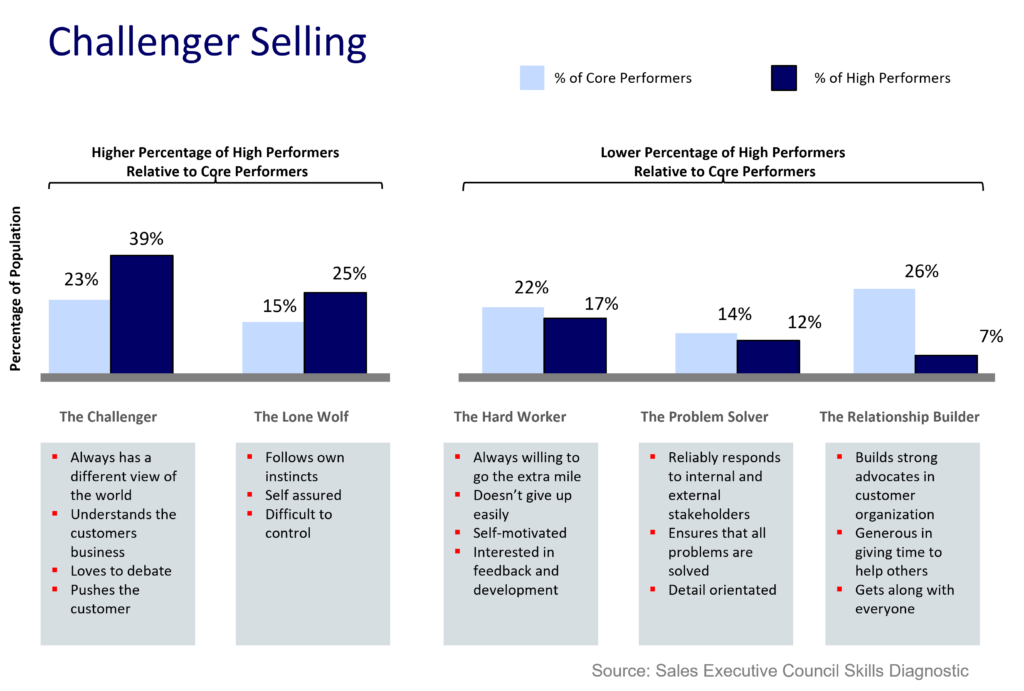
The research by the Corporate Executive Board revealed that this does not align with the evidence. It illustrated that although Relationship Builders comprised the highest percentage of core performers (salespeople who performed close to average), they represented the lowest percentage of top sales performers. In other words, relationship-led selling is the least likely to be successful.
To be clear, I am not trying to suggest that building good relationships with customers is not important. Clearly it is important. But the evidence suggests that this approach alone is much less likely to yield results. The research showed that the highest percentage of top performers were the consultative sales professionals who were not afraid to challenge the customer’s thinking. These were the salespeople who were most likely to succeed, especially in a complex sales environment.
I believe there are clearly some flaws in the conclusions that were derived from the Sales Resource council study. It became a little self-serving in being a platform from which to sell their own sales methodology. The main problem is that, like many studies that seek to ‘put people in boxes’, in reality successful people need to be a mix of many different skill profiles. They also need to be able to adapt their selling style and behavior to suit the different stages in the sales cycle and to align with the different people in the buying team.
The key message was that you cannot be successful solely by building relationships. Customers want more. They want to see real insight and value coming for the salesperson themselves. Otherwise, increasingly, they would prefer to buy online without any sales interaction whatsoever.

Exercise 1.3


Course Manual 4: Providing Insight
If salespeople are to be successful in getting involved earlier in the customer buying cycle, we know they have to be able to provide relevant ideas. Not just any ideas, but relevant ideas for helping the customer to be more successful. So where do these ideas come from?
Ideas come from INSIGHT, and that insight comes from having relevant expertise, experience or knowledge. We will address the research aspects of this in a later module, right now let’s focus on why this is so important. The critical importance of insight was highlighted in some research done by the Huthwaite Group. They conducted a widespread survey of customers in which they asked 1000’s of executives and managers a simple question …
“WHY would you meet with a salesperson?”
Think about this for a second. “Why would any busy executive or manager give up a valuable hour in their day to meet with a salesperson from another company?”
You know only too well that your customers are all very busy people trying to accomplish their own goals and objectives. They are short on time, they feel rushed, they have deadlines to meet, they have targets to achieve. Have you ever asked yourself WHY they would agree to meet with you?
It is very clear that they do not want to meet salespeople to hear all about whatever product or service they are selling. Customers can, and do, research all that for themselves on the web. In fact some customers are better informed about a particular product or service than the sales people themselves. They have invested the time to learn about the different solutions. They may have already examined the differences between different suppliers. All this reinforces the need for a consultative salesperson to get involved as early as possible in this process.
The Huthwaite study revealed that there are 3 reasons why customers agree to meet with salespeople …
Reason #1
Firstly, they said they would meet with salespeople who were able to identify a new opportunity for the customer. One which they had not yet recognized themselves.
The key point is that if they have already identified the opportunity, they don’t need to meet with a salesperson to tell him what they already know. There is no value in that. The salesperson has to bring additional value in the form of fresh ideas or new insight.
So, what might these ideas for new opportunities be, and how would a salesperson be able to offer such ideas to a customer? The answer lies in Research, Expertise and Experience. Professional salespeople need to leverage their knowledge and expertise, use their industry experience and invest their time in researching the customer and staying up-to-date with market developments. That gives them a strong foundation upon which to offer new ideas to their customers. Note: new ideas, not products! This is not about suggesting that a customer buy a solution, it’s about suggesting a business idea that might lead to a new opportunity for the customer. A part of what they need will involve buying a part of the total solution from the sales team but that is not the reason they want to see you. They want your ideas remember, not your products!

Case Study 1 Bank of America
During the 2007-2009 financial crisis, or what some people refer to as the Great Recession, banks around the world were experiencing significant problems due to bad debt. At the same time, many banks, like Bank of America, were trying to expand their footprint and grow their business by attracting new customers. For a manager responsible for a credit card portfolio, expanding a portfolio potentially meant expanding the level of risk. Something that the Bank could ill-afford to do. They were looking for some insight and fresh ideas.
 Enter the Visa sales team. The Visa Account Manager listened to the bank’s challenges, asked some searching questions about their goals and targets and began to suggest some ideas. Through that discussion they were able to suggest that a new opportunity might exist in providing payment cards to the ‘unbanked’. There were at that time, and still are today, a surprising number of ‘un-banked’ people in the US. These are people who do not have a banking relationship, they have no checking account and no deposits. The Visa Account Manager suggested that there might be an opportunity to provided these people with a prepaid debit card. These were not new per se. They had existed as ‘gift cards’ for several years, but the proposed application was different.
Enter the Visa sales team. The Visa Account Manager listened to the bank’s challenges, asked some searching questions about their goals and targets and began to suggest some ideas. Through that discussion they were able to suggest that a new opportunity might exist in providing payment cards to the ‘unbanked’. There were at that time, and still are today, a surprising number of ‘un-banked’ people in the US. These are people who do not have a banking relationship, they have no checking account and no deposits. The Visa Account Manager suggested that there might be an opportunity to provided these people with a prepaid debit card. These were not new per se. They had existed as ‘gift cards’ for several years, but the proposed application was different.
The Bank was keen to develop a relationship with prospective new customers. By having them deposit cash funds to a prepaid card, they were able to put a bank product in these people’s wallets without increasing the risk to the bank. It was a real win-win-win. The bank secured a relationship with thousands of new customers. Visa secured millions of dollars of new card transactions. And the individual customers were able to operate using payment cards for regular purchases like food and gas without needing to have thousands of dollars in a checking account.
This example worked because the Visa account team had in-depth knowledge of the banking sector and the challenges they were facing. They used their expertise and experience to bring insight and propose some ideas to their customer, the bank.
If you are selling into a specific industry sector, you need to be aware of the common challenges facing companies that operate in that sector. Having worked with several companies, you might learn what company A and B might be doing that company C might not. You become inquisitive. You wonder why? And you might start asking company C about their thoughts and strategy in relation to this topic.
At this point, you are exploring the potential for new opportunities. You are challenging the customer’s thinking. You are starting to develop yourself as a potential trusted advisor. Someone whom the customer feels they can bounce ideas off. You start to become a useful resource to them.
If you couple this with doing a more detailed analysis of the customer, you gain a deeper understanding of what they are trying to achieve, and where they are trying to go as a company. You are now starting to enhance your ability to provide insight into new opportunities that might be appealing to them. Remember that you may not always get this right. The customer may not take your idea and run with it. But that doesn’t matter. What matters is that they see you as bringing new insight. Through this you earn their respect and eventually their trust as someone who is knowledgeable about their industry, and interested in helping them to be more successful in their own right.
Reason #2
The second reason why, according to the research, customers say they would meet with salespeople, is that they will meet with someone who could help them to find a new solution to an existing business problem; again, a new solution that they had not already identified.
So, once again, the key is that there is little or no value in the salesperson telling them what they already know, but a lot of value in bringing new insight and ideas. Just as in #1 above the salesperson’s potential ability to do this is driven by their expertise, knowledge and experience of having worked with similar companies in the same industry, or even dissimilar companies from different industries but facing a common problem.

Case Study 2 Immersive Labs
Everyone is aware that cyber crime is on the rise and indeed more and more companies are seeing their ability to respond quickly to a cyber threat as being mission-critical. In most cases, it is not the actual cyber-attack itself that causes most harm, it is the knock-on effect in terms of restricted or damaged operations, and the reduction in customer trust in the business.

There are many companies who have developed solutions to try to help businesses make their IT and online environments more secure. Immersive Labs (IL) took a different approach. They started to look at the human aspects of cyber security. Namely, how well individuals and teams within and organization respond to a cyber-attack. They realized that in many cases, the effectiveness of the response was not so much related to the state-of-the-art cyber protection measures but in the human element of how to respond to an attack. Being quick to recognize the issue and to follow protocol in terms of the actions that should be taken.
IL sales teams use their knowledge of the industry to learn more about the problems which many large organizations face. They then present their ideas in the form of suggestions for how a company could reduce risk by being better prepared for when a cyber-attack takes place. In such a situation, minutes count! Note, they are bringing insight in the form of a challenge: it’s not a matter of ‘if’ and attack will happen, it’s a matter of ‘when’. IL sales teams suggest that the customer conduct regular, customized cyber defense training. What emerges is a new approach in which they become part of the customer solution to be more resilient. IL provides ‘labs’ and simulations to test the response of the customer teams. They become a key partner with the customer team in helping them to make their IT environment more secure.
Let’s examine what’s different about the approach here: if the sales teams at Immersive Labs were to lead by selling their simulations, they would be met with customer resistance. Customers already believe that they are doing what they need to do and have already developed robust training programs to support it. However, if the sales teams start from the perspective of discussing the business problems, namely, how do customers make themselves for resilient and more responsive, they can present their solution as an idea, as insight, and be seen to be a trusted partner in the process.
This all goes back to that notion of differentiation through innovation, not through product. In other words, the key is to present your ideas as being a solution, or in reality, part of a solution, to a stated customer business problem. You differentiate you self because you present new ideas which the customer had not themselves already thought of. You are bringing something new.
Reason #3

The third reason outlined in Huthwaite’s research was that customers said they would meet with salespeople who could provide insight by highlighting a future customer business problem that the customer themselves had not yet realized. The value here is in providing the insight into something that the customer is unaware of, and therefore unprepared for. Salespeople are effectively helping their customers to see the future.
In this case, the salesperson is providing real insight because they are highlighting something that the customer has not realized for themselves. The salesperson can bring this insight because they have a broad perspective on the market and have exposure to many, many different types of company. We are not suggesting that as salespeople you need to be able to predict the future! Far from it. What this suggests is that as sales professionals you are observant, curious, inquisitive. When you see something new, you ask questions about it. Slowly you develop experience and insight from one customer or industry which you can relate to another industry. In so doing, you become that trusted advisor, that counsellor that the customer feels comfortable in sharing thoughts and ideas with.
As salespeople, perhaps you have already seen other companies tackling a similar problem. One company has experienced this challenge, even if another has not yet felt the same impact. You can become their early warning system. If you have seen this happen in Company A, you can also learn how they responded. That insight is what you bring to Company B. Even if they have not experienced the same issues. For example, you might become aware of new regulation or potential legislation before the customer has heard about it. This puts you, as the salesperson, in a position to become a real trusted advisor.
In each of these areas, the real value to the customer lies in getting insight provided by an external person who is customer-focused and is experienced enough in the market to be credible. From the salesperson’s perspective this comes from developing that new mindset that we mentioned earlier. Consultative salespeople care about their customers. They are inquisitive, interested, and curious in what the customer is doing and in what they are trying to achieve. Their focus is on helping them to be successful and to be thinking about ways in which they might be able to help.
The research actually identified another important factor. Customers said they would only meet with salespeople who were clearly able to get things done internally. In other words, sales professionals who were also effective team leaders within their own businesses, able to marshal the necessary resources within their organization to help the customers achieve their goals.
The point is that customers recognize that ‘it takes a village’ to get things done in any organization. Some people have the ability to make things happen. Other people do not. Customers what their sales professionals to have demonstrated that they possess the necessary political gravitas and clout to get things done within their own organization. Otherwise, customers do not want to waste their time, they want to talk to whoever they need to in order to make things happen.
So, what does all this mean to us as we develop our consultative selling skills? It means that the reason the customer has agreed to meet with you is that they expect you to provide CUSTOMIZED INSIGHT and INFORMATION – backed up by DATA.
This last point is an important new differentiator for salespeople in the Information Age. Customer decisions today need to be backed-up by Data. A recent study by LinkedIn reinforced the same findings, showing that 77% of customers want customized, integrated insights backed up by real data – meaning that salespeople have to do their homework to be able to provide real value in a sales meeting. It means that the reason the customer has agreed to meet with you is that they expect you to provide relevant insight, ideas (as Huthwaite said), but also that this insight is supported by meaningful, relevant data and new information.

Exercise 1.4
1. Find a new opportunity, one that the customer has not recognized for themselves
2. Find a new solution to an existing problem, which they are not aware of
3. Identify a potential future business problem, which they do not already know about
4. Suggest ways in which you could demonstrate your ability to be a good virtual team leader

Course Manual 5: The Sales Growth Playbook
The concept of having a “playbook” is not new. The idea originates in sport, where teams develop a playbook to describe specific ‘plays’ that they will implement at different stages in a game. Playbooks are designed to help teams to win each game. Perhaps the most common use of this approach is in American Football. By its nature, the game is a series of start-stop ‘plays’. Each one creates an opportunity to reassess and determine the best course of action given the current situation. However, although perhaps not quite so apparent, the same can be said for Rugby, Soccer, Hockey or Baseball. In Rugby, for example, teams practice specific ‘set piece’ situations (the line-out, the scrum, a penalty etc). In soccer teams plan ahead for a ‘free kick’ from a specific part of the field. The thing to realize here is that teams do this for own ‘plays’ or ‘set pieces’ and also for their opposition’s. Similarly, in Sales, we can do this for our own ‘plays’ and also to counter competitive activity.

The key is that the playbook helps to answer the question: How are we going to Win? In some sports, the game is played against an active opponent which might be an individual or a team. In other sports, the game is played against the clock (like Skiing). Some sports have both elements (like Formula 1 car racing where the Qualifying sessions are fought against the clock and the race itself is against the other teams and drivers). In each case, the team has a playbook to define the strategy and tactics required to win.
So too in Sales. There are things you need to do in order to put yourselves in the best position to win. Then there are actions you need to take when a competitor gets involved, or when people in the customer team change roles. This is an increasingly important aspect of your strategy because recent research indicates that 30% of people change their role in some way each year. That’s 30% of your customer contacts and the people in your customer buying team. Your Sales Playbook should explain what you need to do in each scenario. It serves as a reference manual for the future and to reinforce understanding.
Think of your Sales Playbook more specifically as an Operations Manual. Some people may think of it as a book containing ‘Standard Operating Procedures’. In business, as in sports, a Playbook is intended to document everything about a company’s Vision and Strategy, and then more specifically to break this down into tactics which individual employees and teams can implement. As an ‘Operations Manual’ it can be given to new employees, or people who are changing departments or jobs. It should provide them with everything they need to know in order to be successful. Think of this as a way to describe to everyone in the team exactly what they need to do to succeed.

Case Study DHL
Jardine Cargo International, now part of DHL, had a Graduate Training Program in which they selected graduates to join the company, learn the business and be well prepared for management positions. The program was in its infancy when a new graduate joined the company. The so-called training program consisted of each person being assigned to spend three months in each of the primary departments in the company. The idea was that the graduates would learn by osmosis during those three months and then move on to the next department. At the end of a 2-year period each graduate would be deemed to be sufficiently knowledgeable and then be assigned to their first job role.

One such graduate decided that they did not really need to spend 3 months in each department in order to ‘learn the ropes’. However, the request that they be allowed to move to the next department any earlier than 3 months was declined. The graduate decided that in order to prove that they understood the operations in detail, they would produce an Operating Manual which would explain in detail everything they knew about the workings of that department, and even to suggest potential improvements in process. The manual formed the basis of a review with the department manager who would then sign-off on the graduate’s move to the next department.
Having successfully documented the Operating Procedures for the company’s primary Export shipping department at Heathrow, they went on to do the same for Import Operations, and then the Consolidations Department. After 6 months, management accepted that the manual, aka The Playbook, was an adequate demonstration of the acquired knowledge and approved the graduate’s move to progress to the next department. Producing the Playbook chapter for each part of the company operations became the route to promotion and progress for the individual.
Not only was this one graduate able to progress more quickly, but the process reduced the Graduate Training program from 2 years to 9 months, enabling these graduates to be more productive for the company, more quickly. The new Playbook became the route through which to educate all future new graduate trainees on the operations of the business, thereby contributing to faster company growth. Two years later the company had doubled in size, and the Playbook was used as the key Operations Manual and training tool for all new hires joining the business in any capacity. Three years later the business was acquired by MSAS and later by DHL, one of the largest logistics companies in the world.
Sales Playbooks are not only useful for educating new people. Another reason to have a playbook is that it enables you to keep people accountable for what they are doing. It can help to improve consistency, and thereby predictability. It then allows companies to grow, or scale, faster because they have identified exactly what needs to be done in order to succeed. There is a cautionary note however, although some companies have produced an ‘operations manual’ at some stage, this has often been allowed to gather dust. It has not been updated for a long time. A playbook needs to stay up-to-date in order for it to be of any value to current and future team members.
So what specifically is a Sales Playbook or a Sales Growth Playbook? We are going to use these terms interchangeably here. A Sales Playbook should describe exactly what you want the sales team to do, or perhaps to ‘do’ differently. Some people will argue that in many organizations the systems and procedures are well established, clearly understood, and followed, in the most part, by most people. However, as soon as you introduce the need to change, the need to improve, or grow, you create the need for a new ‘playbook’.
You are all in this program because you want to increase your sales revenue. You want to see Sales Growth. That means doing some things differently, hence we will start this program by focusing on the need to document exactly what we want people to do in order to follow this new process. We will be adding to the Sales Growth Playbook throughout the monthly program modules. By the end of the Sales Growth program you will be able to look back and see that you produced a complete, state-of-the-art playbook for everyone involved in the sales process.
The objective in this course manual is to start that process. We begin by laying out the basic structure for our playbook and identifying what needs to be done in order to collect all the necessary information to make it meaningful and useful to the sales team members.
Your Sales Growth Playbook
No two company’s playbooks will be the same, but clearly there will be similarities between those for companies operating in a similar business. For example, playbooks for different Hospitals will have many things in common. If you are selling into a highly regulated industry, like Financial Services, there are likely to be many similarities in the basic approach of different companies. But this is where the similarities end and the opportunities start. You need to make the playbook your own. Make it yours. This is how you will start to differentiate yourselves from your competition.
We will provide you with a basic structure here, but you should customize this to suit your own needs. There is no right or wrong approach. We will cover some of the basic sections that should be included in any Sales Growth Playbook, but you may want to add others. Feel free to do so. The more you make this yours, the more valuable it will be to you and your team.
In some large organizations you may feel the need to have different playbooks for different parts of the sales organization. Try to resist this temptation. Everything should be in one Sales Playbook. Have different sections which are specific to different parts of the sales team but include everything in the one Playbook. For example, you may decide to have a different playbook for salespeople involved in chasing new business from those involved in selling renewals. You may feel you need a different approach for people selling to large enterprise accounts, from those selling to small-medium sized businesses. You may feel that the playbook for people selling to the Public Sector is different from those selling to the commercial space. See each of these as different ‘plays’ not different playbooks.
Structure of Your Sales Growth Playbook
Here is an outline of a recommended structure for your sales growth playbook. We will dive into each of these sections in more detail in the modules to follow below but here’s the big picture or the Table of Contents so to speak:
INTRODUCTION
• What is this Sales Growth Playbook?
• Why has it been developed?
• Who should use it, and when?
COMPANY OVERVIEW
• Company history
• Sales team objectives, organization and structure
• Sales Job Roles and Job Descriptions
SALES STRATEGY and PROCESS
• Who we are, why we are different
• Our Story; delivering a 2-min whiteboard story
• Our Sales Process
• Value Propositions (by Segment, Job Title, Solution)
• Channel Strategy
GO-TO-MARKET STRATEGY
• Products and services
• Messaging
• Pricing
• New products
• Pilots, Proofs of Concept, Proofs of Value
• Rules of Engagement for POCs and POVs
• How and when to engage with other departments
SALES PLAYS
NEW BUSINESS
• TAM defined for your Territory
• Whitespace by Segment/vertical with target names
• Opportunity by Account/Persona/Solution
RENEW
• Which accounts are up for renewal this year?
• What opportunities for expansion?
• Who owns the dialogue? What’s the action plan?
EXPAND
• Which accounts can you expand this year?
• What opportunities for early expansion?
• What opportunity for additional services sales?
BUYER PERSONAS
• Defining key personas
• Analyzing their decision to buy
• Gaining Entry
SALES TOOLS – How and when to use the tools available to you:
• ZoomInfo
• Territory Sales Plans
• Account Plans
• Opportunity Plans
• Call Plans
• Partnership/Distributor Plans
• ROI Calculator
• … Others
KEY SALES METRICS AND COMPENSATION
• Measurement and Tracking on use of Playbook
• CRM dashboards
• Territory Definition Personal QUOTA and Comp Plan

Exercise 1.5


Course Manual 6: Company Overview
Playbook Introduction and Company Overview
Your Sales Growth Playbook should begin by clearly stating its purpose and describing its intended use. It should seek to answer the 3 core questions:
1. What is this Sales Growth Playbook?
2. Why has it been developed?
3. Who should use it, and when?
Start by putting yourself in the shoes of a newly hired salesperson. You have just joined the company. You are excited about their new employment. You are eager to learn and keen to start selling. But at the same time, you know very little about the company and about how this business operates. This new hire might be very young, new to the business world or they might be a more mature, experienced professional. Either way they are given access to the Sales Growth Playbook in an online format. What next?

First you want to explain to them the purpose of the playbook and how they should use it. Then you want to provide a comprehensive Company Overview which answers all of the questions which they, or any of their future customers and prospects, might ask about the Company, its background and mission.
We have provided here an outline of how you could start this section. Feel free to copy this text and use it as a base for your own Sales Growth Playbook. Amend it to more accurately reflect your own company culture and focus.
What is this Sales Growth Playbook?
Our Sales Growth Playbook is an operating manual for the sales organization. It defines our targets, strategies and processes which have been designed and adopted by the company in order to achieve our sales revenue objectives in the long, medium and short-term.
The playbook is an “Operating Manual for Sales”. As such it is an excellent resource for everyone involved directly in the sales organization (including Sales, Sales Operations, Customer Service, Consulting Services, Technical Support) and also everyone in the rest of the company who depends on the sales organization (Marketing, Product Development, R&D, Production) or provides services to support the success of the sales team (Customer Support, Human Resources, Finance, Training & Development).
Why has it been developed?
We want to ensure that every member of the sales team, and the company at large, is on the same page in terms of our sales goals and objectives and what each person needs to do in order to help the company to achieve those objectives. Our company’s growth and success relies on having an effective and efficient sales organization able to capitalize on the potential created by our products and services and presented by the customer markets in which we operate. In order for us to scale to the size of organization that we aim to be, we need a consistent approach to the market. In order to ensure the continued support of our investors and stakeholders, we need a predictable revenue stream, enabled by an effective sales and leadership team. This playbook is about executing on our sales plans, strategies, and tactics, and seeking opportunities for ongoing improvement so as to outperform the competition.
Who should use it, and when?

The Sales Growth Playbook is primarily for the benefit of the Sales Team. It should be used by every member of the customer-facing team. Everyone in the sales organization should be familiar with the content of the playbook. Other coworkers, who are part of the extended virtual customer-facing team, should also know what’s here and how they can each leverage the information to become an effective business partner to the sales team.
New Hires – all new recruits to the company should use this playbook at the beginning of their career. This will form an essential part of their new-hire training and will form the basis of regular coaching sessions and mentoring discussions with their managers and supervisors. It should be reviewed within the first 3 months of employment.
Sales Professionals – should make a habit of using the Playbook on a regular basis as an information resource and to support their desire for ongoing learning and enrichment. The playbook will include the latest information on company and product positioning and messaging. As such it will be an invaluable tool for all members of the sales team to stay current on the latest information from head office.
Sales Managers – the playbook provides you with an invaluable resource to assist in your leadership and coaching of your sales team. It provides you with a tool by which to measure and benchmark different people’s performance that is more ‘subjective’ than the more ‘objective’ measures of performance such as sales revenue and quota attainment.
Company Overview
What should go in this section? We recommend that you create subsections to describe:
1. Company history
2. Sales team objectives, organization and structure
3. Sales Job Roles and Job Descriptions
1. Company History
In most cases, getting this information should be fairly simple and straight-forward, it probably already exists on your company’s website, usually in the ‘About’ section. This should provide you with everything you need. If you want to be minimalistic, you can simply provide a link to that section of the company website. This is not a bad idea for any section of the Sales Growth playbook that contains information which is provided by other people and therefore likely to be updated without your involvement or knowledge.
If reading this information about your own company raises some questions or tells you part of story which you don’t feel comfortable repeating, you have more work to do. Make a note of these questions and seek some help from colleagues or managers. There is no doubt that the information is there somewhere. Don’t underestimate the value of this exercise. It is important that you are able to tell your company story effectively. Your passion and enthusiasm for your own business is infectious. Customers want to see that. They want to see that they are dealing with someone who cares about the company they work for and are proud of its background and history.
In sales terms, being able to articulate your company story effectively is a useful first step in establishing trust with a new prospect or customer. For example, there are many large conglomerates which have numerous different operating divisions. Customers might think they know about the com pany, but they might be unaware of the fact that they provide as wide a range of services as they do. Take the Coca Cola Company for example, how many people are aware that Coke owns brands like Minute Maid, Schweppes and even Costa Coffee.
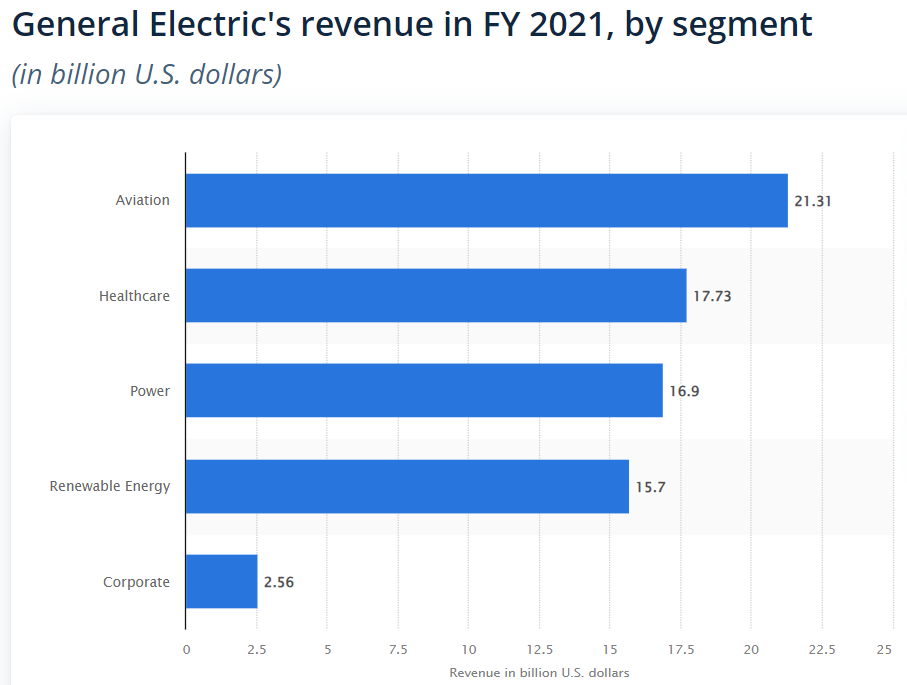
If we think about GE, some people know it as General Electric and identify that with its Power Generating divisions. For others it is a producer of household electrical appliances, or a Medical Imaging company. Few people are aware that GE’s largest division is Aerospace, let by its jet engine manufacturing business.
The aim of this part of the playbook is to provide a consistent message about the company so that salespeople are equipped with the information they need in order to effectively retell the company story.

Case Study 1 Danaher
Danaher describes itself as “a science and technology innovator committed to helping our customers solve complex challenges and improving quality of life around the world”. They actually have 20 different companies many of which still operate under their different brand names. Most customers would be unaware of the storied history of Danaher unless a salesperson were to articulate this history and position it in a way that demonstrates the company’s long history and the value to the customer that being a large and stable company brings.
Danaher was founded in 1984. As its website states, “Danaher takes its name from a tributary of the South Fork Flathead River in western Montana. In the early 1980s, this was the setting for the fishing trip where Steven and Mitchell Rales envisioned a new kind of manufacturing company—one dedicated to continuous improvement and customer satisfaction. The root “Dana” is an ancient Celtic word meaning “swift flowing,” an apt descriptor for the nimble mindset and rapid flow of innovation that have defined Danaher for decades.” Few people are aware that Danaher is headquartered in Washington DC. It has grown from these origins to be a $30B global company employing over 80,000 people worldwide.
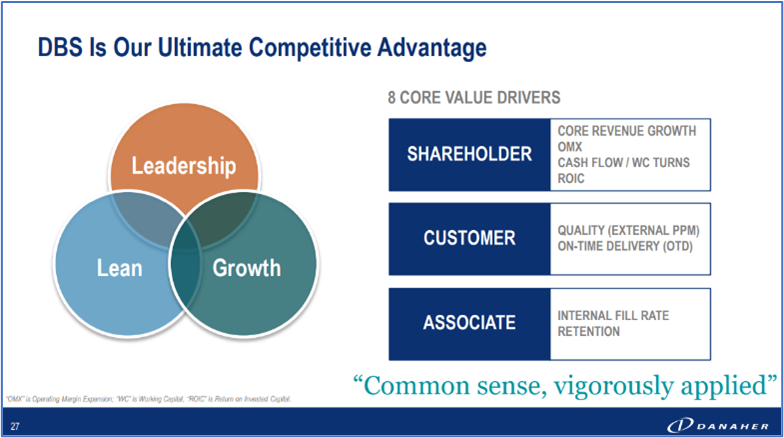
Danaher attributes a huge part of its success and the strength of its corporate culture to what is refers to as DBS, or Danaher Business Systems. This is effectively a Business Playbook on steroids! DBS is the core of everything it does. It even promotes this fact on their website, providing a company overview and describing DBS as “Our Ultimate Competitive Advantage”.
When senior executives join the company, they are ‘schooled’ in the DBS approach until it becomes part of their DNA in much the same way as it is for its more seasoned staff. Everything that the company does is religiously outlined in DBS and the DBS Playbook is what drives the business forward.
2. Sales Team Objectives, Organization and Structure
Having started with a high-level company overview, this part of the Sales Growth Playbook starts to focus on the sales team itself. It should explain to the reader the high-level objectives of the sales team and explain how the team is organized to achieve those objectives. In a large organization, it is not uncommon for members of the sales team to be so focused on their particular region or team that they lose sight of what constitutes the sales team as a whole.
In writing this section you should focus on trying to explain the linked hierarchical nature of the sales objectives. This means that you need to emphasize how each part of the sales team contributes to the overall success. You should parse this information by Geographic region and by Line-of-Business so long as you have that information and the performance of each part is used to reflect the success of the whole team. For example, if the US forms the major part of the business by revenue, sales team members there might not be aware that actually AsiaPac is the fastest-growing region. Similarly people involved in selling legacy solutions need to know about the rapid rise of sales in new product areas. Sharing this information helps everyone feel part of a successful team and keeps people focused on improving their own performance.
In this section you should be clear about the 2 or 3 most important measures of success. These might be different for your company, but they usually include:
Sales Revenue – the overall, top-line, gross sales number, used to illustrate growth and company performance
Profitability/Margin – expressed as a hard number or a percentage of revenue
Market Share – company share of the total market, expressed as a percentage
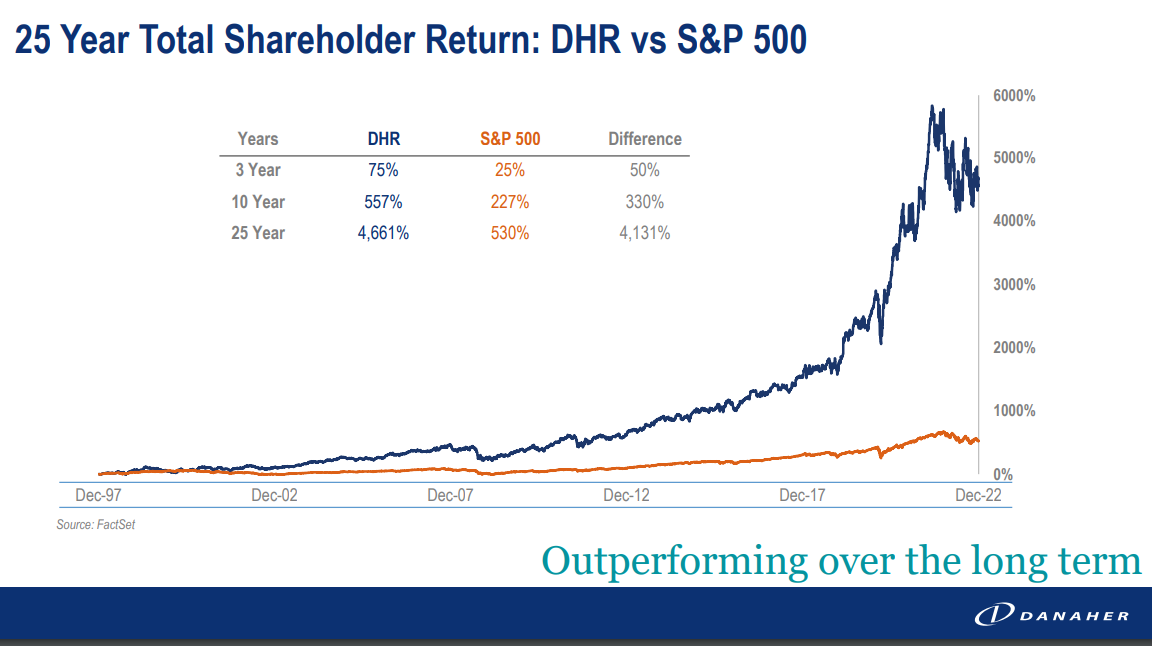
Be aware that you might need to emphasize the importance of other measures if these are top-of-mind and more relevant. Going back to the Danaher example for a moment. One of the company’s key success measures is long-term Total Shareholder Return, which they compare and contrast with the market average by including this slide in their company overview.
Having covered the 2-3 most important over-arching objectives, then include the other measures of success or key sales metrics which may have been put in place to positively influence one or more of the above key success measures. We will discuss these in more detail in a following module, but these might include things like average deal size, conversion ratios or length of sales cycle.
Having covered the sales objectives, you should then summarize the sales organization and structure. The goal is not only to lay out the description of the sales organization but to illustrate and explain how the organization is designed to help achieve the sales goals. Producing information for this part of the playbook is usually a simple matter of re-producing all or part of the company Org Chart. Sometime these are not detailed enough for the entire sales team and you might want to add to what is available.
Another useful addition here is to include the contact information for each member of the team so that people can more easily reach-out to one another when needed for help and support. In my view the best Org Charts are those that include a small photo of each person so that they have a chance to recognize sales team members when visiting the office or a sales conference. A picture tells a thousand words after all. You might need the help of the HR team for this section but don’t be shy about asking for this.
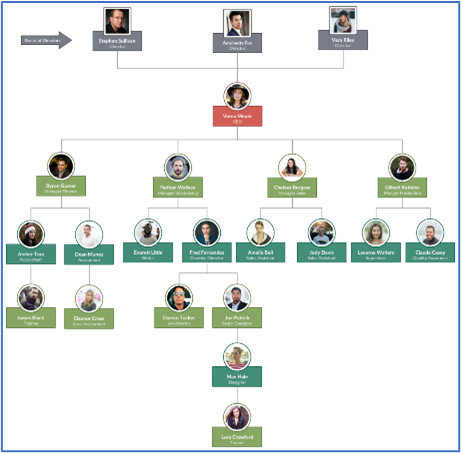
Best practice is to include a photo, job title, contact info and LinkedIn profile for each person. Ask the HR team to help you keep this information up-to-date because sales teams do tend to change composition more frequently than most! The more information that each member of the sales team has about their colleagues, the better they are able to demonstrate to their customers that they are trusted and well-respected member of their own team and someone with whom the customer would enjoy dealing with.
3. Sales Job Roles and Job Descriptions
This final section of the introductory part of your Sales Growth Playbook should complement the information on the Org Chart by providing details of the Job Roles and Job Descriptions for each role in the sales organization. This helps salespeople to understand their own role and to see how that complements the roles of their fellow sales team members. It also serves to educate the rest of the virtual team on the different role of people involved in the sales and customer-facing function.
Your HR team should be able to help you with all of this. Failing that, try looking at your own Careers page which will include a job description for any role for which there is an open position. Once again, put yourself in the shoes of a new-hire. There are many different types of role in a sales team which can have different meanings in different sales organizations. For example, companies have Sales Reps, Sales Executives, Account Managers, Business Development Managers, Account Directors etc. People in these roles can have similar job descriptions in different companies. Don’t assume that the role is obvious to someone new. Provide them with detailed information so that people understand the nuances of your organization.

Exercise 1.6

Course Manual 7: Sales Strategy and Process
This part of the Playbook is all about defining how you actually operate as a sales team. It should provide a new recruit with everything they need to know about how to sell in this company. As you start to develop this part of the playbook, try to imagine that someone joining your sales team had to depend on this section in order to be prepared to go out and sell. They would want to know things like:
1. Who we are? Why we are different?
2. Our Story – how can I deliver a 2-min whiteboard story?
3. What is our Sales Process?
1. Who we are? Why we are different? – Messaging and Positioning
The first part of the above is all about crafting a message and articulating a positioning statement which would explain to a new prospect why they would want to do business with your company. How would you position your business in the mind of the customer? Do not underestimate the value and importance of being able to articulate a simple positioning statement. Probably the best-known author on this subject was Geoffrey Moore. If you have never read his book “Crossing the Chasm”, I recommend it to you. We will discuss this in much more detail in a later workshop when we dive deeper into Value Propositions but its relevance here is in your ability to use this positioning to tell your company story, quickly and succinctly.
In his book, Moore says “Positioning is the single largest influence on the buying decision. It serves as a kind of buyer’s shorthand, shaping not only their final choice but even the way they evaluate alternatives leading to that choice. In other words, evaluations are often simply rationalizations of pre-established positioning” Source: “Crossing the Chasm” – Geoffrey A. Moore, 1991.
Let’s explore this for a moment: positioning is closely associated with ‘branding’. In other words, as Moore states, ‘it shapes a customer’s choice’. If I ask you to tell me “What is the safest car? The Volvo or BMW?” – you will say the Volvo. If I ask you “What is the best handling car? The BMW or the Volvo?” – you will say the BMW. This is the result of the way that these companies have deliberately positioned their value in the minds of the prospective customer. It determines the way people think about these products. If you are a young family, about to choose a new car, and very safety conscious, you are likely to choose a Volvo. But that ignores the fact that in a recent test, the BMW achieved a higher safety ratings for child safety than the Volvo. If you were more interested in buying ‘the ultimate driving machine’, you might be unaware or that the Volvo has beaten the BMW’s in a European racing series. This suggests that facts don’t matter so much as the customer’s perception of what you provide and what you do. Therefore, preparing a simple value message to explain what you do is critical. It also means that this is your opportunity to plant a thought in the mind of the customer which may well determine their ultimate decision to buy.

Case Study – Old Dominion

Old Dominion is a freight trucking business in the US. It started in 1934, when Earl Sr. and Lillian Congdon founded Old Dominion Freight Line in Richmond, Virginia, with one truck. OD now employs over 23,000 people. Their 99.1% on-time delivery shows their “steadfast commitment to keep their promises to customers”. This philosophy of “helping the world keep promises” still guides them to this day as the entire OD family carries on the tradition of helping our customers succeed.

OD understands that, much more than simply moving freight, they are “a direct extension” of their customers business. They know that any delay in delivery impacts the cost of their customer’s supply chain and directly affects their bottom line. Freight problems create “lost productivity, fines and chargebacks, rework or remanufacture of damaged goods, administrative costs from claims management, customer service issues … all of which results in lost sales and lost customers.” They have even had a book written about the company, on which their positioning statement is the title!
It is interesting that a freight company like OD does not describe itself according to ‘what’ is does (i.e. is transports freight) but more by ‘why’ it does what it does. You might expect their strap line to be something more like “On-time Freight Delivery” but it’s not. Imagine you are a salesperson for OD and someone asks you what your company does. You don’t say “We are a national trucking company which can collect and deliver your goods anywhere in the country through our 256 service centers”, who cares about that?
 You say, “We help the world keep promises!”, “oh, that sounds interesting, what do you mean?”, “Well for last 89 years, we have been focused on helping our customers keep their promises to their customers by ensuring that their products are delivered exactly where and when they were promised. We are committed to your success”.
You say, “We help the world keep promises!”, “oh, that sounds interesting, what do you mean?”, “Well for last 89 years, we have been focused on helping our customers keep their promises to their customers by ensuring that their products are delivered exactly where and when they were promised. We are committed to your success”.
2. Your Story
Take a few moments and think about how you would describe your company to a new prospect. What would you want them to take away from the conversation? What is the single most important thing you would would want them to remember?
As Jeff Bezos, founder of Amazon, says “Branding is what people say about you when you’re not in the room”.
Whiteboarding
One very useful sales technique that you should seek to master is the ability to do a short and simple whiteboard or flipchart to explain what you do.
Imagine you are in a sales meeting with the senior executive of a new prospect, someone who does not know your company or what you do. You are in their conference room or meeting room, one which has a large whiteboard or flipchart on the wall.
They ask you “Why should we do business with you?” … or some slightly different version of that same question. You decide to stand up, take the marker pen and you have 2 minutes to tell the story. What would you say?
If you would like some more ideas on how to improve your messaging and positioning you should also consider Simon Sinek’s ideas on “Getting to WHY?” Sinek says repeatedly that “people don’t buy what you do, they buy why you do it”. Sinek delivered one of the most popular TED Talks of all time, with more than 56 million views and counting.
3. Sales Process
Having clearly defined the company purpose, your Sales Growth Playbook should now define your sales process. The objective here is to make sure that everyone in the extended virtual team understands the different stages in the sales cycle and who is responsible for doing what. For example, you should make it clear exactly when the ‘handover’ occurs as a sales opportunity passes from one team to another. The most obvious example of this relates to the transfer from Marketing to Sales when a Lead becomes a real opportunity. Another occurs after the close of the opportunity, when, if it is ‘Closed Won’, responsibility may pass to the ‘After-Sales’ Customer Success team.
All of this works best if it is aligned with the structure of the CRM system. This is important from the perspective of Sales Reporting and also for Analytics. We will cover the CRM system and other sales tools in another module later today, and we will also look more closely at the sales metrics which will relate to the sales cycle or sales process. Measuring sales velocity (the speed at which a sales opportunity progresses through the sales cycle) is an important measure of the efficiency and effectiveness of the entire customer-facing team.
Outlining your Sales Process is usually best done using some sort of flow diagram to illustrate the ‘flow’ of a sale from lead origination to close and renewal. Some people call this their sales cycle, others refer to it as their selling process. Either way, it’s basically the same thing. It can be a simple 5-step process, like this:

Or, depending on the company and the type of solution that you sell, your sales process might have more steps or stages or sub-stages and look something like this:

Other companies will describe their process in more detail with detailed definition for each stage, for example:
image too detailed
Let’s try to break this down into the most common stages. Your role, as you develop your own Sales Growth Playbook, will be to define your own process and to describe each stage in detail. Here’s a template that you could use. Feel free to change the terminology to suit your own situation.
The sales process usually starts with a marketing function, namely to gather potential leads and turn these into real sales opportunities. Clearly the different roles need to be defined so that there are clear expectations and a smooth handover. When things go wrong in this part of the process it is usually because the marketing team feel they have passed a valid lead to the sales organization and the sales organization do not feel that the lead was sufficiently qualified to warrant follow-up. We will outline a process here in which Marketing is responsible for a Lead from the time it starts, what I refer to as the “above the funnel” activity, until it becomes an MQL or ‘Marketing Qualified Lead’. At this point it transfers to the sales team.
Here are the stages:

Marketing Lead – these are leads or ‘ideas’ for what might be a prospective new customer. They can come from a variety of sources. The most common of these is now “web-leads”. These are the result of marketing and promotional activity which has brought a prospective customer to view the website. These people may be just browsing, they may be seriously interested, or they might even be your competitors. Other sources of leads would be from trade-shows, mail or email campaigns, advertising and promotional events. The marketing role is to validate whether or not the lead is valid.
Marketing Qualified Lead (MQL) – the marketing lead has been contacted in some way, electronically or by phone, and has been confirmed as someone who is interested in potentially buying something from your company. The MQL registers customer interest. It usually means that the marketing team, albeit through a ‘bot’ have established some kind of dialogue with the prospect. It is not associated with ‘intent’. In other words, there is interest but as yet there may be no timeline and no budget to indicate a propensity to buy. At this stage the MQL is passed to the sales team, normally to a telephone sales representative TSR or Inside Sales Representative (ISR).
Sales Qualified Lead (SQL) – having received the MQL, the role of the ISR is to qualify the lead in terms of a number of criteria. There are various formulae for this, and we will use BANT as the basis for this evaluation. BANT is required in order for an MQL to become a SQL. This criteria is Budget, Authority, Need and Timing. At this stage, the ISR needs to establish contact with the person (the lead) to test how serious they are and to determine their propensity to buy. This is an important stage in the sales process because after this point it will be passed to the other members of the sales team and the cost of sale increases at this point.
At this stage, the criteria will look something like this:
Budget – one of the key issues here is to recognize that this is NOT about whether or not a budget for this solution has been developed in the prior year, in other words the customer has been planning this for a long time. The key issue is whether or not the customer is likely to be able to fund this new project and whether they have the access to the funds necessary. You need to answer questions like: Is the project funded to make an outside purchase? What level of funding is available? Are there any timing issues in terms of budget/funding availability (e.g. this year/next year; this quarter/next quarter)?
Authority – at this early stage we may not have ben able to meet with the person who has the ultimate authority to authorize the purchase, but we need to identify who that person is. You need to be able to answer questions like: Who owns the business initiative? Who is the decision-maker? Who owns the funds? Who will sign?
Need – early in the sales cycle the ISR needs to establish a clear idea of why the customer would buy this solution. It answers the question regarding ‘what problem are we solving?’. The ISR needs to understand WHY will the customer buy? What is their pain? What happens if they do nothing?
Timing – we must recognize that many customers want to improve things, they want to have a better, more up-to-date solution. But the real question is when? The ISR needs to establish a clear intent to buy within a specified period of time. The questions are: What is their timeframe? Is there a compelling event? Why buy they now? What happens if they delay?
Having identified BANT, the SQL now becomes a real Sales Opportunity.
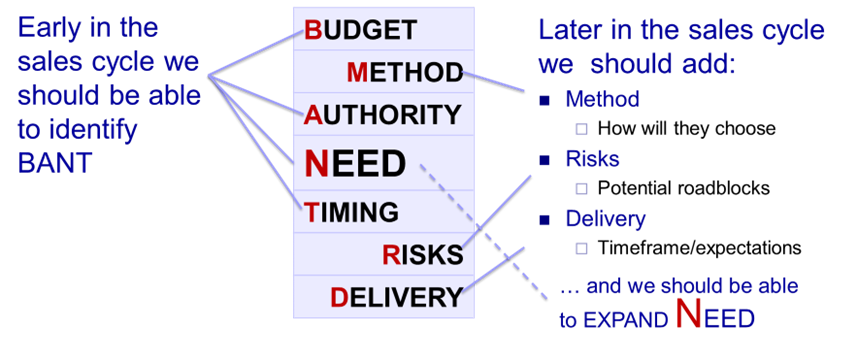
Sales Opportunity
If the lead passes the SQL qualification it now becomes a real opportunity. This should be signaled by the fact that it is now entering the sales forecasting process within the CRM. It means that the lead now has a projected close date and a projected value in terms of sales revenue. Having established the basics of BANT, the opportunity becomes real. It now warrant significantly more sales effort. In a complex sales scenario, this is where the sales account manager gets involved and this opportunity demands their time and attention.
The sales opportunity is now in the Discovery Phase. The focus is on developing the BANT criteria in more detail and starting to understand the remainder of the BMANTRD sales opportunity qualification process. BMANTRD is designed to answer 3 simple questions:
Why they buy (something)?
Will they buy from us (as opposed to the competition)?
Will they buy NOW (as opposed to next quarter, next year etc)?
Throughout this Discovery Phase the sales team should also be more clearly defining Need and if possible, turning the latent pain of the perceived need into an acute pain which demands early treatment in the form of a purchase of our products and services. In reality, every part of the BANT process needs to re-evaluated and enhanced. The Budget and Authority needs to be more clearly defined. In many opportunities, this is where the sales team will identify the fact that there are many, many more people involved in the buying process than they first thought. They may also identify that the person who they thought had the authority to buy is actually more of a recommender and that the ultimate authority lies elsewhere.
The reason to add M for Method at this stage is to define exactly ‘how’ this customer will go about making the decision to buy. Does the decision rest in one department/ which other departments are involved. What is the process for getting their input? Can we get to meet all of these stakeholders?

As we start to understand more about the customer’s motivation and inclination to buy we can start to add our perception on the potential Risks to our being able to close the deal. The R of BMANTRD relates to answering questions like: What are the barriers to winning? What actions are needed to eliminate these risks? We need to consider both internal and external risks. For example, one risk might be the risk of the customer doing nothing. What I call “No Decision Inc” or NDI is the most significant risk to any sale. Studies show that No Decision is the #1 reason why sales opportunities do not result in a win. Some studies show the figure is around 40% of opportunities, others show it as high as 66%. In reality the actual percentage really depends on the stage at which we recognize that the customer is not going to make a decision to buy. Remember, no decision is actually in itself a decision. In other words the customer is making a decision NOT to go ahead and buy something right now.
Why would they do that? Part of the answer lies in gaining a better understanding of the R=Risks element of the equation.
The final part of the BMANTRD qualification lies in gaining a full understanding of the Delivery phase of the solution. The most common mistake that salespeople make is to assume that the delivery corresponds to the Close date. Not true. Delivery is all about how and when the customer intends to take delivery of the solution and when they plan to start adoption and implementation. In the Delivery phase, the sales team needs to understand: When does the customer NEED to start the use of the new solution? Based on that, How will you deliver the project? All at once or in stages? What is the “Scheduled” date? “Go Live” date? “Installation” date? Each of these dates have different meanings to different companies. Be sure to define exactly what you mean by each of these steps in the delivery process.
Solution Design
Having qualified the opportunity, the sales team moves forward with the design of the actual solution. There may be choices that the customer needs to make here. There may be customization options which could represent an opportunity to up-sell. This is usually the stage in which other members of the customer-facing team need to get involved.
In a complex IT sale for example, Sales Engineers (SE’s) are likely to be required to better understand the technical aspects of the required solution and to put together a product demo for the technical buyers. Obtaining the technical sign-off used to be regarded as the required step in the process, now most companies realize this is just one step, not the single route to a win.
For many companies this stage requires further detailed explanation because it might involve a longer, more protracted period of testing. Customers will likely ask for some sort of POC (Proof of Concept), or POV (Proof of Value). Traditionally these steps were seen a “Pilot’s”, some were paid, some were unpaid. We will cover these in more detail in a later section.
Proposal
Providing the customer with an initial proposal is clearly a necessary and important part of the process. It is another thing which can be seen as a key milestone in the process. You should be careful not to confuse a pricing request with a request for a formal proposal. Any customer, whether interested or not, is likely to ask the simple question “How much would this cost?”. Some people would argue that at one level it represents a ‘buying signal’ because it shows a customer’s interest in what you have to offer. However it does not indicate a level of real inteesrt and is used by many customers to halt the sales process there and then. “Oh, we couldn’t afford that, we have no budget” is the immediate and typical response.
So we need to be clear that the Proposal stage is not a simple pricing request. This stage in the sales process signifies that based on all of the prior conversations, the sharing of the outline pricing etc, the customer now wants, and needs, a formal proposal. We will deal with the selling skills aspects of how to handle these differing requests in a later workshop. Here we are only interested in defining the terms for the purposes of the sales process.
Negotiation
Having submitted our Proposal to the customer, we now start the Negotiation phase of the sales cycle. Most salespeople underestimate how long this part of the process can take, especially in a complex sale involving 10-20 people in the customer buying team. One of the first questions to address here is therefore the definition of exactly whom the sales team should be negotiating with. We should also not start to negotiate until we have established that we are the preferred supplier, and the customer has chosen us over the competition.
One of the best ways to manage this stage in the sales cycle is to use a Mutual Action Plan (MAP). A MAP is a detailed plan for everything that has to be done on both sides in order that you make the sale, by the date you want, and the customer gets their solution, by the date they need it. More on this later in the program.
Customers like to keep 2-3 potential suppliers involved at this stage but we should resist the temptation to negotiate until we have established clear customer preference to proceed with our solution over the competition. The negotiation phase will involve detailed conversations and several iterations of contract redlines before an agreement can be reached. This usually involved new teams on both sides of the equation, their legal team and our legal team, their procurement team and our management team.
Close
“Signing the order” is only one step in this phase of the sales cycle. Closing involves a number of administrative and operational activities to ensure a smooth hand-over to the post-sales team. You should focus on obtaining any other information needed, like invoicing information and delivery addresses. In many cases, a signed order does not equate to a Purchase Order, and that can be another series of meetings and involve many days of delay. Obtaining the PO and getting the accurate billing information is key.
The sales account manager should introduce the Customer Success team who will be responsible for the customer going forward and set-up a joint meeting with the customer implementation team. Remember that in many cases, the people actually implementing the solution may not have been involved to any great extent in the buying process.
A good salesperson will also establish a process of Quarterly Business Reviews with the customer and the CS team to discuss progress and to highlight successes or challenges. These create a great opportunity for the next sale, whether that be an extension of the existing project, and expansion into new areas or a new project altogether. Remember the customer wants your insight and ideas on how to improve even further.

Exercise 1.7

Course Manual 8: Go-To-Market Strategy
This part of the Playbook is all about defining the specific strategy in relation to the different Products and Services that you offer and also how you operate as a sales team with different departments in the company.
1. Products and Services
a. Product Value Propositions (by Segment, Job Title, Solution)
b. Pricing
c. New products
2. Rules of Engagement
a. Pilots, Proofs of Concept, Proofs of Value
b. Channel Strategy
1. Products and Services
Your Marketing or Product Marketing team will likely be the source of all of the information that you need in this section. Insert links to PDFs of your product information sheets and links to PowerPoint presentations.
It is important to remember that the role of the marketing team is to create ‘standard’ presentations, other documentation and sales collateral which is generic in nature and is intended for use by a wide variety of people. For the benefit of the new -hire salesperson and as reference documents for the future, you should include as much information as is available and to nominate someone in the marketing function to keep the documents themselves and links to those document sup-to-date so that everyone is accessing the latest version.
For many companies involved in making a transition in the way they sell, from being a product-focused sales team to being more consultative, it can be a challenge to bring the marketing team along with you. You should appreciate that there is a difference in your roles and objectives. Marketing’s aim in producing the product flyers and standard presentations is to use them as promotional materials which may appeal to a wide audience. The Sales role is to refine the message to suit a specific customer and even to create different versions for different people in the buying team within the same customer. As we will see in the discussion of Buyer Personas in the next section, your company should be able to produce collateral that will help in the majority of cases, but there will always be a need for personalization. Don’t be afraid to educate the Marketing team in terms of what you need, but recognize
If your company is marketing and selling to several different Lines of Business (for example, Telecoms, Healthcare, Public Sector) you should include in your Sales Growth Playbook the documents you need to address each specific market. As we will see in the “Sales Plays” section, the positioning and the messaging can be very different for different market segments.
Your role in the sales team is to take these ‘boiler plate’ documents and customize them to suit each customer, adapting the core message to align with exactly what the customer needs and reflecting your prior dialogue with the customer team.
Pricing
Your Sales Growth Playbook should include all the latest information in relation to your Pricing strategy. This is not simply Price Lists but also the strategy for pricing. You should include any information relating to standard discounting policies and any scheduled price reviews or price increases.
New Products
All of your existing products and services should be included above. In addition, you may need to add a specific section relating to new product launches, especially if these relate to a departure from your existing modus operandi. For example, the launch of a new product may require different positioning and messaging strategy. It might require a selling process to different types of buyer and the value proposition may be different. The sales team needs to be educated about these things in advance and the customer may need some re-education too.
Your Sales Growth Playbook should be a forward-looking document in this regard. It needs to prepare sales teams and customers for an upcoming product launch. The timing may vary. For some companies a 2 to 3-month window may be sufficient, in other situations, you may need a year or more. For example, many software companies have made a transition to a cloud-based, subscription model in relation to the sale of their solutions. This requires a carefully managed transition in which the sales teams understand how to articulate the value of the new approach and the customers have time to consider how they want to consume the product.

Case Study – Adobe

Photoshop was originally developed in 1987 by two brothers for their own personal use. What started as a simple program was licensed by Adobe who created an enhanced version for commercial distribution. The program was sold with a printed manual and was available on a small floppy disc. Over time the program was developed further, and functionality was greatly enhanced. Adobe made its name, and its fortune on the back of selling ever more complex versions of Photoshop.
Eventually, as the value of this solution grew and grew, Adobe was able to charge customers $999 for a single license to the Photoshop product. This was excellent business and created huge revenue, the popularity of digital imagery was growing rapidly at the same time. Revenues were increasing. But there was a problem. They realized that their go-to-market model, selling a high-value perpetual license, meant that they were maximizing the revenue they could obtain from a customer at the beginning of their relationship and then they had little or nothing else to sell them unless they decided that they needed to buy another license, or in the case of a corporate sale, many more licenses. The problem was that in order to grow, they had to continually seek new customers to grow their customer base.

Initially they decided to solve this problem by selling upgraded versions. The aim was to entice customers to buy again because the new version had more value and justified more investment. It worked, but only to a limited degree. Many customers realized that they could ‘make-do’ with what they had and were unwilling to pay the extra for the extra value.
The move to a subscription model changed everything, and it was drastic. Instead of selling their new Photoshop Suite for $999 they offered a monthly subscription of just $9.99 per month. This was 1000x cheaper. But it was also $99 per year, and thus started the power of the subscription model. Now they had customers for a much longer period of time. As new customers came on board, their yearly recurring revenue increased. Soon the renewal business was higher than the new business, but that was fine, because eventually they reached a point at which their total revenue surpassed where they were originally. The new subscription pricing model also allowed Adobe to upsell the customer on new features, annual improvements and new products. They had created a much lower barrier to entry for the customer and a much more stable long-tern revenue stream.
2. Rules of Engagement
This next section of the Sales Growth Playbook seeks to define how the sales team is to operate with other departments within the company, and potentially with other third-party partners too. There are numerous scenarios in which the sales team either draws from, or depends on, the help and support of other departments within the company. These situations can always be a source of friction and concern. If teams operate in silos and do not communicate well with each other, the likely outcome is frustration and disappointment. Hence this section of the playbook is designed to lay out the Rules of Engagement so that everyone understands what is expected of the other.
You should decide how you want to codify these interactions. Usually this is done either by focusing on the interactions between any two departments, or by defining interactions required at different stages in the sales cycle or at specific milestones. We will use the latter to provide examples here.
Product Demonstrations
Sales and Sales Engineering need to work together to provide an effective product demo to the customer. As a sales team, you should consider all the questions that a Sales Engineer (SE) might have if they were being asked to deliver a Product Demo. It’s important to realize that in a product-focused, transactional sales environment, the SE would expect very little information, and they would need very little. After all, their role is simply to demo the product, right? Well, not quite. In a more customer-focused, consultative sales environment, it is important that everyone in the customer-facing team understand what the customer is trying to achieve, and they must collectively work together to illustrate how the customer can success using their solution. Therefore, in this scenario, the SE needs much more help and briefing. It is the responsibility of the sales account manager to provide the information, and it is the responsibility of the SE to digest that information and adopt their ‘demo’ accordingly.

You might consider designing a Demo Briefing document for the SE and also including the SE in your Pre-Call Planning (at the very least, sharing the Consultative Sales Call Planner with them). In some cases, you may be asking the SE to conduct a product demonstration single-handedly. In other words, the salesperson is not present. In this case it is even more important that you set clear objectives for the meeting and that you have a clearly defined process.
Falling under the ‘rules of engagement’ topic, your Sales Growth Playbook should define the pre-requisites for your company to provide a product demo to a customer. Many sales organizations suffer from a lack of productivity because the salespeople ask SE’s to deliver product demo’s to unqualified customers. As we learned in the last section, BANT should be defined before a demo is scheduled. You should not be wasting the valuable time of your sales engineers by asking them to do demo’s to poorly qualified buyers.
Proof of Concept/Proof of Value
The next step-up in terms of resource allocation and potential frustration lies in the sales teams asking the sales engineering team to undertake a Pilot, or Proof of Concept (POC), or Proof of Value (POV). Best practice is that the customer is asked to pay for this process, often receiving a credit back if they go ahead with the purchase. The practice of offering POCs/POVs has emerged for the IT industry where the increasing complexity of solutions and the increased sensitivity that customers have to the performance of their IT systems means that they want to see that a proposed solution will actually work effectively in their IT environment. There are so many variables that they want to see for themselves that although a solution is already working in Company X, they want to see it working in their business before they make a commitment to a full roll-out.
This complexity brings its own challenges. It involved your SE team in a great deal of work. Work which is only justified if the customer is well qualified and BMANTRD is well understood. Before agreeing to provide a POC/POV the sales team should be able to secure a verbal order from the customer. In other words: “if everything goes well and as expected, we will commit to buy your solution at the price agreed”. If they cannot say ‘yes’ to this, it means they still have other doubts and they are not ready for a POC. As such it becomes clear that there are some clear pre-requisites to ordering a POC, for example:
a. The Sales Opportunity should at least be at the Validation or Proposal Stage
b. BMANTRD should be defined, and you should add to this a clear definition of the measures of success for the POC/POV itself. In other words you need to clearly define the success criteria so there is no post POC discussion with the customer about whether or not the POC delivered the results expected.
c. There should be a full briefing by the Account Manager to the SE and SE management to explain the rationale for why the customer would buy, what problem they are looking to solve and what the customer expectations are.
Renewals
As we learned in the case of Adobe and as we will see below, many companies rely heavily on customer Renewals in order to achieve their annual sales targets. Particularly in a company with a subscription-based sales model, renewals are the key to future success. In the case of many large B2B corporate sales, the sale of the product or service is contracted for a period of 3 years. (In most cases, companies have moved away from the perpetual license model). The key question then becomes “How do you manage the renewal at the end of the 3 years?”
Is this a sales function or a Customer Success function? Does it depend on the size of the renewal or the size of the customer? Have you worked out the process? When do you start to talk to the customer about a renewal? Who starts that conversation?
These are all questions which we will address in detail shortly, but the important point here is that you should document the process in the sales growth playbook so that everyone understands what it should be.
Service Contracts
In many cases these can be handled in much the same way as the renewals but there are usually key differences. For example, complex products might be sold with a specified Product Warranty period. That period may be the result of negotiation at the time of the initial sale. Either way, the responsibility to execute on the provision of Customer Service and technical Support usually resides with the Service Organization (not Customer Success as is the case with Renewals).

In this case, the Service team becomes the sales teams key partner and we need to define roles in much the same way. i.e. who should approach the customer as they approach the end of their warranty period? Sales or Service? What do you do about the potential conflict of interest where a sales team sees this as an opportunity to sell a product upgrade but the service team sees this as an opportunity to sell a long-term service contract? Your Sales Growth playbook should outline your Sales Play for such a scenario.
Consulting Services
Another internal partner to the sales team in many companies is the Consulting Services organization. These services may form part of a larger sale or, in the case of a services/consulting company, these services are the solution itself. Either way, your Sales Growth Playbook should define exactly who has responsibility for what during the sales process and thereafter.
Perhaps the most common cause of conflict in this scenario relates to the ‘ownership’ of the account once the sale has happened. In some companies, the sales team remains as the ‘sales face’ of the company. In others, the senior partner of the consulting team assumes the overall account relationship responsibility post sale and the responsibility for future sales and upgrades and extensions lies with them.
Third Party Partners
In many sales organizations, their go-to-market strategy is completely dependent on working with external third parties. In the case of IGEL for example, they are a 100% channel company. They have their own sales team and SE’s but all of the implementations are handled by their third-party partners.
Other companies have a Hybrid model where some sectors of the market are handled direct, and others are handled by resellers or distributors. Herein lies a source of potential conflict of the process for handling business is not clearly understood and agreed by both parties. Companies which have a hybrid model will have an internal team of Channel Account Managers (CAMs) whose job it is to motivate and manage their third-party channel partners of achieve as much as possible for themselves and for the vendor organization. These CAM’s should be liaising with the sales team to maximize the success of both sales functions, internal and indirect.
Your company might also have Strategic Partners or Alliances. The relationship with these partners is likely to be different from that with the resellers and distributors but the potential problems are the same. Thes issues usually focus on who is entitled to sell to whom and which accounts, if any are ‘off-limits’ to the other sales team.
Your Sales growth Playbook should clearly define the sales territories and Rules of Engagement for how the third-party companies are expected to operate and also how your own sales team is supposed to interact with the partners.

Exercise 1.8

Course Manual 9: Strategic Sales Plays
Within your Sales Growth Playbook you should have a section that provides a number of ‘Sales Plays’ which will direct you and your team in how to handle specific sales situations. As we learned in the first course manual earlier, as in sports, in sales we can develop plays which are Strategic and some which are more Tactical. We will start by looking at the more Strategic and then move to the more Tactical.
Another way to look at this approach is to think in terms of the 3 most common Strategic Sales Plays which are LAND, EXPAND, RENEW (LER). By using this LER process, we can develop a strategy for how we will develop New Business, as well as how we will grow existing business and retain current customers.
Some salespeople may only be focused on one element of the LER process. For example, companies may have dedicated ‘new business’ salespeople, often referred to as “Hunters”, and other sales teams who focus more on the development of existing business, the “Farmers”. Both roles are essential for a high-functioning sales organization and although some of the skills required in each role are the same, there are some things which are specific to one role or the other.
LAND = NEW BUSINESS SALES
Let’s start by looking at how we find and close new business. Firstly, your playbook needs to define exactly what constitutes ‘new’. This may appear simple at first sight, but it rapidly gets more complicated when we consider sales campaigns to large multi-national companies, conglomerates and large enterprises or government organizations. For example, if you are successful in selling to the Healthcare division of Siemens, does that mean that sales to the Power Engineering division is considered ‘new’ or ‘existing’ business?
You need to define the criteria. If you sell to FedEx in Europe, does that mean that sales to FedEx in the USA is new business or an expansion? If you sell to Santander Bank in UK, is a sale to Santander in Spain an expansion or new business. There are no simple answers. Best practice is to define your process based on one of the following:
1. How and where the customer decision is made – in other words, if the customer ultimately makes the buying decision within a different division or a different country, then each of those can be considered a ‘new’ business win.
2. PO’s, Billing and Invoicing – if the customer raises Purchase Orders for each sale from two separate entities and your billing or invoicing is to different legal entities, then you will probably consider each of these as a separate ‘Account’ and treat each one as ‘new’ business.
3. Lead Relationship – You may have an organizational structure in which there is a Global Account Team. In this case there is one Account Manager responsible for the entire company relationship and they lead virtual sales teams in different geographies or lines of business. In this case, most of the ‘new’ business sold within the global account is likely to considered as an Expansion sale.
Having clarified the terminology, you now need to develop the Sales Play itself. In the case of NEW or LAND, you should start by developing a detailed analysis of the Target Addressable Market (TAM) for the solutions you sell. You can have an overall TAM, and you can break these down into sub-sets according to different solutions, products and services that you sell. Your Marketing department should be able to help you with this analysis and, if you are lucky, it may already exist. The Target Addressable Market is a measure of the total revenue opportunity that exists for what you sell in a specific market. For example, you can have a TAM defined by country. You can define a TAM by industry or line of business. How you choose to do this is up to you. At the corporate level, your Chief Sales Officer or Chief marketing Officer will almost certainly have developed an outline of the TAM to include this in the company Strategic Plan.
Be aware however that in many cases the TAM as defined by the Marketing team or the CEO is focused purely on revenue numbers. In other words they may be able to tell you that the TAM is $500M and your current market share is $20M, so you have 4% market penetration and the Whitespace is huge. Those facts may be true, but they are not very helpful in developing an actionable Sales Play. You need specifics.
The real purpose of doing the TAM analysis for you in the sales team is the define the total size of the market opportunity and then to identify the “White Space”. White Space is essentially shorthand for the space where you currently do not have business. This does not mean that you can win 100% of this business. You have to set realistic targets about what you think is achievable. The White Space helps you to focus on the areas where there is indeed ‘new business potential’.
You can further refine your White Space Analysis by focusing on this by geography or by solution or product line. In Sales, our analysis of TAM and White Space needs to get down to the Account level. In other words we need to identify the revenue opportunity in terms of Company Names that we can target, and the by names of the individual personas that we will actually need to sell to.
Knowing where your whitespace is, and how large it is, can help you develop a fresh perspective on the size of the sales opportunity that you have, and it can provide you with a roadmap of where to focus your time and energy. This can be particularly useful in the situation where a salesperson or sales team has spent many months or years trying to develop new business in a particular territory and they are finding it more and more difficult. Just by doing the TAM and White Space analysis they may be able to find new areas of opportunity which they have been blinkered to or unaware of.
The end result of this stage in the process is to define a Target list which might look something like this:
Whitespace by product:
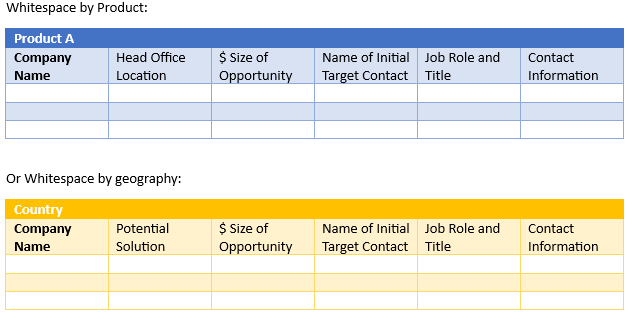
Having defined the target list, you have addressed the Strategic element of your planning, you can now develop your more detailed Tactical Sales Play. The sales play should define how you intend to ‘LAND’ in these new accounts and win new business. It is up to you to define the process that works best for your team. For example:
Sales Play 1 – Cold Outreach
1. Marketing Team conducts outreach through advertising and promotion to gain leads
2. Marketing Team engages with Leads through social media
3. Web leads are followed up by MDR to create a new Marketing Qualified Lead (MQL)
4. ISR takes leads and starts Outbound calling campaign
5. ISR passes Sales Qualified Lead (SQL) to Account Manager (AM) for follow-up
6. AM uses phone, social and direct mail for outreach
As you refine your Sales Plays later in this series of workshops you will be able to add more and more details to each ‘Play’. This detail will include your Value Messaging, the Consultative Questions you will ask at different stages to different Persona, the Objections or Customer Questions that you think you will need to address and so on. The purpose here is to help to structure the basic elements of the sales growth playbook so you can build on this as we go forward in the program.
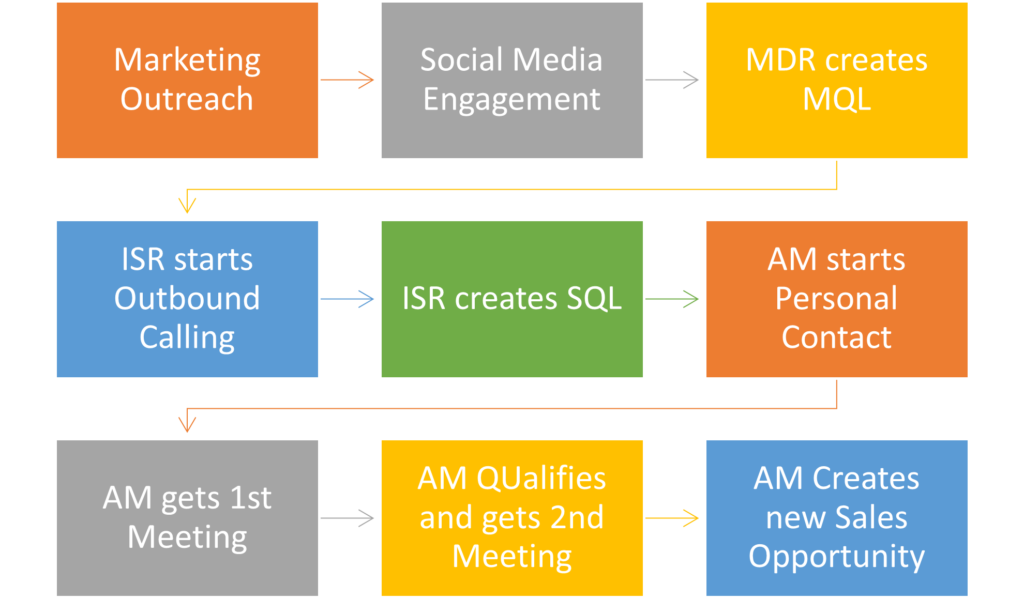
There are other versions of this too. Again you decide, for example
5. ISR keeps calling and emailing until they can make an appointment for the Account Manager
6. AM has first phone meeting
7. AM has a second web-meeting or in-person, onsite meeting
8. AM manages sales campaign
Sales Play 2 – Account-Based Marketing (ABM)
1. Sales and marketing team agree a Target Account List
2. Account Manager and Marketing Support team are defined
3. Marketing initiates Persona-based ‘rifle’ campaign via social media, email and phone to targeted people in Prospect.
4. AM starts individual contact campaign using a Prospecting Cadence (more on this in a later workshop)
5. Marketing creates customized sales collateral based on targeted persona.
6. AM secures first meeting or passes lead to ISR for constant, on-going outreach.
7. AM targets next Prospect, and so on.
EXPAND
The next section of your Sales Plays will relate to the strategy and tactics for the expansion of existing business. Expansion in this sense can be the sale of the same solution to a wider community within the customer or it could relate to the sale of different products and services to the same customer group. Either way, it means that you need a strategy for how you will expand your initial business win within the account.
The importance of defining the roles in this scenario becomes more critical because, by definition, the customer is now an existing customer of your business and other departments within your company will almost certainly have started to develop a relationship with people in the customer too. Your Customer Success and onboarding team will have worked with the customer to implement the initial solution that was sold. The Customer Service and Support team may have been engaged to deal with service or warranty issues with your products. Therefore, it is important to define who owns the ongoing sales activity.
In most companies, the sales aspect will be owned by the sales team. As we have seen on the Consultative Sales Cycle, this is an important opportunity for you as the salespeople to stay engaged with the customer post-sale in order to explore new ideas and opportunities for business expansion. Data shows that it is 8 times easier to sell an expansion of business to an existing customer than it is to sell to a new customer. What this really means is that the cost of a sale, i.e. the time and effort required to sell to a new customer, is 8x what it is for a new sale to an existing customer. Therefore, you should develop your EXPAND sales play to be as effective as possible because it will mean that you have an easier route to making your sales target and achieving quota.

Given that other members of your team are now part of the customer-facing team, you should ensure that you adopt the key role of Virtual Team Leader, marshalling all of your resources to achieve the objective of increased sales within this account. That means briefing them on your sales play, explaining key objectives, asking for specific help and support in the sales process. Your virtual team become your eyes and ears within the account and a key source of information and insight in how you can improve the overall sales process. Involve your team as much as you can. Ask for their input. Quiz them on their knowledge of the account and look for ideas on new people to call on in the customer team.
Developing your EXPAND strategy should be very closely related to your LAND strategy. For example, in many companies, salespeople use a ‘Trojan Horse’ approach to business development within an account. This means you deliberately start small and seek to grow the business over time. The rationale that lies behind many salespeople taking this approach is that they believe it is easier to sell a smaller deal than it is to sell a larger deal. That’s probably true. Therefore, they focus first and foremost on selling that small deal and then seek to expand thereafter.
This approach clearly has benefits: it means that the initial sales cycle tends to be shorter. Smaller deals often involve fewer people in the customer buying team because the solution is smaller scale and involves fewer stakeholders. This usually leads to better short-term revenue and, as we have seen, it means that follow-on sales are easier and lower cost.
However, a word of caution here. All may not be as it seems. If you invest more time and energy to close the larger initial sale, you may find that expanding that sale is much easier. If you convince a broader cross-section of customer management that they need your solution, it is more likely that they will be onboard for a later expansion. Many companies have tracked the differences between the two approaches. Data suggests that in reality, the larger the initial sale that you make to a company, the larger the overall revenue over time. In other words, a LAND and EXPAND strategy which is based on a larger initial sale and smaller expansions thereafter will result in higher total account revenue than a LAND and EXPAND where the initial sale is smaller and subsequent expansions are larger. “Go big or go home!” was the way one Sales Manager would coach his team.
Whichever approach you deem to be the best for your company, make sure you define a Sales Play that is clearly understood by all parties involved. One classic example of this is the sale of a so-called ‘Pilot’ program. ‘Pilots’ are intended to be a Proof of Concept (POC) or Proof of Value (POV). In other words, the customer is not totally convinced, and they want to try it out first. I know one sales manager in my past who used to argue that the sale of a pilot simply means that you were unable to sell value well enough to convince the customer. There is certainly some truth in that. Another key element of this relates to whether or not the customer is paying for a Pilot. An unpaid Pilot, POC or POV is basically a freebie for the customer. They have very little ‘skin in the game’ and they may not take the pilot seriously. We would always recommend that a Pilot is a chargeable event. POCs and POVs should be paid for. It is also critical that you establish the success criteria for the pilot and to secure an understanding that the Pilot is actually Phase 1 of an implementation wherein the customer has already decided to proceed, is already committed to proceed, if the results of the pilot meet the pre-agreed objectives.

Case Study – Wells Fargo Bank

Wells Fargo bank is one of the largest financial institutions in North America. They were founded during the Gold Rush to provide a safe haven for people and their goods as the pioneers emigrated westward to California. They were instrumental in taking care of valuable cargo during the gold boom and their essayers would measure and value the California gold, provide cash value to the prospectors and ship the gold bars around the world. Although they no longer deal in raw gold, smelting and stagecoaches, Wells Fargo is still a major force in the finance industry.
Wells Fargo realized that one of the keys to retaining customers and growing the volume of business they were able to do with any customer was to sell them as many different products as they could. Their LAND and EXPAND strategy was very clear, and well aligned with their metrics, and their sales compensation systems. (In fact, so much so that they later got into trouble with regulators because some salespeople were encouraged to open bogus accounts for companies in order to achieve their sales targets – but that’s another story!).
Wells Fargo knew that if they could just ‘get a foot in the door’ with a large new customer, they would be able develop the relationship and win more business. Their services offerings included Consumer Banking and Lending, Commercial Banking, Corporate and Investment Banking, and Wealth & Investment Management. They expanded their portfolio of solutions to include more aspects of a financial service, gradually becoming so much a key part of their customer’s operations that it became harder and harder for a customer to choose a different bank. They would target to sell at least 5 different products to every customer and would measure and report of the breadth of the relationship that they had.
RENEW
The third and final section on Sales Plays relates to the plays required to RENEW existing business. Clearly this type of sales play will not apply to every type of business. It is becoming increasingly common as more and more companies move towards a subscription-based sales approach where the customer contracts to subscribe to the service (often Software-as-a-Service or SaaS) for a period of time, usually 3 years.
Perpetual licenses are on the decline. This is the case for 2 reasons: (a) customers resent paying upfront for a solution that they will be using over a long period of time, and (b) vendors want to be able to see ongoing revenue over time, rather than one upfront sales which means they have to keep selling the next contract. It also means the vendor has the ability to increase the pricing at the time of the renewal to reflect the value of product changes and improvements over time.
The RENEW strategy is an important element in a SaaS based model. It also applies to the sale of Capital Goods which comes with a Service Contract or a Limited Warranty period. In either case, there comes a time, either after 12 months or 3 years or even 5 years, when the customer needs to renew their service contract. or in any situation where there is a defined time period over which the solution is sold.
Not all companies involve the sale team in the renewal strategy. Some companies leave this responsibility to the Service or Customer Success Teams. Salespeople may not be incentivized to sell renewals and renewals sometimes do not count towards quota attainment. If they do for your business, you should stay actively engaged in this process. You are the virtual team leader after all and any renewal is a renewed commitment buy the customer to your company. Renewals create opportunities for other business expansion, and they can help you to develop customer referrals and recommendations.

Exercise 1.9

Course Manual 10: Tactical Sales Plays
Tactical Sales Plays are a critical part of your Sales Growth Playbook. They should describe the more detailed steps which need to be taken in order to close business in each of the Land, Expand and Renew examples. They should define the tactics of exactly how you should approach each different type of common sales scenario. They are likely to differ more widely for each type of product, solution and service. The Tactical plays will need to include a more detailed analysis of each of the key Buying Personas which are likely to be involved in making the buying decision.
Because these plays will vary more widely it is more difficult to try to provide relevant examples for each and every type of sales team who will be studying this program. Therefore, we will focus on the process of creating these ‘plays’ rather than trying to define the sales play itself. It will be up to each and every one of you to determine how you need to develop these plays for your company. Let’s use a Case Study to illustrate this point more clearly.

Case Study – Gracenote
Gracenote operates in the media space. It has three key divisions, each one selling different types of solution: Video, Music and Automotive. Their Video business is involved in selling video tracking data services to media companies, like Disney and Comcast Universal, and to Video equipment manufacturers, like LG and Samsung. Their Music business sells software solutions to Music Publishers and Music Library service providers, like Apple and Spotify, and to Music Device manufacturers, like Apple and Samsung. Their Automotive business sells a software-based solution for inclusion in the sound and video entertainment systems being built into new Automobiles, so they are selling to car manufacturers and designers.
As you can imagine, the people their sales team needs to sell to in each of these different markets is very different indeed. The Buying Personas are different. The timescales are different. The solution themselves are different. As a result, the Sales Plays need to be adapted for each of these different sales scenarios. For example, Gracenote sells data associated with people’s viewing of major events like the Olympics and World Cup Football. These events are planned ahead but their duration is short. Conversely, the automotive team is selling car manufacturers on the type of audio (and now video) systems that they will design into their new models. These new models might not even go into production for several years, and once installed, the system will remain with the car for its entire working life.
The Sales Plays required by the different sales team members in these scenarios varied enormously. However, the structure of the plays was the same. In other words, Gracenote created a repeatable structure for each sales play so there was commonality in approach even though the tactics were necessarily different.
So let’s try to develop a basic structure for a Tactical Sales Play which each of you can use as a framework with which to develop your own individual sales plays. I will recommend the following key headings within each sales play:
1. Sales Play Title
2. Play Overview
3. Play Description
4. Target Market description
5. Key Messages
6. Target Market Trends
7. Target Market Opportunities and Problems
8. Our Solutions
9. Financial Value Proposition Outline
10. Buyer Profiles
11. Consultative Questions
12. Anticipated Objections and Responses
13. Competitive Analysis
14. Additional Information Sources
Your goal should be to make each Sales Play interesting and useful. Include charts, pictures and web links to encourage other members of the sales team to use the play. If you are successful in this, you will be able to send these plays to other team members on whom you might rely on to help you close a deal. You might also consider asking the Marketing team to help you develop a basic template for the Sales Plays. They can help you develop an attractive and easy to read ‘look and feel’ for the sales plays.
Let’s explain each section of the Sales Play in more detail:
1. Sales Play Title
Aim to make it clear exactly what this particular Play relates to. Look for a quick and easy title that people will readily identify with. But also make sure that you delineate between similar plays in the title. Save all documents relating to this play using the title.
For example, let’s assume we are in the business of supplying video data to major companies who are seeking to decide where to position their advertising spend for best results. Our Sales Play Title might be “TV DATA FOR BRANDS” – which clearly relates to a potential sale of TV Data (a service/solution which we sell) to major Brand advertisers.
2. Play Overview
Think of the Play Overview as a short banner block on the left side of the first page of the play. It should grab attention and explain in 2-3 paragraphs exactly why having a Sales Play to address this particular market opportunity makes sense to you and the rest of the team. You might choose to ‘reverse color’ this block, making the background your corporate color and the text in white to make this overview stand out from the rest of the text.
For example:
“Collectively, the top 200 advertisers in the United States spent a record $137.8 billion on advertising last year, up 2% year on year, according to Ad Age’s annual “200 Leading National Advertisers” report.
But while this reads like promising news for the advertising sector, the growth rate was the lowest since the ad market recovery began in 2010, according to the report, which notes that leading advertisers are striving to make their media buys more efficient.
The 200 Leading National Advertisers accounted for 51% of U.S. measured-media ad spending and nearly two-thirds of TV advertising”.
As you can see, we have outlined the basic need, included data to back-up the analysis and clearly stated the intent of this sales play.
3. Play Description
This is where you explain in full detail what this sales play is all about and why it has been developed. You should explain this mostly from the customer’s perspective. In other words, describe what is going-on in their market and why they might be open to new ideas and external help to help them deal with the challenges they are facing. Probably 2-3 paragraphs of text, this section will leave people in no doubt as to what this sales play is all about.

For example:
“Major brands spend millions per year on advertising. They work with ad agencies who manage and build creative, set advertising campaigns, develop marketing buys and place/distribute brand ads. The Brand only has the information provided by the agency on exactly who sees and/or watches these ads, when and for how long. Better data would enable them to better direct and target their spend, thereby improving the money spent on advertising or selling more of their goods or services.
We have the data and we are one of the only people who have this data! This is incredibly valuable.
We also have dashboards to better enable them to interpret the data and make better informed ad placement decisions.
Brand Chief Marketing Officers will have improved oversight and improved direction in allocating marketing spend to their agencies, targeting programs, times and media to put their brand in front of their targeted audience more often and more consistently.”
You can now see that through the more detailed description, we are also starting to help the other members of the sales team to better understand some of our positioning and messaging in relation to this opportunity.
4. Target Market description
Here you should clarify exactly who are the target market for this sales play. Add as much data and detailed information as you can to reinforce your analysis and to help make it clear to other salespeople exactly who they should be targeting with this sales play.
For example:
The big brands, bigger the better. Companies that spend most on TV advertising. Overall, there were 38 marketers that spent more than $1b on advertising. Think:
• FMCG – Proctor & Gamble, J&J
• Beverage companies – Coca Cola, PepsiCo, Budweiser, Coors etc
• Food – McDonald’s, Subway, Outback Steakhouse
• Car companies – Ford, GM, Fiat, Toyota, Honda, VW, BMW, Mercedes etc
• Financial services – banks, insurance, Visa, MC, Amex
• Pharma/Cosmetics – Pfizer, GSK, L’Oreal
• Tech /Telcos – AT&T, Verizon, Sprint, Apple, Microsoft, Intel
• Entertainment – Disney, Comcast
• Retail – Walmart, Target, Home Depot, Macy’s, JCP
You can include data from research to back-up your points:
Top spends on advertising total (see infographics for media spend):
1. PROCTER & GAMBLE. Ad spend down 4.2% to $4.6 billion.
2. AT&T. Ad spend up 0.1% to $3.3 billion.
3. GENERAL MOTORS COMPANY. Ad spend down 0.7% to $3.1 billion.
4. COMCAST CORPORATION. Ad spend down 1.7% to $3 billion.
5. VERIZON COMMUNICATIONS. Ad spend up 3.6% to $2.5 billion.
6. FORD MOTOR COMPANY. Ad spend down 3.6% to $2.5 billion.
7. AMERICAN EXPRESS. Ad spend up 7.9% to $2.4 billion.
8. FIAT CHRYSLER AUTOMOBILES: Ad spend up 14% to $2.2 billion.
9. L’ORÉAL: Ad spend down 2% to $2.2 billion.
10. WALT DISNEY COMPANY. Ad spend up 7.4% to $2.1 billion..
Include a chart if you can find one. A picture tells a thousand words:
image too detailed
5. Key Messages
Here you can start to provide some of the tactical insights to help the sales team put the play into effect. This should be in the form of a conversation short-hand. Something that people can readily absorb and be better able to repeat when they meet with a potential customer.
For example:
“You spend millions on TV advertising – we can help you better manage and target that spend.
You want insight and intelligence into how your ads reach your key target market – we can help pin-point where, when and what they watch.
You want to know which of your ads people actually watch, when and where – we can provide that data.
… and we can do all that in real-time!
… and we can give you a dashboard to easily view and interpret the data to make better informed decisions on where to spend your ad dollars.”
6. Target Market Trends
As we know from our Consultative Selling introduction, customer want insights and ideas. Here you can outline some of the key trends which might be impacting their organization and might drive their interest in investigating the type of solution that you provide.
For example:
“As a result of the continued pressure on advertising budgets and ever increasing pressure to perform, Advertisers are looking for ways to improve the efficiency of their spend.
The nation’s 200 biggest advertisers last year reduced measured-media spending by 1.8%, with cuts in every major medium except broadcast network TV and cable TV networks- that’s where we can help. Marketers are tending toward online advertising because they are finding other forms of advertising less targeted and less effective.”
7. Target Market Opportunities and Problems
Here you can elaborate on some of the challenges which the Trends are causing for your target market. Again, provide data and examples if you have them. Remember to include new opportunities which the trends might create, as well as the problems which result, either from the tend itself or from their inability to capitalize on the trend.
“Major brands are in a highly competitive environment. In TV advertising every minute counts, Time is money – literally. If they can find a way to better target their spend towards the type of buyer that they are trying to reach, they will outperform their competitors and gain market share. If not, they lose.”
We will be exploring this use of trends, opportunities, problems and solutions in more detail in later modules in the program. You will be able to revisit this data and improve each sales play as you become more comfortable with your new consultative selling approach.
8. Our Solutions
Now it’s time to outline the types of solution which you can offer to help the customers cope with the challenges they face or to maximize the opportunities which they are presented with. Try not to simply talk about Products here. Position your products and services as solutions which are designed specifically to help the customer succeed in their market.
For example:
“Our TV Analytics Dashboard delivers strategic insights on TV audiences by measuring in real-time minute-by-minute channel and program viewing activity while analyzing viewing patterns such as tune-in/tune-outs, weekly repeat viewers, channels and programs comparisons, retention and loss.
By profiling TV content and advertising exposure at device and household levels and pinpointing national, state, and local preferences and trends, we are enabling new TV and cross device targeted advertising use cases, bringing digital advertising into the TV advertising ecosystem.
• Real Time Analytics, yes, real time.
• Targeted viewing information direct from the source highlighting what they watched, stopped watching or switched to.
• Source agnostic, Cable, Broadcast, Satellite, OTT, DVR etc. if it’s displayed on TV, we capture it.
• Anonymized and private.”

9. Financial Value Proposition Outline
If your sales play has been successful, you will have helped sales teams to uncover new opportunities to sell your solutions. Next, they will need to provide the customers or prospects with a meaningful financial reason to invest in the purchase of the solutions that you provide.
We will cover the various different ways to do this in much more detail later in the program. You will be able to re-visit the basic information entered here at that time. For now you can provide any structure that you have, or that you think is appropriate. In the example below, we are using the template provided by Geoffrey Moore in his book “Crossing the Chasm”. For example:
“For major brands like (customer name), Our ABC solutions will provide unique data, which will provide insights enabling the customer to make their advertising spend better targeted, more efficient and much more results oriented. This will lead to increased revenue and brand success. These insights empower the customer to make informed decisions about how and where to extend their advertising dollars further. For example, if a customer is currently spending $1 billion on TV advertising each year and our solution could improve the efficiency of that spend by just 0.1% that would save (or add value to the tune of ) $1 million”.
10. Buyer Profiles
Some people refer to these as Buyer Personas, Buying Personas, or Buyer Profiles. They all mean the same thing. The purpose here is to highlight the key types of buyer who are likely to be involved in helping the prospective customer make a buying decision for your product or service.
Clearly the actual people and their job titles are going to vary for each targeted company, but we can create some basic ‘persona’ information to help the sales teams to implement this sales play with the different types of people with whom they will need to meet.
This section of the sales play is often best presented as a table where you might have different columns to cover the key criteria (such as What do they care about? How are they measured? And what is their “I will buy if …” statement and Value Desired). Here’s an example:
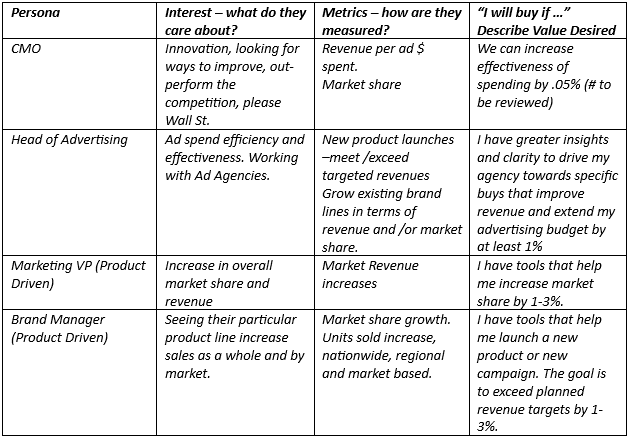
11. Consultative Questions
Continuing the tactical development of the sales play, you now want to equip the sales team with some ideas on the types of consultative question which will get the customer talking and illustrate that you have insight and value to offer. If you want to get even more granular, you can design different questions to ask each of the different persona.
Try to make these good consultative questions to ask a prospect during the qualification and discovery phases of the sales cycle. Here are some examples:
“How do you determine the effectiveness of your advertising spend right now?”
“How do you know whether people actually watch your ads or whether they switch channels when your ad appears?”
“What ability do you have to manage and direct the agency spending to improve the reach and success (ROI?)”
“How fast are you getting viewing information and analyses, and what advantages could real time data provide you?”
“How long does it take to get viewership information to identify successful, or even better, unsuccessful campaigns? So that you can respond, adapt and act upon that information?”
“What would it mean to you to be able to see exactly how many people watched each of your ads on different channels last night?”
“Would it be useful if you could measure how long people spent watching your ads?”
“What would it mean to you if you know the profile of people who actually watched your ads?”
“Would it be useful to identify which ads of your competitors were actually watched by your target audience/market? How would that help you?”
“How much could you save if you were able to improve advertising effectiveness by just 0.5%?”
“Targeted advertising, reaching specific audience means your dollars are spent on customers and potential customers to drive results/sales, how would the ability to identify device or platform where your ad was viewed help you target those customers?”
“How would localized viewership information help in that targeting and what value does that bring to the campaign process?”
“What tools do you use now to manage and direct your agencies? How much direction are you able to provide?”
“Other customers have told us that tools that offered them greater control really impacted their decision-making and direction. Do you feel you would see the same benefits?”
Probably your first reaction is ‘wow, that’s a long list’, and yes, that’s deliberate. I am trying to emphasize the fact that as you start your consultative selling journey, the more you can help your fellow salespeople to get comfortable asking a whole range of more consultative questions, the better you will be. And the faster you will see results.
12. Anticipated Objections and Responses
Although you have certainly picked a topic which is of interest to your target audience, that does not mean that they won’t have questions of their own. In this section you think ahead about what these questions and objections might be, and you provide a sample of a response which will help the entire sales team be better prepared for these meetings with customer (be they by phone or in person).
Again, think about presenting these in a simple tabular form of objection and response. For example:
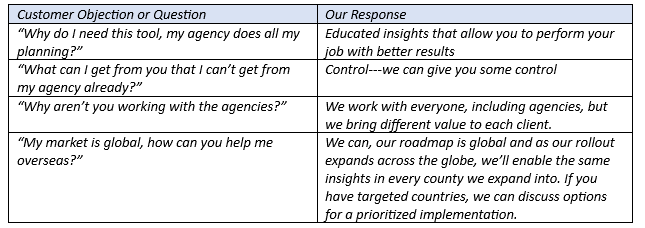
13. Competitive Analysis
In most cases you will be targeting a rich market where there are certain to be other players operating in the same market. Even if these are not direct competitors there will be other companies who are seeking to encourage the same customers to spend their budget on their solution, not yours.
You can provide an overview of the competitive landscape, but you can also provide a more detailed grid, in the form of a table, which will explain how your can differentiate yourselves from each competitor. Try to insert an overview of the key competitive players in the market. Highlight if there are regional variations and if different players operate in different industry segments.
Once again, we will address the whole topic of competitive strategy in more detail in a later module but you can start the analysis here and add to it as you develop your skills and strategy in this area.
Here’s an example, clearly you would use actual company names (rather than A, B and C):
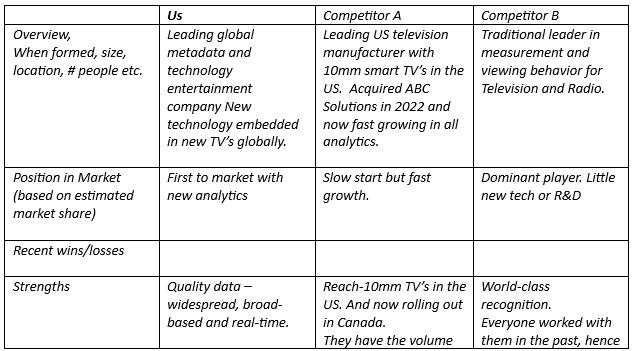
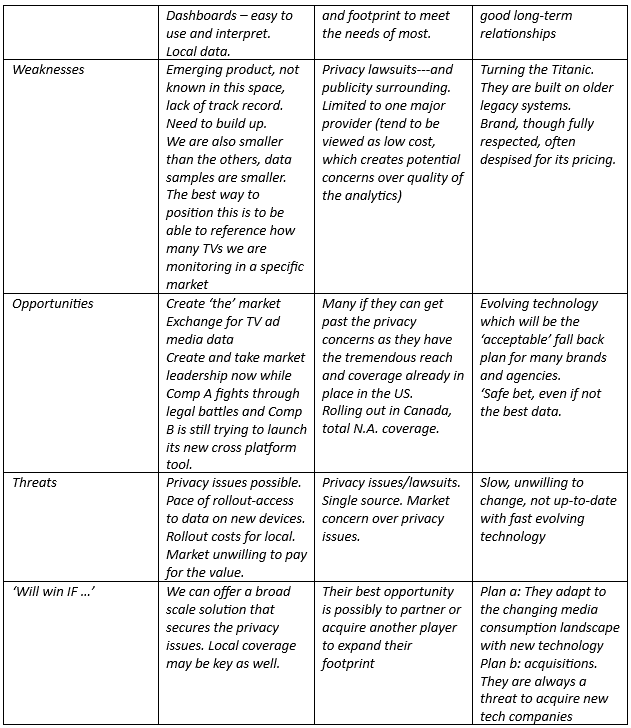
I would encourage you to try to develop a format like the above table using the headings in the column on the left. Although you may have to leave some sections blank to begin with, it will serve as an excellent aide memoire of what information you still need to acquire.
14. Additional Information Sources
Finally, you can provide any links to useful data, information articles and charts which can be useful in the sales play. This is particularly useful where there are market reports or other information which is too voluminous to include in the sales play itself. Rather than simply adding the links themselves, seek to explain why they might be useful and point the reader to the value they might contain for them. For example:
Links to some useful PowerPoint decks on market statistics:
Links to Statista and other sources to support the market data info:
Competitive analysis by Gartner:
HBR Harvard Business Review on recent trends in this market:
Based on the above, you should have a good idea of what each of these “Tactical Sales Plays” should look like. You can use this template to develop examples for your own company. Feel free to add and change the format if you wish. Try to include each of the headings described above. Once you have developed the first 1-2, you will find it much easier to add others in the future.

Exercise 1.10

Course Manual 11: Key Sales Metrics
These last 2 modules of this workshop focus on the use of sales metrics to measure improvement in sales performance and to provide a basis for incentives and rewards. As you embark on your Consultative Selling journey it is a good idea to define the results that you hope to achieve, both for yourself and for the rest of the company or team. You can use this module to help you determine which are the most important metrics to you as you seek to improve your sales skills and process.
Clearly the most common and often used measure of sales success is simply Sales Revenue. As we will see in the next module, this also correlates to the most common type of sales incentive, namely sales commission paid on gross sales revenue. In this module we will look at how you can finetune this metric and then consider other metrics which might provide a clearer picture of improvements in your selling skills and process. After all, I’m sure we have experienced situations in which a focus on sales revenue alone has caused problems for both salespeople and teams. In some cases, the result is a move towards ‘revenue at any cost’ which in turn leads to lower margins. In other cases, a focus on sales revenue alone can mask underlying issues.
We will start this section by focusing on Sales Revenue as our primary sales metric but before we dive into that specific metric, let’s consider what other metrics we might add, and then we can look more closely at each of these in turn:

We will also look at other, non-financial, behavioral metrics which might provide a more accurate metric associated with change management and training. For example:

Sales Revenue
There is probably not much we need to say here about measuring Sales Revenue. As we have said, this is the most common form of sales metric and for most companies is aligned with the fundamental metric which a Chief Revenue Officer or Head of Sales is measured on. However, once we dive into this minefield, we realize that there are many nuances that we need to consider rather than just the total revenue number. First you need to consider whether you are going to use this metric on a weekly, monthly, quarterly, or annual basis. Again, since it aligns with company reporting, a Quarterly metric is the most common, with a focus on monthly numbers to check on how we are tracking to our quarterly target. Then there is the question of trends: are there seasonal variations in customer purchasing behavior? Are there promotional efforts that align with specific seasons? How do these impact the target? What have been the trends in past years? How does this year compare to others? What is the impact of a decline in the economy or an expansion of market area?
How can you use this metric to improve your own sales performance? Start by focusing more on the details. You can use your CRM system to ‘slice and dice’ the data to reveal trends and other important sales information. For example, you might consider developing a report to look specifically at the revenue you have achieved from different products or services. This might point you towards the solutions which you are best at selling and where you might benefit from some help or coaching. You can look at trends over time by measuring the revenue from different customer, or different areas, over time.
Another aspect of measuring Sales Revenue is to focus on Growth % rather than simply the $$ revenue number. This then provides a metric of performance versus other players in the market. For example, if your sales revenue has increased by $1m year-on-year, at face value that might look great. But if $1m revenue growth corresponds to a 10% growth rate when the market as a whole is growing at 15% then it means you are losing market share and going backwards in relation to your competitors.
In using revenue as a measure, we should also consider the impact of the sales cycle. This is especially important when we consider sales ‘ramp time’ (i.e. the time it takes for a new sales executive to become productive). If there is a ramp-up period, does this include the length of the first sales cycle? If so, it might be more than 12 months before we know whether or not a new salesperson is tracking toward a successful on-boarding, or not.
For these, and many other reasons, it might be prudent to consider other sales metrics in addition to straight-forward Sales Revenue. Often, other departments in the company, such as marketing or Customer Success will argue, sometimes quite rightly, that the performance of the sales team is only partly responsible for the actual sales revenue number. Customer Renewals, for example, can have a huge impact on total revenue. In fact, in many SaaS based companies, the sales team is only measured and incentivized according to the initial year’s revenue from a multi-year contract. If I sell a $3m contract, payable monthly over a three-year period, should that be considered a $3m sale or a $1m sale? The answer almost certainly depends on the GAAP rules by which the company can count revenue and report new revenue.

Case Study – BT

When British Telecom implemented sales training program to improve the sales performance of their customer-facing staff they wanted to identify the effectiveness of the training. In this scenario, people would come to a BT retail store to pay their bills. The aim of the training was to increase the revenue from each of these customers as measured by an expansion in their business with BT. The revenue was important but so too was the ‘stickiness’ that BT could develop by getting customers to purchase additional services, beyond the basic service that they were buying initially.
BT therefore implemented measures to identify how many additional phone lines were sold during these transactions. The salespeople were credited with having created that increase in revenue. They also measured the uplift in revenue per month for people who paid their bills in store, versus those who paid online. Specifically they were looking to measure whether or not the people in the stores were more influential in growing revenue than would otherwise be the case.
There were those who said that the uplift was due to the marketing or promotional activity which was ongoing, and which could also have influenced the decision to buy. Therefore, BT then decided to specifically measure the sales of specific services which were not part of a current promotion, and which were only introduced during a conversation with a sales associate at the counter.
These metrics were relatively easy for BT to track because they had access to all customer data from a period before, during, and after, the training itself. As a result, they were able to continually raise the sales targets in line with performance and to demonstrate a very high ROI on the training which was being implemented.
Now let’s look at the metrics which are correlated to revenue, but not only focused on revenue itself:
Gross Margin
Many companies use Gross Margin as another key metric of sales effectiveness because it includes an element of profitability. Some companies will even make this a key metric for the entire sales organization. This raises the issue of sales incentives which will be covered in more detail in the next section. The important point is that you should develop specific metrics which will drive the behavior change that you want to see in a sales team. If you want to see exactly what benefit you contribute to the company, focus on gross margin, since this more accurately reflects the net benefit to the business.
Average discount rate
Some companies choose to add a metric which specifically looks at the level of discount offered by the sales team. Clearly this relates to profitability and gross margin too but it also helps to identify whether or not different salespeople are able to close deals at a price closer to the company stated price book, or whether they are offering discounts in order to close the business.
This metric can be market and product specific too. In other words, some products may be seen to be more commoditized and likely to be discounted whereas others may be expected to be more differentiated and therefore to retain value and result in lower levels of discount. How can you use this metric to improve your own sales performance? Benchmark yourself against your peers. Irrespective of the size of the order or the differences in the sales territory, you will be able to see whether you are performing well in terms of your ability to sell value to the customer.
Quota achievement %

In most cases, Sales Quota is related to revenue. The measure is effective in helping to create a more level playing field in which to measure the performance of different salespeople or teams. For example, a new-hire salesperson might have a lower quota than a more seasoned professional. The more experienced professional is expected to achieve more in terms of straight revenue. In other scenarios, the sales territories of different members of the sale team might be different and offer different potential in terms of revenue. In order to identify top performers, and to compare relative performance, sales leaders will look more closely at quota achievement as a key metric of performance. You can use this too to gauge where you fit in the performance league and to identify people from whom you might be able to seek help and advice.
Renewal Rate
As the subscription-based business model becomes more and more common, Renewal Rate becomes a key sales metric. It can be associated with measuring renewals as expressed as a percentage, or renewal revenue, which can provide a measure of ‘uplift’ or expansion. In some companies they use this measure alongside an ‘Attrition Rate’ i.e., the rate at which they are losing existing customers. There are clearly established industry norms in most sectors which help to define what constitutes a good renewal rate. Many companies target a renewal rate of at least 80%. In some cases, higher. With the old adage that it is always cheaper to keep an existing customer than to find a new one, companies are judged on their ability to get existing customers to renew their existing contracts. Renewal rate can also be a measure of success for a customer success or relationship management team. Some companies incentivize the salespeople on renewals, others do not reward salespeople for renewals income.
New business %
If renewal rates measure the performance of re-sale and ongoing customer success, a metric which focuses on the percentage of new business becomes a key metric for the ‘hunter’ sales teams as opposed to the ‘farmers’. Many companies use this simple analogy to describe the people in sales teams whose primary function is to go out and seek new opportunities, as opposed to those in the teams whose role it is to expand the business from customers which they already do business with.
In some cases, the metric is associated with a percentage of total revenue which comes from new customers and opposed to that which comes from existing customers. In other cases, new business is associated with ‘new logos’, meaning companies that we have not done business with previously. The key difference relates to differentiating between totally new business and new business which might be associated with an expansion of relationship into a new geographic area or a new product line or line-of-business. How can you use this metric to improve your own sales performance? You can think of this as a measure of how effective you are in building new relationships as opposed to maintaining existing ones. It is also a useful measure of your ‘land and expand’ strategy and may help you decide which type of sales role you are best suited to in the future
Increase in deal value
If the goal is to increase to average size of the deals which are closed, then you need a metric which specifically tracks this element. In other words, this is not simply about total revenue, but rather the average size of the sales which contribute to the total revenue number.
Many sales organizations will go so far as to segment their sales teams based on average deal size. Thereby not rewarding certain salespeople who sell a deal which is considered too small to justify their sales effort. This is becoming an increasingly important issue in the era of online sales and online buying. More and more companies are moving small ticket items to an online sales channel or a telesales team leaving the larger, more complex and more profitable deals to be closed by the more senior sales executives and account managers.
How can you use this metric to improve your own sales performance? Set yourself a challenge to gradually increase the average deal size of the sales that you close. In so doing you will start to focus on larger opportunities and will see how effective you are in closing these larger more complex deals.
Win rate
Sometimes referred to as the win:loss ratio, the win rate seeks to measure the effectiveness of the sales team in being able to close the sales opportunities or sales leads which they are presented with. It can also be used to measure the effectiveness of the marketing team or the sales development team in providing well-qualified leads. Clearly there are many, many variables which contribute to an overall win rate but again it can be a useful measure of the effectiveness of different teams in a company and it can provide very useful trend data to identify an improvement or a decline in sales performance. In a more sophisticated environment, the win rate can also measure the company’s performance versus specific competitors. It can also provide a good measure of the qualification skills of a sales team. Some companies will measure the win rate at different stages in the sales cycle and look for trends.
How can you use this metric to improve your own sales performance? It can provide a guideline as to why you are winning and why you are losing. For example, if salespeople are losing deals late in the sales cycle, it might indicate poor qualification skills, or it might highlight poor closing or poor negotiation skills. It is another useful benchmark to measure your own performance against that of your internal, or external competition.
Length of sales cycle

This metric seeks to measure how effective a salesperson is at moving an opportunity through the sales funnel. It can also measure the relative ease of closing business for different product lines or different markets. Otherwise known as ‘Deal Velocity’ it seeks to provide a measure of how effective a salesperson is at closing the deals which they are responsible for.
Clearly there are times when this metric is prone to manipulation by the sales teams. For example, some people might withhold information and not put a sales opportunity into the CRM system until they are confident of the sale. This distorts the real picture by making it appear as though the sales cycle is short. It also distorts the win:loss ratio by creating an artificially high win rate by excluding deals which never enter the sales funnel.
How can you use this metric to improve your own sales performance? Set yourself a target for improvement. Measure the length of the sales cycle for the last few years and set a target for next year. This metric is also a great way to see the effect of using a consistent sales process and using the tools such as call planners. Better call plans result in higher productivity because you achieve more in each meeting and thereby reduce the length of the sales cycle.
Forecast accuracy
As one of my sales leaders used to say, “predictability has its rewards, and unpredictability has its consequences”. There is nothing worse for any company than a sales team which is unable to accurately forecast sales revenue. Forecast accuracy is therefore becoming an increasingly important metric of sales success and salesforce effectiveness. Some salespeople find this hard to understand, and even harder to master. They assume that “all revenue is good revenue” and therefore hitting quota is the only thing that counts. Not true!
Sales professionals need to demonstrate that they are in control of their business, and this is best done by providing an accurate forecast. Clearly, missing a sales forecast by coming in too low is a major problem but over-performance causes its own problems too. Many sales leaders will be measured on their ability to improve the accuracy and reliability of their monthly and quarterly sales forecast. How can you use this metric to improve your own sales performance? Take a close look at what is causing you to miss your forecast. Are there trends you can identify, like losing sales late in the sales cycle? Or losing large deals? Is there a trend of losing to competition or losing to “No Decision Inc”. Perhaps this points t a greater need for more stringent qualification of opportunities?
Market Share
This metric is another way of looking at Sales Revenue by measuring the percentage of revenue which a company can get from their target market when compared to other players in the market. The lower the percentage market share, the greater the potential opportunity. Generally speaking, the greater the market share, the harder it becomes to expand that share. Many companies will use market share as a key metric because it is one of the few ways in which a company can benchmark its own sales performance against the performance of its competitors.
Share of Wallet
Share of wallet is different from market share. This measures the share of revenue that you attain from a specific customer as a percentage of the total amount that they could spend with you. Some customers will deliberately pursue a multi-vendor approach so as not to be dependent on any one player. This has increasingly become the case as a result of the supply chain challenges during the Covid epidemic. If there are no such concerns on the part of the customer, then the theoretical target can be 100%. In other words, your goal is to win all of the business within a specific account for the solutions that you sell.
Now let’s turn to the other, non-financial metrics of sales performance. These are metrics which relate to professionalism and sales behavior.
Quality of Planning
As we have learned, a professional sales team will follow a consistent process and will use a Sales Growth Playbook to define that process. This will include things like Territory Sales Plans, Account Plans, Sales Opportunity Plans, Consultative Sales Call Plans and so on. We will be explaining each of these in a later workshop, but it is worth noting here that we can use the quality and completion of these plans as a key measure of sales maturity and sales success. The first measure should always be focused on the Quality, rather than simply the Quantity of these plans. As we will see in many cases, “what you measure is what you get” when it comes to sales team behavior. Therefore, if you measure the volume of plans being used, you will get lots of plans, but the plans might not be very helpful. Better to include a measure of the quality of these plans. This is best done through some form of objective review – by management of by cross-functional team, even by peer review. As we will see, this can be combined with sales incentives to reward quality input.
Completion of Plans
Having said that we want to focus on quality, clearly having a simple metric associated with the number of plans being produced by each rep, or more likely a percentage completion rate, will provide a good metric for how well the team is buying into the sales process.
The main purpose here is to determine whether or not there is a correlation between the quality and volume of the use of the planning tools and the other sales metrics such as sales revenue and quota attainment.
Utilization of CRM tools
Much like the metrics above, it is increasingly simple to measure the extent to which individual salespeople and different sales teams are using the tools that they have been provided. Again, we are looking for trends and a correlation between the use of tools and sales success. Many salespeople will complain about the time that sales admin takes. This will always be the case but perhaps you will be able to identify the tools which the top-performers are using and compare that to the level of use by the underperforming folks. Perhaps this results in the removal of unproductive tools. More likely it results in a need for more education for some salespeople to make them aware of how to use the tools more effectively.
Reduced customer churn
This metric is effectively a measure of customer loyalty. Once again it is usually more important for a SaaS business or a company which uses a subscription-based business model. But it can be used by any company to measure the rate at which customers might decide to do business elsewhere. It can become a measure of customer longevity. The metric effectively points to the long-term health of the business in being able to retain existing customers by offering a good service and by continuously introducing relevant and valuable new solutions. As with some of the other measures, this metric is partly associated with the performance of the sales team in being able to sell new products and services, and partly a measure of success for the whole customer-facing team in being able provide a high-level of customer satisfaction and thereby encourage customer loyalty.
So as we can see, Sales Metrics can become an invaluable and essential part of your overall Sales Growth Playbook. Although we have tended to explain these from the perspective of overall sales performance and the health of the entire sales organization, each one of these metrics can be used by you individually to improve personal performance and help you to achieve your own sales goals.

Exercise 1.11

Course Manual 12: Incentives and Compensation
You get what you pay for!
As the final module in this workshop, we will take a look at how the different sales metrics can be used to create sales reward and compensation systems which are designed to help you to focus on the changes in skills and behavior which are likely to create more value for you personally and for your company.
One of the reasons that many people choose a career in sales is because there is a direct correlation between their own personal performance and how much they earn. The better they do their job, the more money they earn. So much so that in many cases, the top performing salesperson can be earning more than the CEO and the rest of the executive team. Sales Ops and Finance teams will look to strike a happy medium between providing the necessary incentives to motivate the sales team and not paying-out too much in commission so that the overall ‘cost-of-sales’ number does not go too high.
As we said earlier, there is an old adage that says, “what you measure is what you get” but in Sales it tends to be more like “what you pay is what you get”. In other words, as salespeople, we become adept at figuring out how we can make the most money, and we sell whatever will help us to achieve that goal. Hence companies ‘get what they pay for’ … meaning that the behavior they get from their sales teams is based on what they are paying their sales teams to focus on through the compensation plan.
Therefore, company sales incentives and compensation plans have a key role in helping to drive change and especially to change sales behavior. Let’s take a simple example: if a company wants to incentivize salespeople to find new business opportunities, they will simply change the commission structure to pay a higher sales commission on the sale of new business versus expanding the business from existing customers. Taken to an extreme, they can reduce commission on repeat business to almost zero, or in some cases, actually to zero. This simply forces, or incentivizes, the sales team to chase new business growth rather than ‘milking’ existing relationships.
Clearly sales incentives are closely linked to the Sales Metrics that we discussed in the previous module. That is why it is so important to focus on developing the right metrics to influence the change in behavior that you are looking to achieve. Let’s use an example to illustrate this point.

Case Study – Unisys

Unisys has a fascinating history. It was formed in 1986 by the merger of Sperry and Burroughs, but it’s roots go back much further. In 1873 they were the first company to introduce a typewriter with a QWERTY keyboard and five years later added the ability to use a SHIFT key to create CAPITAL letters. In the early part of the 20th century, they developed the first adding machines and in 1946 they introduced the most sophisticated and fastest computer in the world. Their UNIVAC systems provided the computing power for the Apollo space missions and they went on to be a leader in mainframe computer hardware. By 1986 the merger that created Unisys was the largest in history and it created the second largest computer company in the world.
But the world does not stand still, and the computer industry was undergoing a period of massive change and upheaval. The success of the large players, like IBM and Unisys, brought other players into the market. Rapid innovation saw hyper growth in computing power that could be achieved by smaller and smaller machines. In the space of a decade, the product margins on the large machines had declined to the point that the world’s computer giants had to change dramatically in order to survive.
The answer lay in the sale of services and expertise. The value proposition shifted from a perception of value based on the equipment, to value being in the expertise which Unisys had built up in implementing systems for companies around the world. Unisys needed to get their sales team to sell Services not just hardware. First, they communicated the need to change. Nothing happened. The sales teams kept selling hardware. Why was this?
The sales teams were still being incentivized to sell hardware. Their commission structure paid them handsomely for selling the ‘big iron’ computing systems and the Services component was a relatively small add-on which was often negotiated away for free in order to close the hardware deal. To demonstrate to the sales teams that the company was serious about the desire to transition to being a Services company, Unisys implemented a Consultative Selling training program and they dramatically changed the commission structure.
Sales teams were incentivized to sell Services and Solutions. Their commission reward structure on these sales far outweighed that for hardware. Since the hardware margins were declining, the company paid very little commission on hardware sales and paid high commission rates on the sales of services. Within 5 years the Services and Solutions business became the largest element of the company and has enabled Unisys to thrive through to today in an environment where most of their original hardware competitors have ceased to exist.
As a professional salesperson you have to assume that the company is deliberately incentivizing you to sell what they feel is most important. You should study the compensation plan and look for ways in which you can leverage that program to enhance your own income and thereby your company’s success.

The more commission a company pays, the more successful it will be. Sales commission is always a very small percentage of overall revenue. Therefore, it follows that for every dollar paid in commission, the company is earning many, many more dollars in revenue.
If your employer is providing higher rewards for new business, that is because they know that their future success depends on their ability to attract new customers and grow revenue. If your company uses gross margin as an element of your compensation plan, that is because they know that they have to grow their profitability in order to support their future growth plans. If they are paying you something for renewals of existing contracts, that is because the rate of renewal is a key metric which their investors are using to judge the value and long-term health of the business.
Base vs. variable mix
There is always a debate about the best mix of base salary and variable compensation in how a sales team is rewarded. Indeed, some companies do not pay commission at all. In these cases, the sales team is paid a base salary and may earn a bonus for exceptional sales performance. But this is rare. In most companies the mix of base salary to variable/commission income is somewhere between 50/50 and 80/20. The percentages are slightly artificial since they relate to a percentage of OTE (On Target Earnings). This means that the company will calculate what they believe is the appropriate OTE for a specific sales job. This number is based on things like Sales Territory, Deal Complexity, Seniority and is also related to market comparisons. Just as salespeople can, and do, compare their compensation plan to what they can earn elsewhere, so do companies benchmark their compensation plans against those of similar companies in the same market.
People are all different. Salespeople are all different too. Not all salespeople are motivated purely by financial reward. Sure, its always important, but there are other motivating factors too. Companies need to recognize these. As an individual salesperson you should also think about what you are motivated by. Other non-commission related motivators might include things like: Promotion, Recognition, Work-life balance, and Job security. Consider how these might influence your behavior.
Promotion
It is very common for companies to promote their best salespeople into management positions, only to find out that they were better salespeople than they are managers. As a result, the individual is less productive and overall company profitability declines. Conversely some people are highly motivated by the opportunity to move up the seniority ladder in a company and measure their success by the level they achieve within an organization. Ambition can be a key driver. If you are a sales manager, you should seek to recognize this in members of your team. If you are a sales professional, be open with your manager about your goals and ambition.
Managers will usually still earn commission, albeit at a different level, on the sales revenue of their teams. However, you can expect that as you move up the ladder in sales management, a higher percentage of your OTE will be based on a salaried, fixed amount and less on a variable or commission component.
Recognition

Many salespeople thrive on the kudos of having achieved a successful sale and they crave the recognition that comes from successfully closing a sale. Indeed, the ‘thrill of the chase’ is often what motivates a sales professional, and they yearn for the moment in the spotlight when their achievements are heralded across the whole team or the whole company.
Sales is hard. It’s a tough job. It can be lonely, and salespeople have to learn to ‘take the tough knocks’ of losing a sale and from the constant rejection of prospects saying ‘no’ to a meeting invite. For many people it is the recognition and reward that makes all this worth it. It means that you should find ways to recognize your own success and to celebrate the small victories along the way, as well as the large sale accomplishments. Good sales managers know the importance of this. They create opportunities for individual and team recognition. Everyone wants to be on a winning team and sometimes it is enough to know that, even though things might be going badly for you personally, other team members are achieving success, and this spurs people on.
Work-life balance
Many organizations are now talking more openly about ‘burn-out’. For salespeople, living in a high-pressure, challenging role, burnout comes as the result of the ongoing physical, mental and emotional stress which can result from several months or years of living in an environment in which you constantly have to ‘sell the next order’ in order to put food on the table. Even if a salesperson is successful in this role, burn out is a real risk. We should all be aware of this risk, both as individuals and as sales managers. We should also recognize that for many salespeople there is a plateau at which there are diminishing returns from the effort required to sell more and more to achieve marginal returns. Some ales people reach a level at which they are comfortable with their income and become more motivated by the reward that results from having a better home-life balance in which they get to spend more time with family and friends and devote more time to doing what they enjoy.
One of the benefits of having a sales role, especially in the modern work environment of working from home, is that salespeople are able to decide when they work and when they do not. So long as they are ‘making their numbers’ they can choose how they use any extra time that is offered. For some people, the answer if to work harder and earn more. For others it is to work less and enjoy life more.
At the end of the day, by following a well-defined and well executed sales process; by implementing this Sales Growth Playbook; you will be able to achieve more. ‘More’ might be more sales and more money. Or ‘more’ might be more time with your family. A recent study by Korn Ferry found that “Organizations that follow a consistent, methodical sales process have 27% higher win rates and 21% higher quota attainment”. That would seem like good motivation and encouragement to make this program work for you too!
Job security
As much as we all crave recognition, financial reward, and a sense of belonging, we all have a basic need to feel safe and secure. Job security is an important element of personal motivation. You can find all sorts of different views on what constitutes the 4 basic human needs, but they are essentially: Air, Water, Food and Shelter. Without these 4 things, we humans cannot survive. Our security, our need to feel safe, is a fundamental need. Feeling safe and secure at home is one thing, but salespeople need to feel safe in their jobs too. This is sometimes a challenge in an environment in which salespeople are only considered to be “as good as the last sale you made”.
If we look at what the author Stephen Covey considers to be our fundamental needs, he talks about our need “to live, to love, to learn, and to leave a legacy.” (See “the Eight Habit” by Stephen R. Covey). Sales success can give us everything we need to live a productive life. Sales success will mean that you love what you do for a living, and you will certainly to learning something new every day. The recognition that you achieve will provide some of the respect that may enable you to leave a legacy for others to admire and follow. Whatever it is that motivates you personally, try to find your focus and use that focus to spur yourself on the greater things, in the sales role and beyond.

Exercise 1.12
Project Studies
Participants will start to create their Sales Growth Playbook which will gradually build into their handbook and roadmap for success in growing revenue for themselves and for the company. During this first workshop you were introduced to the key elements of a Consultative Selling approach and introduced to the basic format for an effective Sales Growth Playbook. This Project Study is designed to enable you to apply the new process and skills to achieve a lasting change in process and behavior which will help you and your team to sustain the performance improvement long-term.
The project study, to be completed before the next workshop, is to finalize the framework for the Playbook and to complete the first sections as outlined below. Note that this is a Project Study which can be completed independently, with individuals working alone, or it can be completed as a team project, where the team decides to ‘divide and conquer’ and works collaboratively to produce one consistent Sales Growth Playbook. Both approaches will work, both have their own unique value, and a hybrid of the two is also feasible, in which some sections are consistent with a clear commonality and others may vary for each type of salesperson. For example, the sections on Company Overview can be the same for all, whereas Strategic Sales Plays and Tactical Sales Plays may vary by geography, and/or lines-of-business.
The structure of the modules within the first workshop provided opportunity for the participants to discuss some of this as a team and to determine whether or not they want to appoint a specific ‘owner’ as the key person responsible for creating that Chapter of the Playbook. Please note that this PLAYBOOK will continue to evolve over time. It is something which you will add-to throughout these monthly workshops. In some cases, we will add content or whole chapters later in the program (for example, we will have a whole workshop devoted to Buyer Personas and another to Value Propositions). These later workshops will provide the detailed content for that particular chapter in the Sales Growth Playbook.
Project Study (Part 1) – Sales Growth Playbook Structure
Firstly, participants need to define the structure of their playbook. This is essentially going to be a list of headings or Chapter Titles. Decide first whether your Playbook is going to be a physical document or an online resource. An online version has the advantage of being easily updated and easily shared with other team members. During the workshop we provided a sample structure. Now it is time for you to define your own version. Here were the suggestions:
INTRODUCTION
COMPANY OVERVIEW
SALES STRATEGY and PROCESS
GO-TO-MARKET STRATEGY
SALES PLAYS
BUYER PERSONAS
SALES TOOLS
KEY SALES METRICS AND COMPENSATION
Start by developing your own structure and then write the Introduction. Your introduction should explain:
• What is this Sales Growth Playbook?
• Why has it been developed?
• Who should use it? and When?
If you are developing this playbook individually, for your own benefit, think about what you want to get from the Playbook and how you will use it going forward. If you are working on this collaboratively, work as a team to decide who will be responsible for each Chapter and whether or not some chapters require a combined effort from 2-3 people working in small groups.
Project Study (Part 2) – Company Overview section
In this section of the Playbook your goal is to provide a clear and concise overview of the company as seem from the Sales perspective. Part Marketing/part Sales, this section should include the high-level description of the key elements which make your business special. For example, include things like:
• Relevant Company history – how should a salesperson tell the ‘Company Story’? What are the key elements of the story which will resonate with potential buyers and which create meaningful competitive differentiation?
• Sales team objectives, organization and structure – provide an overview of the Sales Org structure. Include third party channel partners and alliance if relevant.
• Sales Job Roles and Job Descriptions – include these to provide a clear definition of who is responsible for what within the sales organization.
Project Study (Part 3) – Sales Strategy and Process
In this section of the Playbook your goal is to define your strategy for winning more business. This may focus on New Business, or Renewal/Expansion, or both – depending on your goals and structure. Be sure to explain things like:
• Who you are, and why you are different
• Your Sales Process – develop and enhance the flow diagram which you will have started during the workshop. Fill-in any blanks and explain each stage in detail
• Value Propositions (by Segment, Job Title, Solution) – note you can leave this section blank for now, we will cover this in detail in a later workshop.
Project Study (Part 4) – Go-To-Market Strategy
This section of the Playbook should be a compilation of pre-existing Marketing material and Company Sales/Marketing Collateral. Note that an effective way to structure this chapter is simple to provide links to specific documents or to places on the company intranet where you can easily find this information when needed.
There is nothing worse than salespeople having to spend valuable time to find the right information when they need it., You might structure it by document type (PowerPoints, PDFs etc) or by purpose (Promotional materials, presentations, Proposals etc), Content is likely to include
• Products and services
• Messaging
• Pricing
• New products
• Pilots, Proofs of Concept, Proofs of Value
• Rules of Engagement for POCs and POVs
• How and when to engage with other departments
Project Study (Part 5) – Sales Plays
Your Sales Plays were discussed in detail during the workshop. Now you should define each play in detail, explaining how it should be implemented and the stages involved. Include references to any other departments which need to be involved and define key milestones so everyone understands how you will track progress. You should have clear descriptions of the actions required to implement your Strategic sales Plays which are things like:
• NEW BUSINESS
• RENEW
• EXPAND
You should also define a series of Tactical sales Plays which were explained in the workshop. Each of these requires some detailed work and this section is definitely one in which you may decide to allocate one tactical play for each person to develop so that together you have 10 plays to use in the future.
Project Study (Part 6) – Sales Metrics, Compensation, and Incentives
If you are acting individually, this section will focus on how you intend to measure your own sales growth plan and what goals (in terms of personal remuneration) that you want to achieve.
If you are managing a team, this section should address team goals and performance.
In both cases you need to start by completing the task which you began during in the workshop, namely, to define the key metrics beyond simple Sales Revenue. Then you need to determine whether or not the metrics are already available and if not, how you can go about creating these metrics. If they do not exist, you need to develop the metric, test the company’s ability to measure and report on this going forward, and establish a baseline performance. Some of this will take time and you may not be able to accomplish all of this within the first month but you should at least start the process to ensure the feasibility of measurement.
In some cases, particularly if you are ‘mid-year’. You may need to make recommendations for changes to the ‘comp plan’; which will hae to be agreed by management before the start of the next financial year.
Seek the help pf your manager and the Sales Ops team for this section. Most company CRM systems have the ability to develop these metrics and to create standardized reporting of results.
Program Benefits
Marketing
- Achieve quota
- Revenue growth
- Consultative selling
- Better strategy
- Market share
- Improved loyalty
- Shorter sales-cycles
- Market expansion
- Bigger deals
- Land and Expand
Management
- Hit targets
- Predictable growth
- Accurate forecasting
- Better image
- Increased valuation
- Customer satisfaction
- Team alignment
- Global growth
- International expansion
- Expand services
Human Resources
- Organizational alignment
- Consistent processes
- Sales training
- Employee development
- New-hire onboarding
- Achieve goals
- Faster ramp-up
- Employee satisfaction
- Training enablement
- Improved hiring
Client Telephone Conference (CTC)
If you have any questions or if you would like to arrange a Client Telephone Conference (CTC) to discuss this particular Unique Consulting Service Proposition (UCSP) in more detail, please CLICK HERE.











